









I am thrilled to be the new Dean of the Washkewicz College of Engineering. Thank you to everyone who has so warmly welcomed me to the city and to Cleveland State University.
CSU is a college dean’s dream. It is a place rich with history and all that comes with it.
While we have a storied past, we are not mired in our history, bound by rigid traditions and ossified dogma. CSU is a dynamic, forward-focused university, ripe with opportunity and energized to meet the demands of our region and nation. Some powerful tools we have at our disposal include:
• The University’s strategic plan CSU 2.0—a bold and ambitious plan for future growth
• CSU’s active engagement with, and support from, the surrounding community
• The Cleveland Innovation District, focused on building STEM talent for the future of Northeast Ohio
For almost 100 years, CSU and our College of Engineering have been growing, building, making history and changing lives— preparing for exactly this moment.
Some highlights from our past that make us who we are today include the following:
Fenn College pioneered cooperative education. It always sought to attract students who were hard-pressed to afford college by offering a low-cost, high-quality education. Nearly 100 years ago, in 1923, Fenn became only the fourth college in Ohio and one of the few in the country to adopt the cooperative education model. For people like alumnus Neil Rothman (see his story on page 44), the co-op model is what opens the door to a brighter future.
We’ve expanded our robust co-op tradition by incorporating more hands-on learning opportunities. The co-op model and hands-on learning are well suited to a school like CSU, dedicated to producing engineers ready for practice. As last spring’s valedictorian Caleb Palagyi puts it in the profile about him on page 26, the Washkewicz College of Engineering “gives you tools, shows you how to use them and engages you in using them to solve actual problems.” The Senior Design Symposium and Poster Competition story on page 30 describes some of the sophisticated hands-on projects our students tackled last year.
Fenn College of Engineering gave birth to the Order of the Engineer and the Obligation pledge. More than 50 years ago, 170 Fenn students and faculty took the first-ever Order of the Engineer oath and accepted the steel ring signifying membership in the society. Since then, more than half a million engineers from nearly 300 chapters have joined the Order and pledged to use their skills to protect the health, safety and welfare of the general public. The story on page 36 tells more about the Order and the 50th anniversary celebration last April.
The Washkewicz College of Engineering is building a “world that has never been,” and our new bachelor’s degree program in Data Science is Exhibit A. Extracting meaning and value from the massive quantities of raw data and information in our world means handling data sets so large and complex they cannot be processed with traditional methods. The story on page 40 describes our new Data Science program, and how we expect to meet the growing demand for data scientists.
We are breaking new ground in biomedical engineering. Associate Professor Geyou Ao recently won an NSF CAREER Award for her cutting-edge research in Boron Nitride Nanomaterials. Professor Ao is leading the way in advancing the world’s understanding of these new materials. The hybrids she and her team have formulated may revolutionize biomedicine and biotechnology. Her compelling story is on page 12.
CSU has pledged to graduate 10,000 new students in STEMrelated fields over the next 10 years as part of our commitment to the JobsOhio-funded Cleveland Innovation District. The University’s role in this exciting $565 million initiative is to recruit, educate and graduate the skilled talent needed to fuel growth in health care, emerging technologies and data-intensive fields. The Washkewicz College of Engineering is key to helping the University fulfill its pledge. Our efforts are now aimed squarely at defining the steps our college will take to help CSU achieve this ambitious growth.
Sir Isaac Newton said, “If I have seen farther it is by standing on the shoulders of giants.” Previous generations of students, faculty, administrators and leaders in our college have laid a firm foundation from which we now embrace the challenges of the future. Thanks to those “giants” of our history, we are creating a clear, compelling vision for the future of the Washkewicz College of Engineering—and that future looks very bright indeed.
RICHARD T. SCHOEPHOERSTER, PH.D. Dean and Professor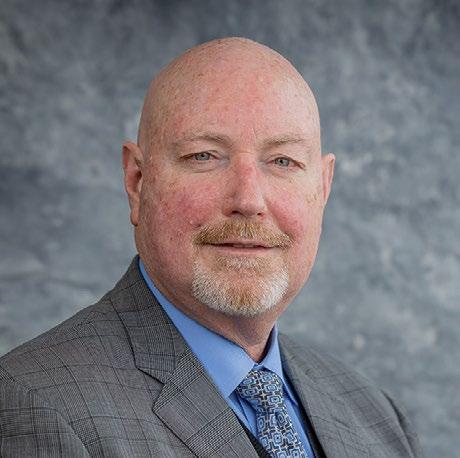
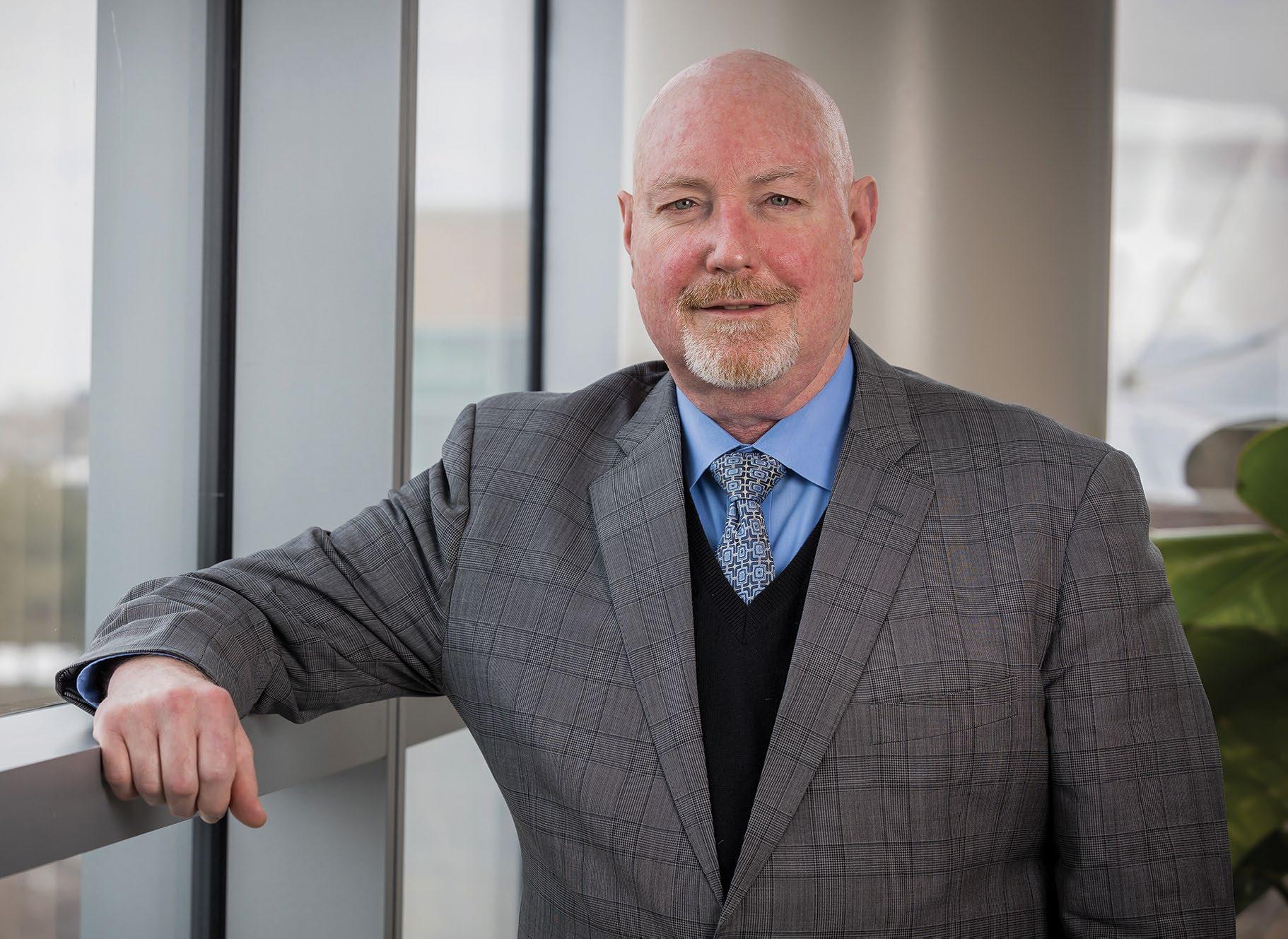


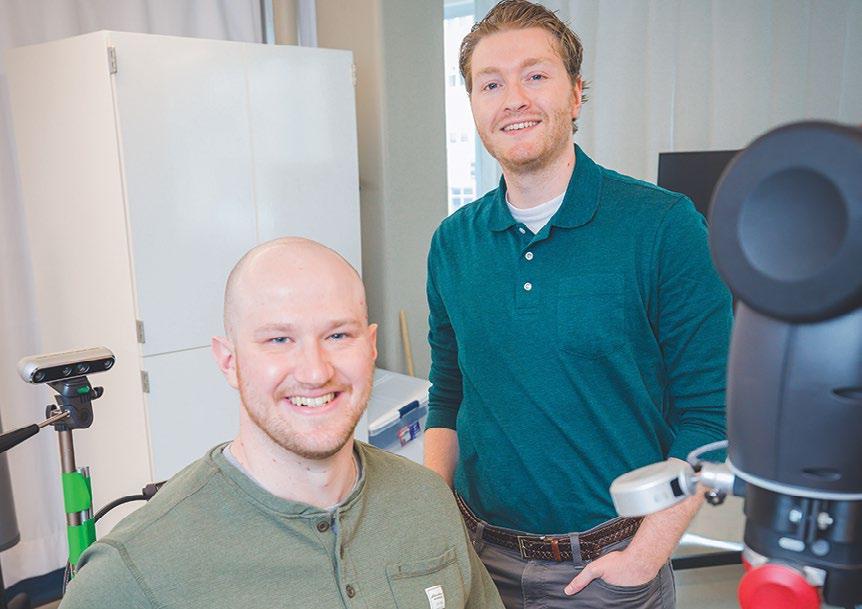

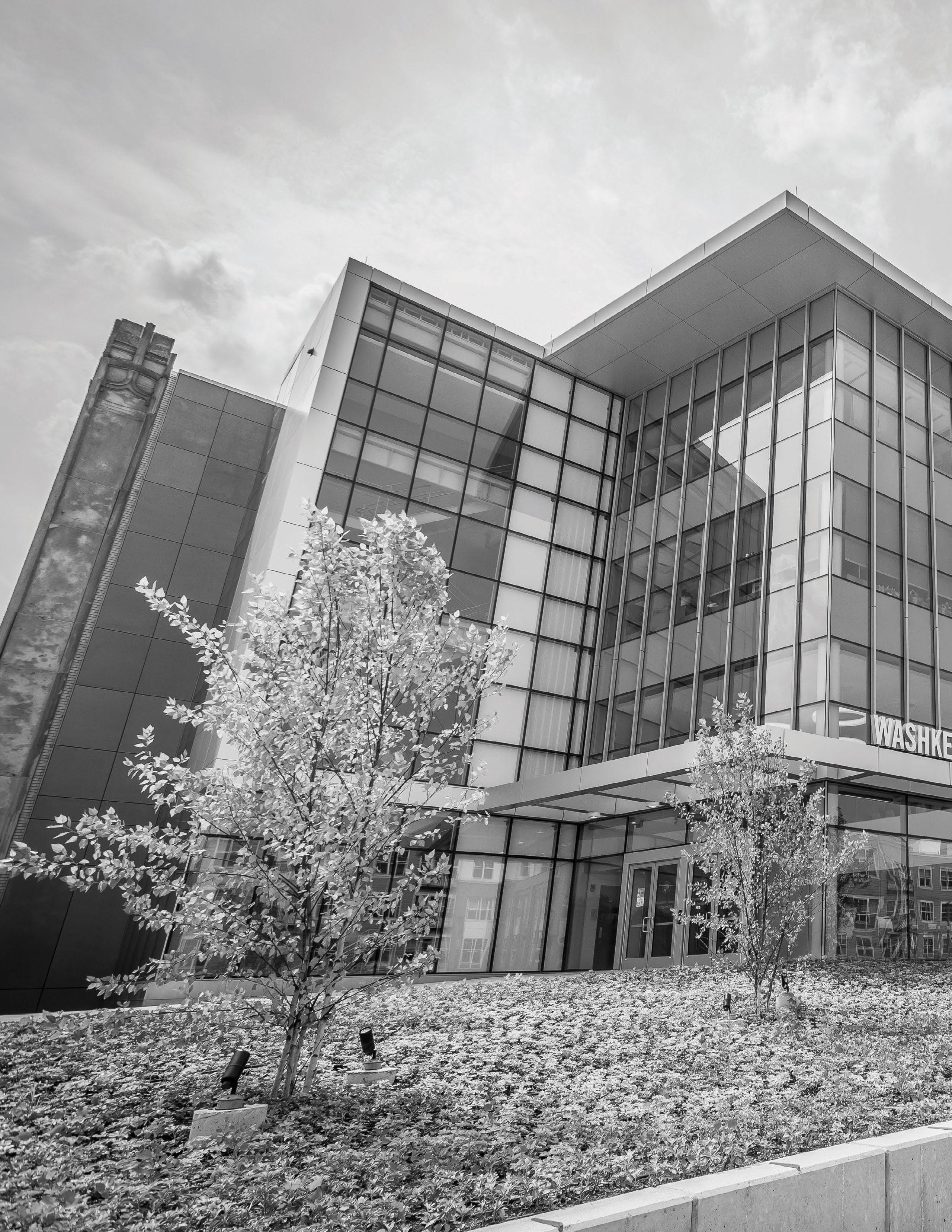
Sun "Sunnie"
Chung, Ph.D. ASSOCIATE PROFESSOR OF PRACTICE DEPARTMENT OF ELECTRICAL ENGINEERING AND COMPUTER SCIENCEDr. Chung joined CSU in 2015 as an Associate College Lecturer in the Department of Electrical Engineering and Computer Science (EECS). She was appointed to Associate Professor of Practice in August.

Chung leads the Big Data Lab at CSU and helped establish the Internet of Things Collaborative (IoT) between CSU and Case Western Reserve University. She has received seed funding to perform research in IoT, and has helped CSU become an important part of the local big-data community by organizing workshops on big data over the last several years. Attendees and presenters have come from local industry, universities and industrial research groups from as far away as Silicon Valley.
Chung came to CSU with significant experience in industrial research labs in Silicon Valley, specifically Teradata Corp. (formerly a division of AT&T) and NCR (currently part of IBM), where she performed optimization of big data analytic systems. Chung’s research interests include Big Data Analytics, Data Science, Text Analytics with Natural Language Processing (NLP), Question-Answering System (AI), Machine Learning-Based Intrusion Detection Systems, Cyber Security and Privacy of Cloud-Based Big Data with Deep Learning Systems and Optimization of Massively Parallel Big Data Processing Systems. Chung earned her Ph.D. at Case Western Reserve University.
We are excited to welcome several new faculty members in the college this year. They bring added expertise in a variety of areas, including big data, internet of things (IoT), machine learning, deep learning, data mining, artificial intelligence (AI), cybersecurity, cyber-physical systems and computer vision.Andrew S. Hess ASSISTANT COLLEGE LECTURER DEPARTMENT OF ENGINEERING TECHNOLOGY
Andrew Hess was appointed Assistant College Lecturer in the Engineering Technology Department in August 2021, after having served as Visiting Assistant College Lecturer since 2019. He is a certified SolidWorks Expert with experience teaching static and dynamic mechanics, thermodynamics, strength of materials, mechanics of materials, and design of machine components, among other topics.
Hess is a former commercial airline pilot and is a certified flight instructor. He has worked as an engineering consultant with Thoth Enterprises in Miami, Florida and with Mechanical Vibration Innovations in Cleveland.
Hess earned his Bachelor of Mechanical Engineering and his M.S. in Mechanical Engineering at CSU. He graduated Magna Cum Laude from the 4+1 program. He also earned a B.S. in Aerospace Studies at Embry-Riddle Aeronautical University in Prescott, Arizona. Hess is a member of the national engineering honor society Tau Beta Pi.
Jackie Woldering, Ph.D. ASSISTANT PROFESSOR OF PRACTICE DEPARTMENT OF ELECTRICAL ENGINEERING AND COMPUTER SCIENCEDr. Jackie Woldering was appointed Assistant Professor of Practice in Computer Science in August, after previously serving as Visiting Assistant College Lecturer in the EECS Department.

Woldering joined Cleveland State University in 1995 as an Adjunct Lecturer in Computer Science. Throughout her tenure at CSU, Woldering has served in a number of capacities including Linux Computer System Administrator, Visiting Instructor, Adjunct Lecturer, and Computer Lab Coordinator in the Monte Ahuja College of Business.
Before coming to Cleveland State, Woldering taught Analysis of Algorithms, Logic Design and Computer Organization and Digital Design Laboratory at Case Western Reserve University.
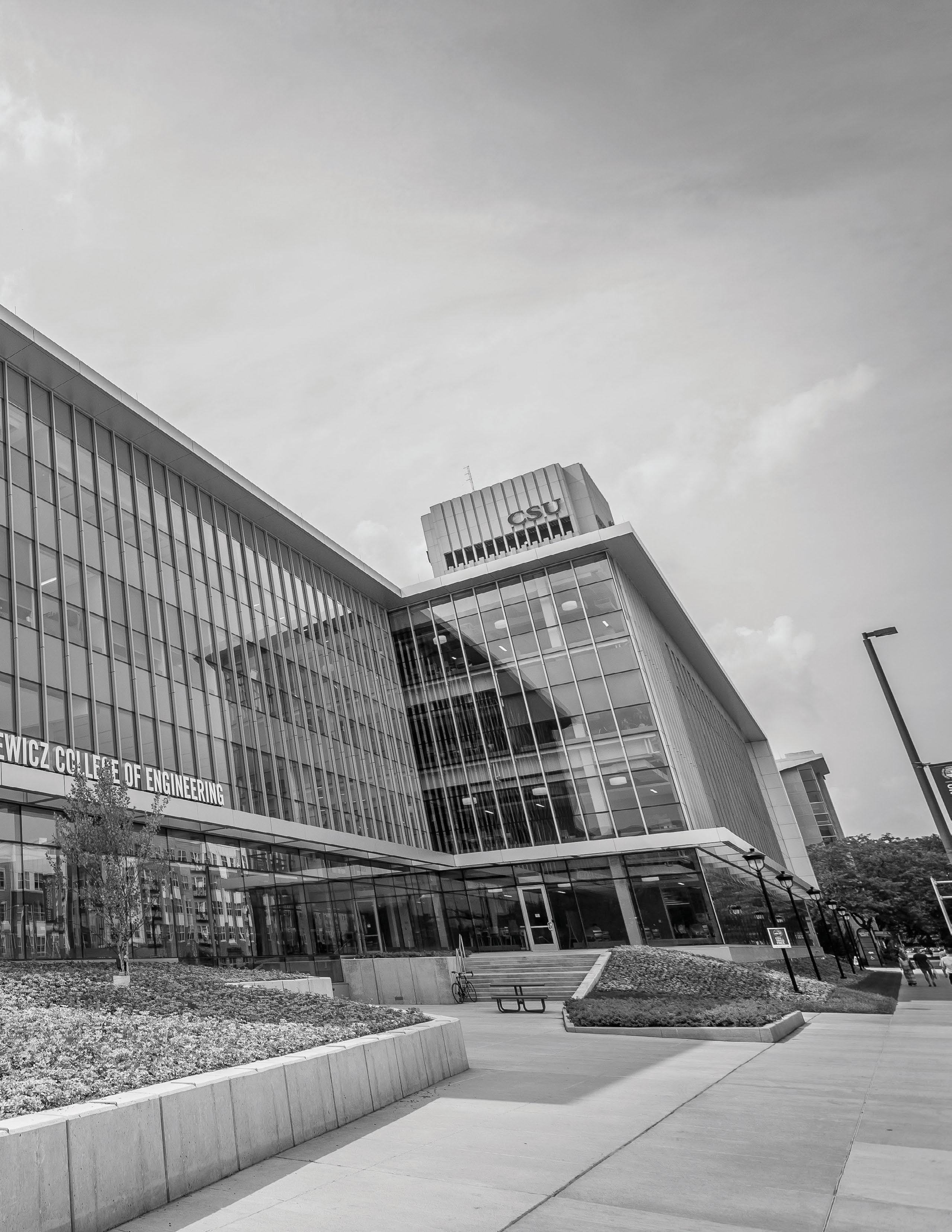
In addition to her teaching responsibilities, Woldering has been the owner and chief consultant for Woldering Computer Services since 1985, offering a range of customer support services such as purchasing, assembling, testing, installing, maintaining, troubleshooting and repairing microcomputer systems and peripherals. She also served as vice president of Montour Computer Systems in Euclid, Ohio, for 10 years.
Her research interests include operating systems, assembly language, networking, computer architecture, embedded systems, robotics and FPGAs.
Woldering earned a 2000-hour degree in Electrical Engineering Technology at the Erie Institute of Technology before earning her B.S. and M.S. in Computer and Information Science at Cleveland State University. She earned her Ph.D. in Computer Engineering at Case Western Reserve University.
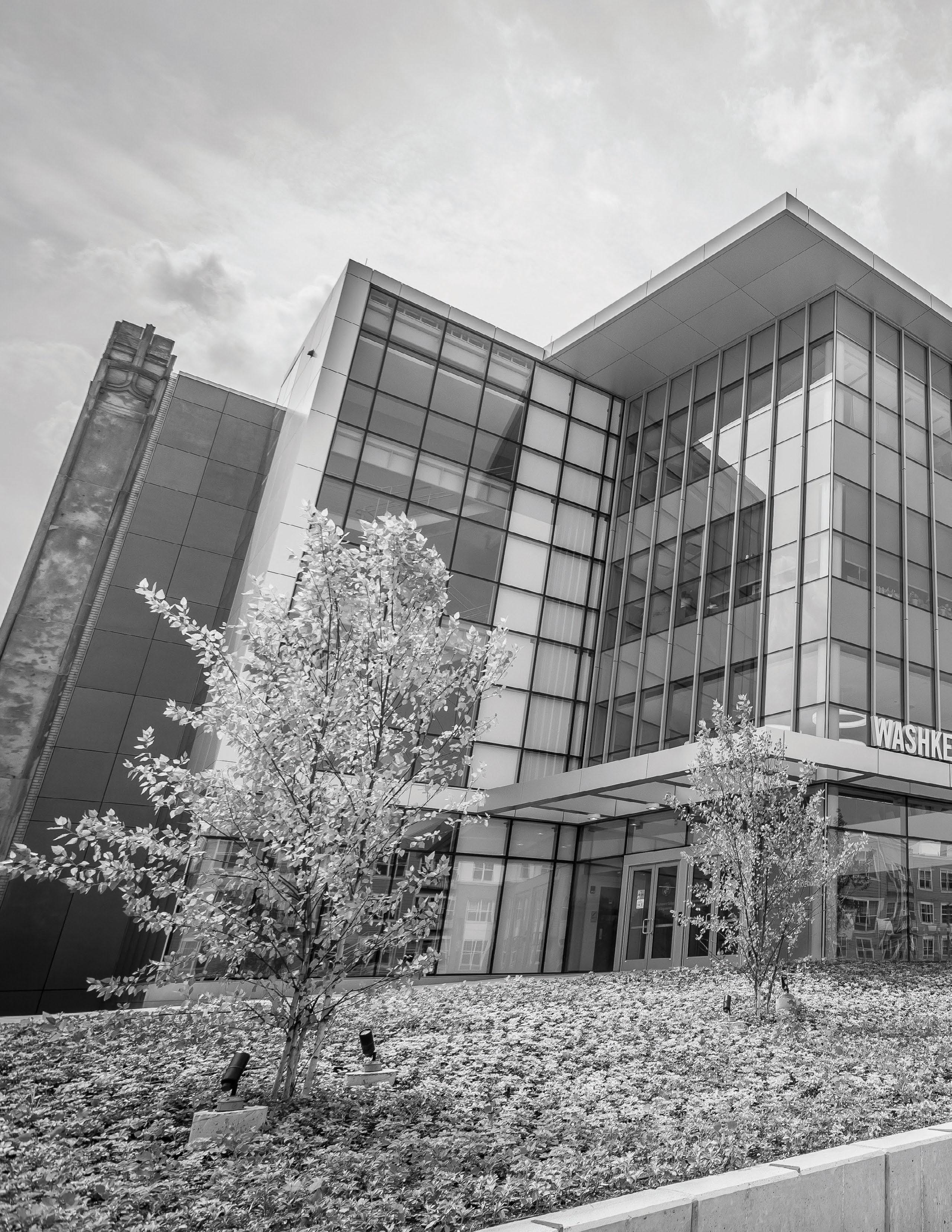
Dr. Qin Lin joined the EECS Department as Assistant Professor in January 2022, after having completed his post-doctoral work at the Carnegie Mellon Robotics Institute.
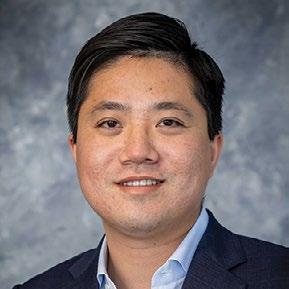
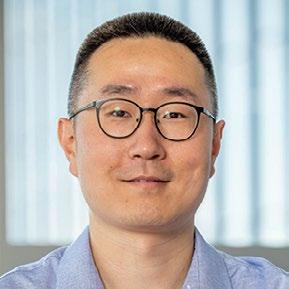
Lin’s research interests include Motion Planning, Control, Autonomous Systems, Robotics, Machine Learning and Verification. He focuses particularly on the intersection of machine learning, control theory, and formal verification, with the goal of enhancing security and safety of safety-critical cyber-physical systems (CPS) deployed in dynamic, uncertain and adversarial environments.
Lin develops explainable and verifiable machine learning-based intrusion detection algorithms to protect industrial control systems, such as water treatment plants, from cyberattacks. He also rigorously verifies safety properties of learning-enabled components and develops safety-guaranteed planning and control algorithms for autonomous driving systems.
Lin earned his Ph.D. in Computer Science at Delft University of Technology in the Netherlands. He earned his M.S. in Control Science and Control Engineering at Tongji University in Shanghai, China, and a B.Eng. (Bachelor of Engineering) in Automation at Hefei University of Technology in Hefei, Anhui Province, China.
Liqun Ning, Ph.D.
ASSISTANT PROFESSOR DEPARTMENT OF MECHANICAL ENGINEERING
Dr. Liqun Ning joined the Department of Mechanical Engineering as Assistant Professor in August 2022 after completing a postdoctoral fellowship at the Georgia Institute of Technology and the Emory University School of Medicine. His research there focused on biomedical engineering and 3-D bioprinting—specifically, integrating advanced biomanufacturing, materials/biomaterials, cell/stem cell techniques and dynamic perfusion technology to engineer biomedical constructs, devices and platforms with high tunability and biomimicry for regenerative medicine and human disease modeling.
Before conducting his postdoctoral work in Georgia, Ning was a postdoctoral Fellow at the University of Saskatchewan in Saskatoon, SK, Canada, where he investigated the properties and applications of hydrogel bioprinting.
While earning his Ph.D. in Mechanical Engineering at the University of Saskatchewan, Ning researched and developed a hydrogel composition and 3-D printing approaches to engineer highly reproducible and biocompatible cell-laden tissue scaffolds that later became the subject of more of his research.
Ning earned his M.Sc. in Mechanical Engineering and his B.Eng. in Mechanical Engineering at Northwestern Polytechnical University in Xi’an, China.
Dr. Sujan Poudyal joined the EECS Department as Assistant College Lecturer in August 2021. His research focuses on the areas of Deep Learning (Convolutional Neural Network and Autoencoders), Artificial Intelligence, Machine Learning and Data Visualization.
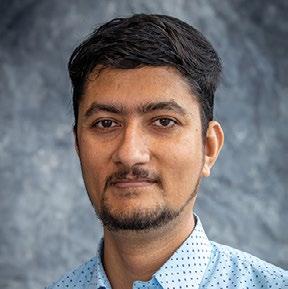
Poudyal earned his Ph.D. in Electrical and Computer Engineering at Mississippi State University in Starkville, Mississippi. He taught graduate courses at Mississippi State and also served as Lecturer at Kantipur Engineering College in Lalitpur, Nepal.
He earned his B.E. in Electronics and Communication Engineering at Tribhuvan University in Kathmandu, Nepal. He has contributed to a number of peerreviewed articles and publications exploring Educational Data Mining.
Poudyal teaches CIS 545 Architecture and Operating Systems, CIS 480 Computer Architecture, CIS 475 Computer Security and CIS 580 Introduction to Computer Architecture.
Mustafa Usta, Ph.D. ASSISTANT PROFESSOR DEPARTMENT OF MECHANICAL ENGINEERINGAssistant Professor Dr. Mustafa Usta joined the Mechanical Engineering Department in August 2021 after completing postdoctoral work at the Georgia Institute of Technology in Atlanta, Georgia. His focus there was on computational, experimental and data-driven investigation of complex flows.
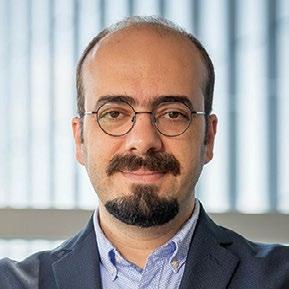
Usta applies machine learning, graph theory, computational and experimental methods to problems at the interface of fluid dynamics, biology, chemistry and thermal sciences. He focuses on high-fidelity modeling of large-scale, multiphase, multiphysics and multiscale problems relevant to the environment, energy, health and robotics.
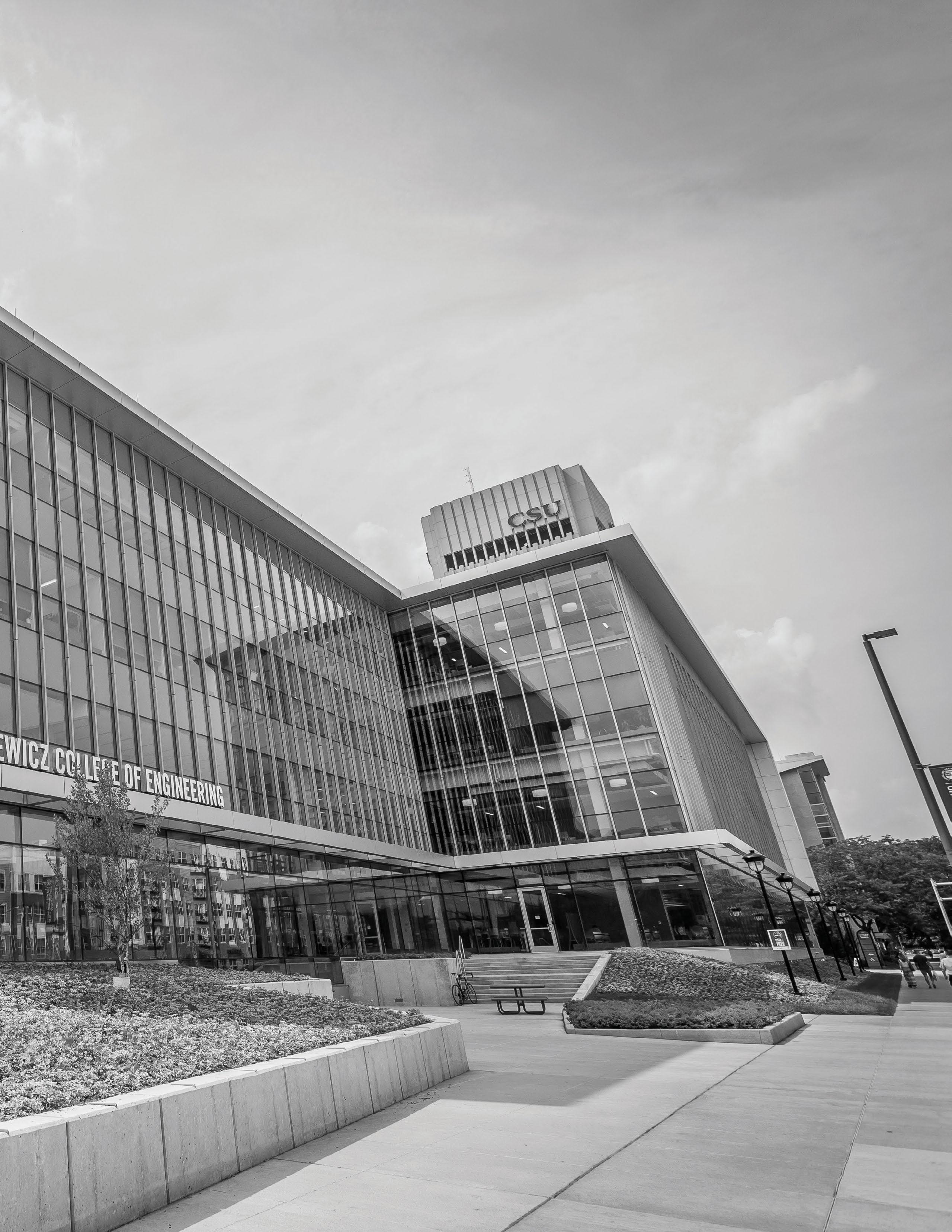
He earned his Ph.D. at Lehigh University in Bethlehem, Pennsylvania, and wrote his dissertation on Desalination by Reverse Osmosis and Membrane Distillation. Usta also earned his M.S. in Mechanical Engineering at Lehigh University. He earned his B.S. in Mechanical Engineering at Yildiz Technical University in Istanbul, Turkey.
Usta has authored a host of peer-reviewed journal papers, peer-reviewed conference papers and conference talks. He has helped secure more than $4 million in competitive grants and more than 26 million CPU-hours from NSF-funded high-performance computing centers. He co-founded an industry-funded consortium and has collaborated with research groups from all over the world, including Sandia National Labs, the Research Institute of Sweden, and King Abdullah University of Science and Technology in Saudi Arabia.
Tisha Barnes was promoted to Administrative Assistant for the Engineering Technology Department consisting of the undergraduate programs of Electronics Engineering Technology and Mechanical Engineering Technology.
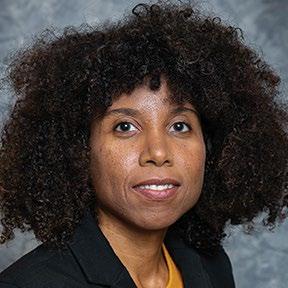
In addition, she provides administrative support for the Senior Design Program. She joined CSU in November 2015. Barnes is a CSU Alum, and earned a Bachelor of Arts in Economic Development.
Angela Benton-Smith, B.S., M.B.A. PROGRAM MANAGER ENGINEERING DIVERSITY WASHKEWICZ COLLEGE OF ENGINEERING
Angela Benton-Smith was recently promoted to Program Manager of Engineering Diversity after having served as coordinator for special programs for the Engineering Co-op Program. She earned a Bachelor of Science in Physics from Spelman College; a Bachelor of Science in Electrical Engineering from Georgia Institute of Technology; and a master’s degree in Business Administration from Clark Atlanta University.
Her noteworthy career includes working as a project engineer for LTV Steel, interim director for community services for Spelman College and coordinator for the Washington Bridge to Spelman Program. Most recently, she served as the facility coordinator for the Center for Experiential and Service Learning at Hawken School in Gates Mills.
Carol Terrell ADMINISTRATIVE ASSISTANT DEPARTMENT OF MECHANICAL ENGINEERING
Carol Terrell was promoted to Administrative Assistant for the Mechanical Engineering Department. She joined CSU in April 2014. Before this, she worked at Case Western Reserve University in various capacities including student service specialist in the Mandel
School of Applied Social Science, among others. Of note, Terrell worked with CSU earlier in her career in the University Registrar's Office, seeing it grow from punch cards to touch screens. She attended Cuyahoga and Lakeland Community Colleges.

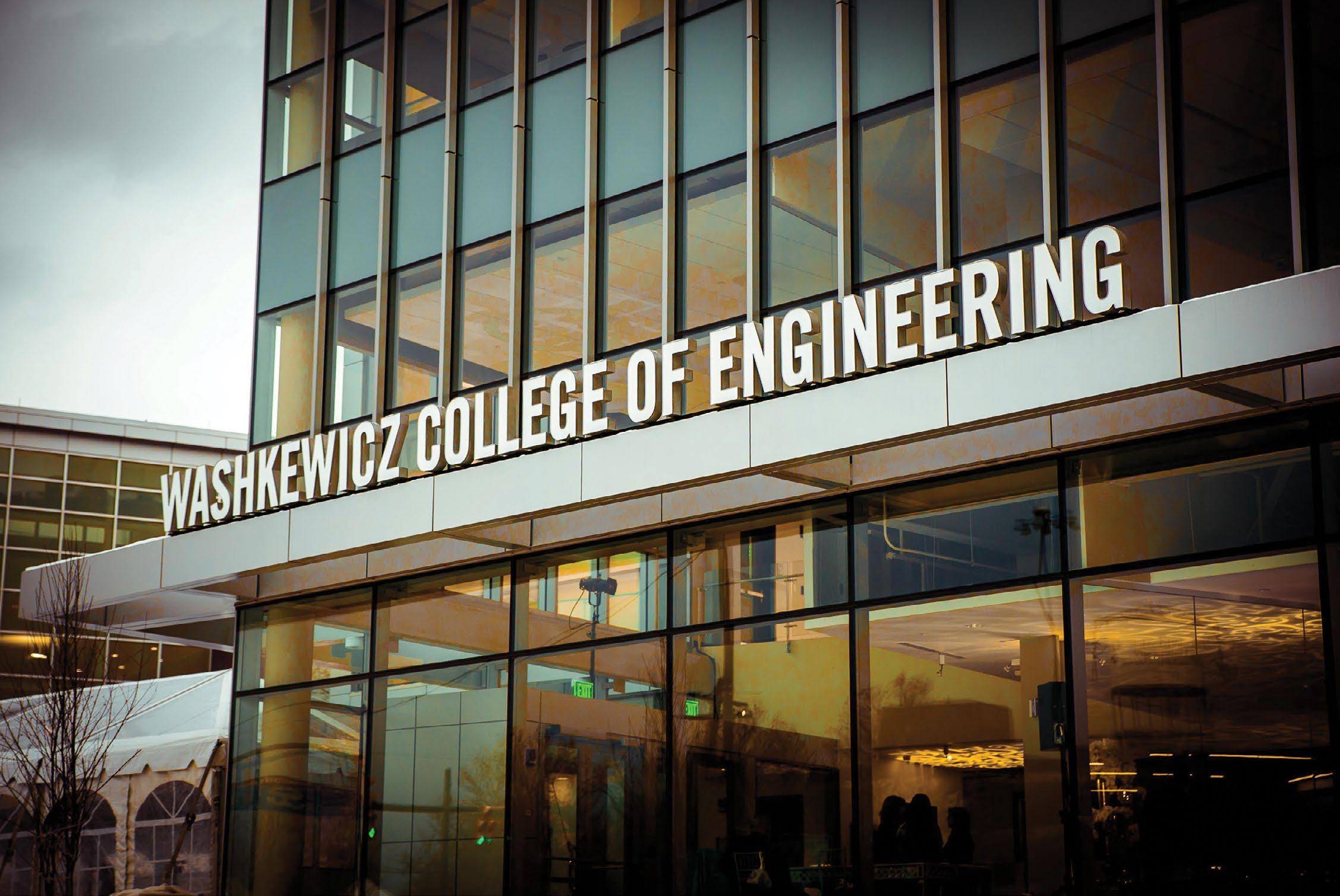

Audrey M. Wiggins was recently promoted to Communications Coordinator for the college, where she has served for over eight years. She brought her creativity to CSU 15 years ago as part of the Jack, Joseph and Morton Mandel Honors College, Levin College of Public Affairs and Education, and College of Arts and Sciences. Her previous experience includes GE (General Electric) Energy as customer service representative, the Warrensville Heights Area Chamber of Commerce as executive director,
and the American Heart Association. Wiggins earned a B.A. in Communications with an Advanced Emphasis in Business, Concentrated in Marketing from Baldwin Wallace University. She holds micro-credentials in applied web design, leadership excellence, training and development, digital marketing, and social media from the Monte Ahuja College of Business to name a few. Audrey loves music and plants and is the third of four generations of Audrey’s in her family.

Jamella Ballard joined CSU in July 2022 with the Mechanical Engineering Department as Special Programs Coordinator, supporting the Center for Human-Machine Systems graduate program and summer graduate research program in rehabilitation engineering. She manages the annual budget, as well as works in the Department of Psychology. She holds a B.A. in Business Management from Ursuline College. Prior to coming to CSU, Ballard worked as a talent advisor/coordinator for Kelly Services at Case Western Reserve University. Her career and professional experience include working at NASA Glenn Research Center as an internship project coordinator (contractor).

Claude Brown joined the college as an Administrative Assistant in June 2022. His responsibilities include support of student success/ advising for the college. He also coordinates student employment and purchasing processes for the departments. He worked for five years at Cleveland Clinic as a Health Unit Coordinator on a Heart and Lung Transplant Unit. Brown loves to travel and looks forward to completing his B.A. in Psychology spring semester 2023.
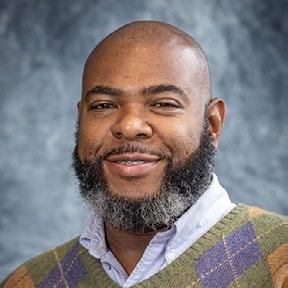 Megan Huggins, M.S. GRADUATE ADVISOR
Megan Huggins, M.S. GRADUATE ADVISOR


Megan Huggins joined the Electrical Engineering and Computer Science Department as Graduate Advisor for the Master of Computer Science (MCS) program where she advises MCS students on all aspects of their studies as well as managing the systems needs of the program. Huggins is a dual Australian/American citizen who worked in corporate psychology and as a registered nurse before joining CSU. Huggins holds an M.S. degree from The University of Sydney.
Stephanie McLeod joined the Chemical and Biomedical Engineering Department as Administrative Assistant. She earned an associate degree in Medical Administrative Assisting from Bryant & Stratton College and is also a trained Combat Medic for the Army National Guard. Before coming to CSU, McLeod worked as a client benefits coordinator at the Cleveland Sight Center where she helped blind and low vision clients obtain funding for vision rehabilitation services, equipment and low vision exams.
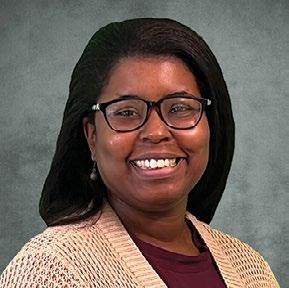


Tiffany Murrell joined the college as Academic Advisor. She works directly with international students and students who are a part of the Mechanical Engineering Technology and Electronics Engineering Technology, Pre-Engineering and Computer Science programs. Murrell has a passion for higher education and student success and enjoys teaching the New Student Orientation course for engineering students. She was born in a small town in West Virginia where she always dreamed of helping others and making a difference. She enjoys traveling, “loving on” her family and friends, and working on her personal goals to make sure she continues to grow. Before coming to CSU Murrell was employed as a recruiter for the Eastern Campus of Cuyahoga Community College. She completed her associate degree in Business at Cuyahoga Community College, then earned her B.S.W. and M.S.W. in Social Work at CSU in addition to completing 25+ credits under the master’s degree in education. Murrell is a true advocate for student achievement. She goes beyond her call of duty within the office and makes sure to let students know she is there to help.
Bradyn Shively joined the college Bradyn as an Academic Advisor. He advises Computer Science, Computer Engineering, Data Science, and Electrical Engineering students. Shively earned a master's in Counseling from Walsh University. Prior to entering the graduate program at Walsh, he earned a bachelor's in Psychology with a minor in English from Kent State University. Prior to coming to CSU, he was the outreach program coordinator for the Crisis, Advocacy, Resources, Education and Support (CARES) Center at Kent State University. Before that, he was a professional academic advisor at Walsh University.

Imagine a sheet of chicken wire on a nano scale, just one atom thick, with the hexagonal latticework made of alternating boron and nitrogen atoms. That, in the simplest terms, is a boron nitride (BN) nanosheet.
Now imagine the sheet rolled into a hollow cylinder with a diameter 10,000 times smaller than that of a single human hair, and you’ll have a mental picture of a boron nitride nanotube, or BNNT.
Take that mental image one step further with a genius move: decorate the boron nitride latticework with synthetic polymers containing carbohydrates called glycopolymers. The result is a glyconanomaterial hybrid that just might revolutionize biomedicine and biotechnology. These hybrid nanomaterials are the focus of Assistant Professor Dr. Geyou Ao’s five-year, $609,147 NSF CAREER Award.
Boron nitride nanomaterials only became commercially available in 2014, so research in the field represents truly cutting-edge science. Ao (“Augyu” to her colleagues) believes she is the first scientist to use glycopolymers to functionalize boron nitride nanotubes. “No one else I know of,” she says, “is working on this. I'm hoping that this NSF CAREER funding will enable me to be a leader in boron nitride nanomaterials research.”
Ao, who joined the Washkewicz College of Engineering Department of Chemical and Biomedical Engineering in 2016, was ideally situated to get in on the ground floor of BNNT research. Before coming to CSU, she studied carbon nanotubes (CNTs), the structural cousins of boron nitride nanotubes, for her postdoctoral work at the National Institute of Standards and Technology in Gaithersburg, Maryland. Her lab was the world leader in carbon nanotube sorting, and while there, she developed connections with the people who first commercialized BN materials in the United States. “I really used that background,” she says, “and jumped into this new material.”
“I'm hoping that this NSF CAREER funding will enable me to be a leader in boron nitride nanomaterials research.”
—Dr. Geyou Ao
Discovered in 1995, BNNTs were quickly hailed as the most promising materials in nanotechnology, thanks to their unique physical and chemical properties. More thermally and chemically stable than CNTs, they are about 100 times stronger than steel and 50 times stronger than industrialgrade carbon fiber.
BNNTs that can withstand temperatures of up to 900 degrees centigrade (compared to 400 degrees C for CNTs), are excellent thermal conductors (comparable to or greater than copper) while being electrical insulators (CNTs are electrical conductors). BNNTs are also capable of absorbing radiation.
Creating carbohydratedecorated BNNTs opens a vast array of intriguing possibilities. Because carbohydrates are present on every living cell, and because they mediate cellular events such as immune responses and infections, nanomaterials with carbohydrate functionalities can potentially be used for a host of
anti-microbial and pathogen-sensing applications against a broad spectrum of bacteria, viruses and fungi.
Ao believes that better understanding the properties of BN-based glyconanomaterials may make it possible to develop such things as anti-microbial paints for hospital surfaces; anti-infection and antirejection coatings on implantable medical devices; pathogen-sensing tests for home use (as in self-administered COVID-19 tests) and contamination sensors for commercial use (as in the food processing industry). It may also lead to the development of targeted drug therapies.
Washkewicz College of Engineering Dean Richard Schoephoerster, himself a specialist in biomedical engineering, calls Ao’s research “exciting work that will impact our fundamental knowledge of glyconanomaterials, and may result in biotechnology that saves lives someday.”
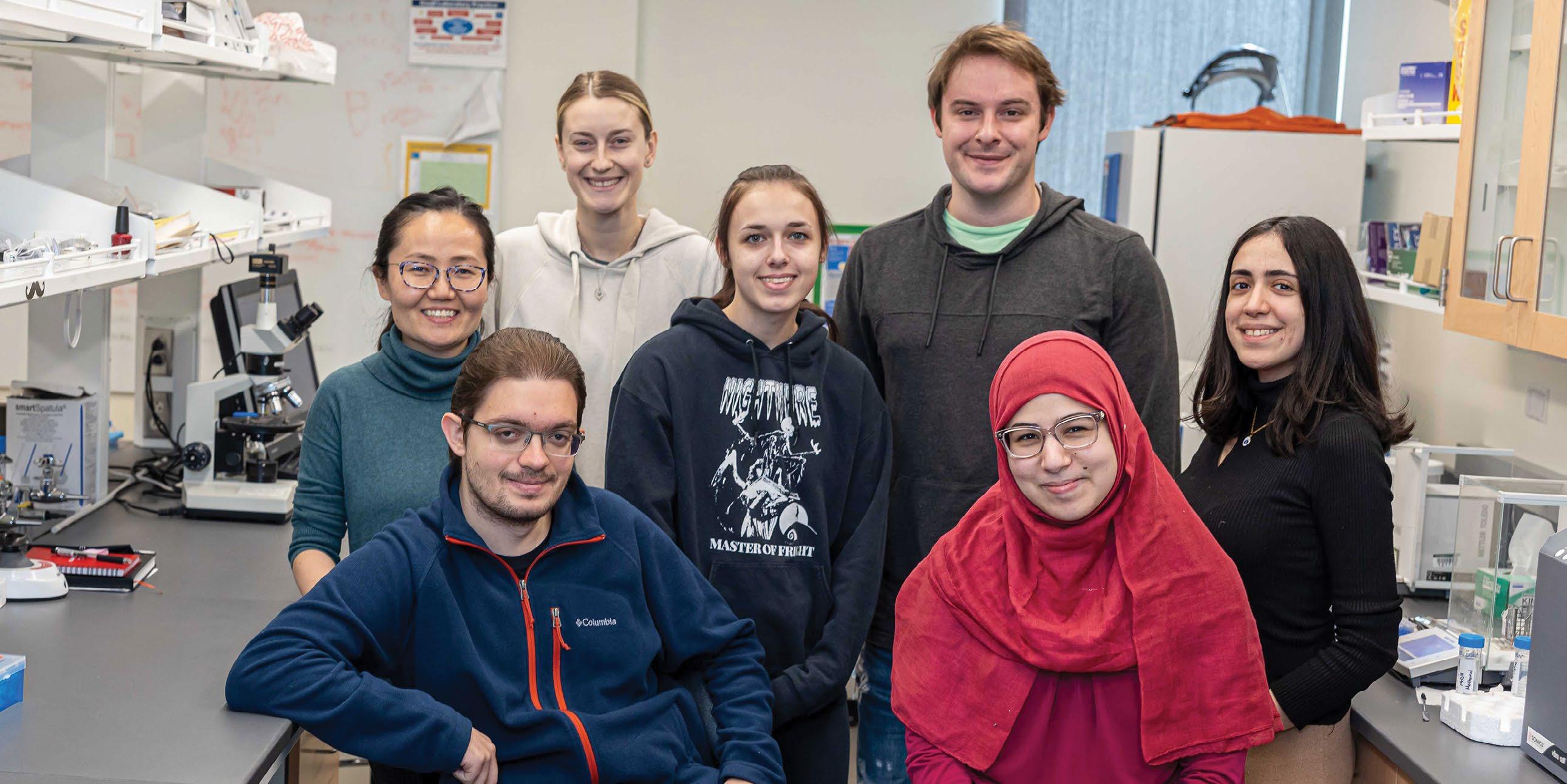
The NSF CAREER award is one of the most prestigious awards granted to junior faculty by the National Science Foundation. It supports scholars in the early stages of their careers, and focuses on integrating cutting-edge research with education.
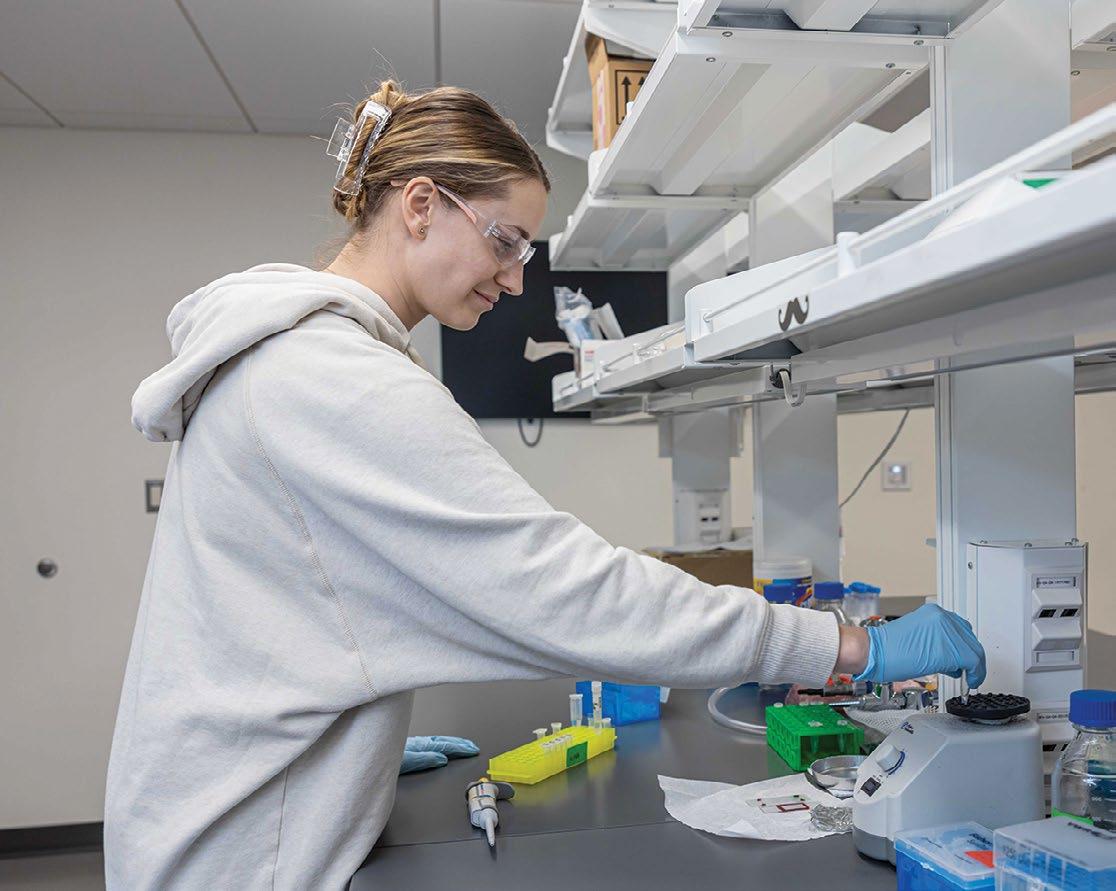
Ao has won many other grants and awards, including other NSF awards. This CAREER award is especially meaningful to her because, she says, “the fact that full professors at other universities reviewed my proposal favorably shows they recognize my ability for research and education. It also provides me a foundation to develop my academic career further, and gives me the resources to do what I’m really excited about, my nanomaterials research.”
Ao is quick to credit others for helping with her research. “I have a wonderful collaborator, Dr. XueLong Sun in the CSU Chemistry Department. His team helps synthesize these glycopolymers that mimic naturally occurring glycoconjugates.”
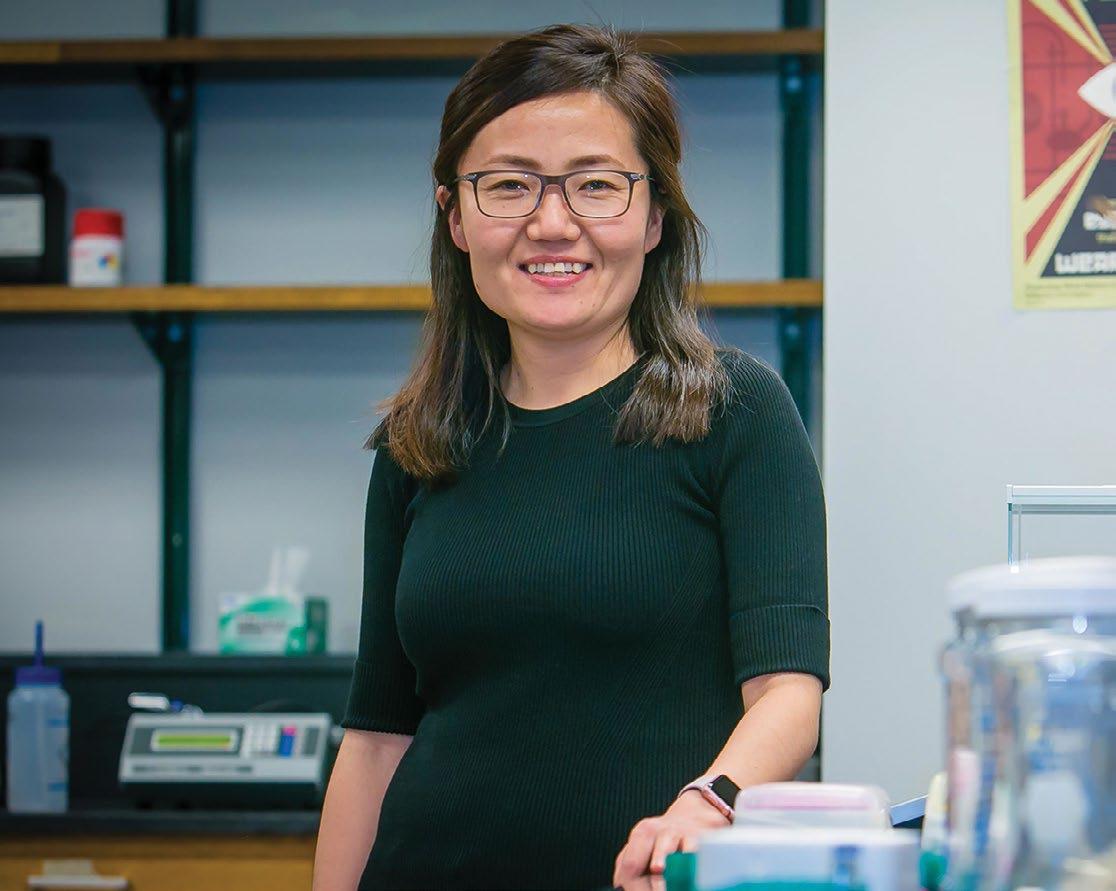
She is also grateful for help she’s received from undergraduate and graduate research assistants. “We wouldn’t be able to carry out the project successfully without all those wonderful students in my lab,” she says. “Their great work provided interesting preliminary data that helped me get this grant.”
Ao expresses a genuine pride when talking about the growth her students undergo during their time in her lab. “I feel so proud when they graduate and move on to their dream jobs,” she says. “Nanomaterial is a completely new concept for them when they first come to my lab. By the time they graduate, they’ve learned science and engineering skills, and have matured during the process as well. I feel very lucky to have excellent students in my lab.”
Ao’s five-year CAREER grant began funding her research in June and will end in 2027. In that time, it will support work by graduate research assistants, who earn a stipend and tuition money, and undergraduate assistants, who earn a stipend. It will enable Ao to develop a nanotechnology course with a lab component, giving senior undergraduates and graduate students hands-on research experience in activities like dispersing nanomaterials and basic characterization, such as optical spectroscopy.
It will also support the educational outreach she does through CSU’s Fenn Academy, getting more local young students interested in STEM fields. At April’s BEST (Bridging Engineering, Science and Technology) Medicine engineering fair, for example, her BioNano Materials lab conducted a workshop for local middle- and high-school science teachers that combined a short introduction to nanotechnology with hands-on activities.
Nina Dzombic Dr. Geyou Ao“Nanomaterial is a completely new concept for them when they first come to my lab. By the time they graduate, they’ve learned science and engineering skills, and have matured during the process as well. I just feel very lucky to have excellent students in my lab.”
—Dr. Geyou Ao
With simple tools, her graduate students illustrated the concept of targeted binding, which can be used for interactions such as targeted drug delivery or cancer detection. They also demonstrated controlled assembly using alginate, which can form worms or bubble-like clumps when added to salt water.

“We hope that by introducing these activities,” Ao says, “teachers can take what they learn and share it in their classrooms.”
The Fenn Academy hosted a summer camp for females focusing on biomedical and environmental engineering that was sponsored by the Engineering Information Foundation. Ao’s lab gave high school girls a seminar in nanotechnology, followed by lab tours and hands-on activities. “The students loved it,” she says.
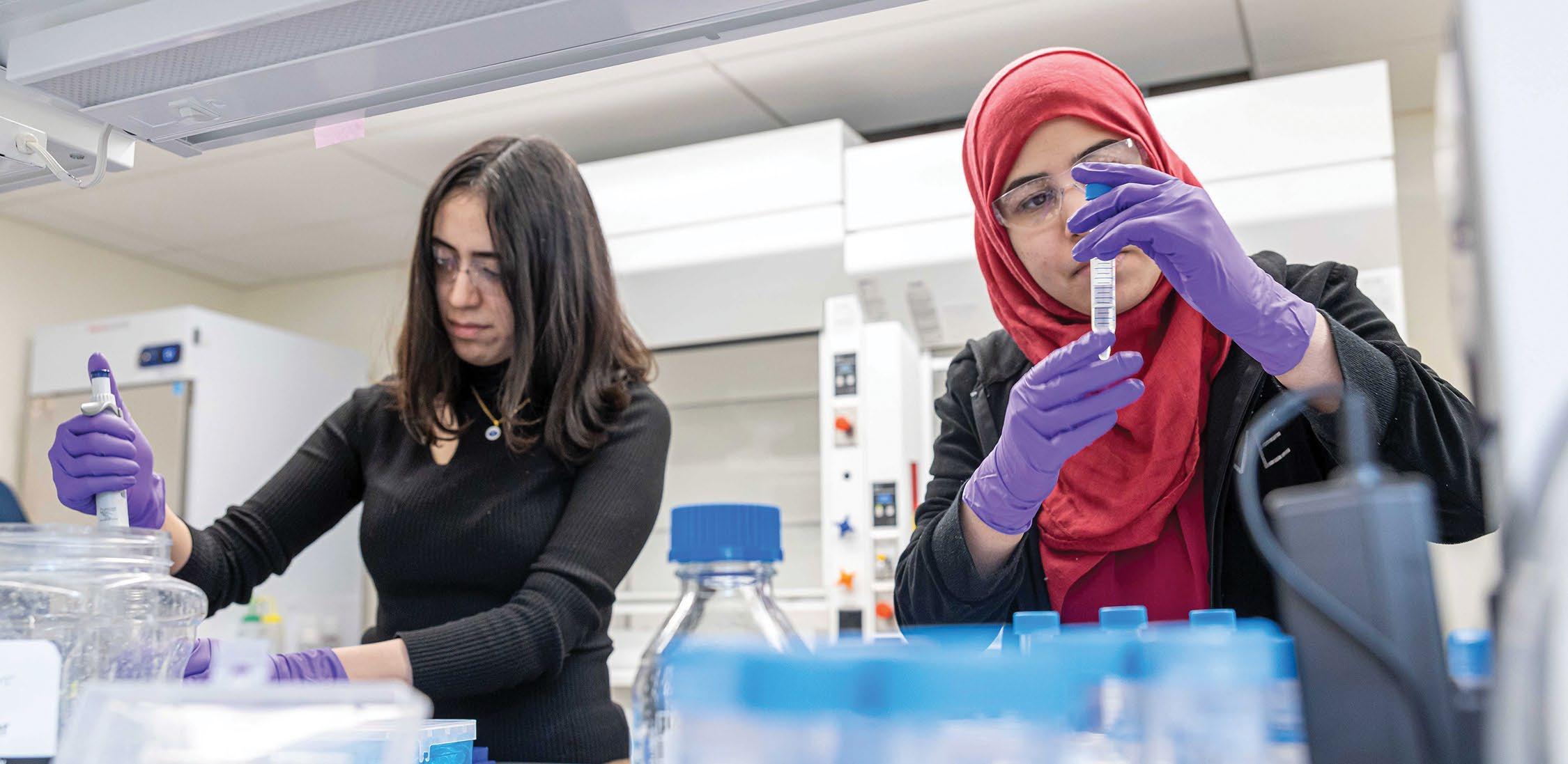
Ao hopes that one day her research will lead to applications that can be developed for the commercial market, and she works with students to help them see the possibilities. “I want students to work in my lab and understand the fundamentals,” she says, “and always have in the back of their minds why they are doing the research and how they can put it toward real-world applications.”
Twice she has participated in the I-Corps@Ohio program, a state-funded program to assist faculty and student teams from Ohio universities and colleges to validate the market potential of their technologies and launch startup companies.
Receiving a CAREER award, according to Ao, is an aspiration of many junior faculty. “When I first started at CSU,” she says, “my goal was to have a CAREER award. So now this goal is achieved. My second goal is to utilize this platform to evolve even further, to do even bigger and better things that I've dreamed of.”
Sumaiya Ahmed (left) and Reyhaneh Tabatabaei (right)my goal was to have a CAREER award. So now this goal is achieved. My second goal is to utilize this platform to evolve even further, to do even bigger and better things that I've dreamed of.
—Dr. Geyou Ao

The new Dean of the Washkewicz College of Engineering, Richard T. Schoephoerster, Ph.D. (pronounced “shep-oyster”), is not content merely to manage the status quo. As his 32-year career in academia shows, he is a leader who blazes new trails through vision, strategy and growth.
From his earliest days as a research associate at Florida International University (FIU) to his most recent role as Dean of the Graduate College and Research at Arkansas Tech University, Schoephoerster has continually worked to establish departments, develop programs, grow enrollments, build facilities, spearhead strategic planning, capture new sources of major funding, and expand research capacities.
His bias toward growth has led him to tackle a host of projects with the gusto of an entrepreneur.
“I like to build new things,” he said in a recent interview, “and that's what I've done everywhere I’ve worked.”
As an academic administrator, Schoephoerster encourages a strong entrepreneurial ethos among faculty. “In some respects,” he said, “all successful faculty are entrepreneurs. They've got to find a market for whatever they do, whether it's teaching or research. They have to put together a product, and figure out how to sell it to their markets. They have to develop budgets, find funding sources and put the people in place.”
“I am fairly ambitious in terms of setting goals,” he offered. “It’s important to set a vision and develop a general plan for where to go forward. But then I tend to be fairly hands-off. I work with people to say, ‘here's the general direction we all agree we want to go. You figure out how you want to get those results, and I’ll help you along the way’.”
The College of Engineering is a huge part of CSU’s Cleveland Innovation District/JobsOhio initiative to graduate 10,000 new students in STEM-related fields over the next 10 years. So, we were looking for a dean who understood all of those pieces. Dean Schoephoerster
Schoephoerster calls CSU 2.0, Cleveland State University’s strategic plan announced in 2021, “bold and ambitious,” and “one of the first things that attracted [him] to the job. I've always been at places that were growing—growing their enrollments, or their research capacity or their programs.”
CSU President Laura Bloomberg, Ph.D., as thenProvost in the Fall of 2021, oversaw the search for the new dean. She said that Schoephoerster’s broad and deep experience—particularly with regard to vision, strategy and growth—made him a standout among a long list of candidates for the job.
To foster an entrepreneurial environment, Schoephoerster begins by assiduously developing both vision and strategy. He follows up with a comparatively laissez-faire approach to managing people.
“We really wanted the leader of the College of Engineering to have a big vision for what is possible,” she said. “That vision had to include teaching excellence, research excellence and a real focus on application to the region. The College of Engineering is a huge part of CSU’s Cleveland Innovation District/JobsOhio initiative to graduate 10,000 new students in STEM-related fields over the next 10 years. So, we were looking for a dean who understood all of those pieces. Dean Schoephoerster was the obvious choice.”
was the obvious choice. —President Bloomberg
CSU’s role in the Cleveland Innovation District especially appealed to Schoephoerster because one of his passions is regional economic development. Strong, statefunded research universities like CSU, he believes, are key drivers of prosperity in vibrant urban areas across the country.
“Columbus is a perfect example,” he said. “Look at the effect The Ohio State University has had on Columbus over the last 50–60 years. CSU could have the same impact on Cleveland as we expand our research here.”
“Part of doing that means getting entrepreneurial faculty to spin off companies using the technologies they develop,” he added. “Some faculty are doing that here already, and we want to continue to attract more faculty who do those kinds of things.”
Another factor that attracted Schoephoerster to CSU is planned investments in biomedical engineering, his discipline.

“Everywhere I've worked, I’ve built biomedical engineering programs,” Schoephoerster said. “When I was building the biomedical engineering program [at FIU], the Cleveland Clinic expanded down to South Florida, and we developed relationships with them. I am excited about the opportunity to build and expand biomedical engineering here.”
Schoephoerster joined CSU in February 2022 with a track record of working at institutions that were similar to the University. Former employers Florida International University and the University of Texas at El Paso, for example, are also highly diverse, public research universities serving urban populations.
They, too, have a high proportion of first-generation students and a strong commitment to student success and engaged learning. His stint at the American University of Sharjah (UAE) further acquainted him with international student populations, and gave him a wealth of academic and industry contacts all over the world.
President Bloomberg says Schoephoerster is ideally suited to the role of Dean of the Washkewicz College of Engineering.
“First, he has broad and deep experience in leading and developing engineering programs. Second, his experience fits nicely with our strong international student presence. Third, he built something from whole cloth as founding chair of the Biomedical Engineering Department at FIU. Fourth, his career proves he understands that, while traditional degree programs are really our bread and butter, there are other ways to provide training and education to people,” she explained.
“He has a lot of experience delivering professional development programs and thinking about certification programs to build training over time," Bloomberg added. “Finally, he values quality teaching and thinks a lot about how
a college leader, can nurture and support
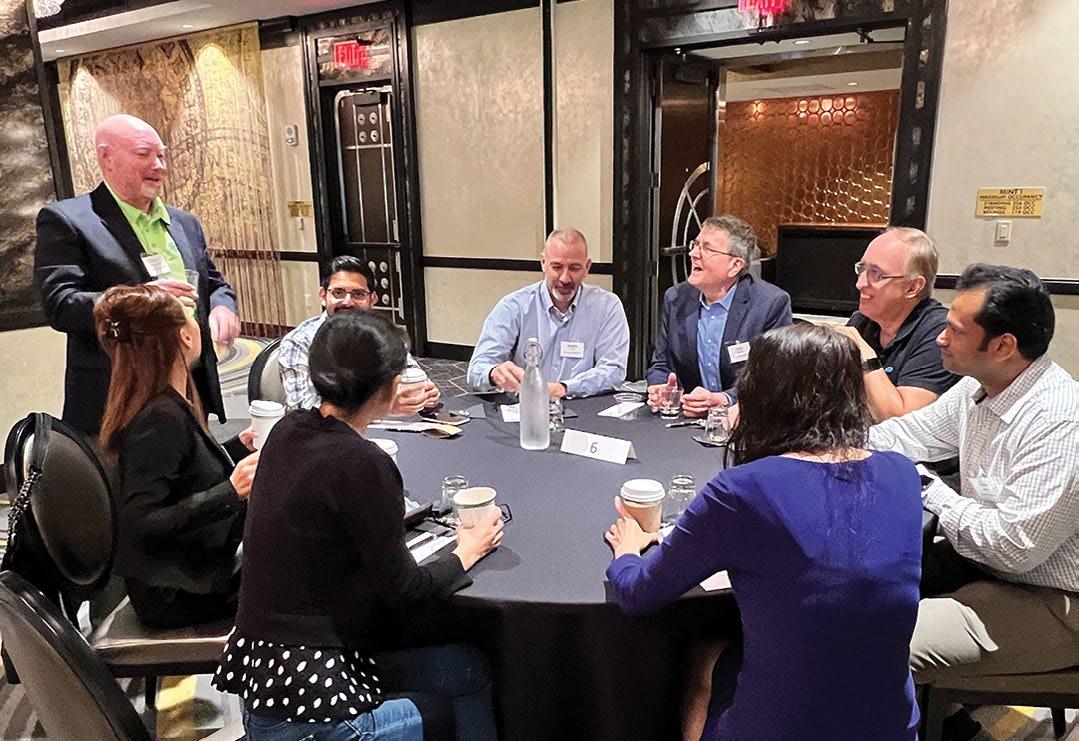
he, as
faculty excellence.”John Schultz, Mechanical Engineering Ph.D. student; Dan T. Moore and Dean Richard Schoephoerster at the opening of the Dan T. Moore MakerSpace. Dean Richard Schoephoerster conversing with faculty at their Fall 2022 retreat.
“Look at the effect The Ohio State University has had on Columbus over the last 50–60 years. CSU could have the same impact on Cleveland as we expand our research here. ”
—Dean Schoephoerster

WHY HE VALUES DIVERSITY. “Diversity drives innovation, for both groups and individuals. That's why I decided throughout my career to always move into new areas so I can learn new things and be exposed to a wide variety of individuals and cultures. I grew up on a farm in Iowa, which was not diverse at all. When I went to the University of Iowa, that was my first exposure to ethnic, racial and international diversity. My first job was in Miami, which is as diverse as Iowa is homogeneous. Exposure to so many people from different walks of life has made me a better engineer and a better administrator, because I understand people much better now. As a leader of an organization, that's very important.”
HE PREDICTS RAPID GROWTH IN DATA SCIENCE AT CSU. “The Washkewicz College of Engineering just started a new bachelor’s degree program in data science approved by the state of Ohio. We began enrolling students in that program this fall. It is going to grow by leaps, and we're already looking at expanding it at the graduate level. We’ll be starting to produce a lot of research and data scientists—everything from data analytics to artificial intelligence and machine learning.”
HE THINKS CREATIVELY ABOUT TRANSFORMING HIGHER EDUCATION. “I believe higher education is in the middle of a major transition that will probably take another 25 or 50 years to play out. Because of the declining interest in bachelor's degree programs, we have to change. We need to expand the types of programs we offer, such as our non-credit certificate in smart manufacturing. Micro-credentials like that are the wave of the future. [At CSU] we’re going to be moving into more micro-credentials that we can integrate into our bachelor's and master's degree programs.”
WHY THE WORLD NEEDS MORE WOMEN ENGINEERS. “The technology that engineers create totally transforms the way we live our lives. Everything we do is somehow dependent on one technology or another, and to have that field so dominated by males is not a good thing. As a society, we have been working on getting more women into engineering, but we have barely made any inroads. We've been stuck at 20 to 25% female enrollment for almost three decades now. We have to continue working on it, because we're missing out on a large pool of talent.”
WHY HE BECAME AN ENGINEER. “My mom was a nurse, and my older brother became a doctor. So, I was thinking I’d go into medicine. But in my senior year of high school, my physics teacher got invited to a workshop at the University of Iowa where they had just started a biomedical engineering program. He came back and talked to me about it, and he changed my life. I fell in love with biomedical engineering, because it combined my love of tinkering, math and technology with the ability to have an impact on human lives.”
WHAT HE REALLY LOVES. “I fell in love with research, but over time I figured out I'm a teacher. That's what I really like to do. So even though biomedical engineering is my love, my real love is teaching. I love to teach. And the reason I love to teach is because I love to learn. Every time I'm in the classroom, I feel like I'm learning along with the students, and that's my goal.”
the Current State of Engineering Education, the Importance of Diversity, and Why He BecameAudrey Wiggins, Tayluer Streat-Ricchiuti, Biomedical Engineering Ph.D. student, and Dean Richard Schoephoerster at the Women in Engineering Graduation Recognition Banquet, April 2022.
Members of the Engineering Dean's Diversity Council (left to right): Jorge Gatica, Ph.D., Co-chair; Sunnie Chung, Ph.D.; Celena Roebuck, Ph.D., Monte Ahuja College of Business, Accounting; Audrey Wiggins, Chair; Dean Richard Schoephoerster; Lili Dong, Ph.D.

• Dean, Graduate College and Research, Arkansas Tech University in Russellville, Arkansas (2020–2022)
Oversaw all graduate programs across five colleges and all research programs university-wide. Designed, built and delivered professional development workshops for 10,000+ members of the American Society of Engineering Education (ASEE), with separate modules targeted toward junior faculty, new department leaders and aspiring deans.
• Dean, College of Engineering, American University of Sharjah (AUS) in the United Arab Emirates (2016–2019)
Led the efforts to establish the M.S. and Ph.D. programs in biomedical engineering, transitioned the undergraduate curriculum into project-based/practicebased learning and transformed AUS into a leading research university in the Middle East.
• Dean, College of Engineering, University of Texas at El Paso (UTEP) (2007–2015)
The first recipient of the Riter Endowed Professorship in Engineering in 2011, Schoephoerster led the efforts to establish new programs in systems engineering (M.S.), construction management (M.S.), biomedical engineering (M.S. and Ph.D.), software engineering, and mechanical engineering (Ph.D.).
• Faculty member, Florida International University Miami, Florida (1990–2007)
Started as Research Associate, then moved to Assistant Professor (1992), Associate Professor (1996) and Full Professor (2001). As founding chair of the Department of Biomedical Engineering, he led the establishment of the B.S., M.S. and Ph.D. programs in biomedical engineering. Named the Wallace H. Coulter Eminent Scholars Chair in Biomedical Engineering in 2005, he ran an active research program in the area of biofluid mechanics and cardiovascular devices.
• Fellow, American Institute of Medical and Biological Engineering
• Fellow, American Heart Association
In addition, Schoephoerster has served on the:
• Global Engineering Deans Council Executive Committee
• Texas Emerging Technology Fund Advisory Committee
• Executive Leadership in Academic Technology and Engineering (ELATE) Program Advisory Board
• Florida Biomedical Research Advisory Council
Born in Iowa, Schoephoerster earned his bachelor’s degree in Biomedical Engineering from the University of Iowa. He earned his master’s and doctoral degrees in Mechanical Engineering, also from the University of Iowa. His specialty area is biofluid mechanics and cardiovascular devices.
“First, he has broad and deep experience in leading and developing engineering programs. Second, his experience fits nicely with our strong international student presence. Third, he built something from whole cloth as founding chair of the Biomedical Engineering Department at FIU. Fourth, his career proves he understands that, while traditional degree programs are really our bread and butter, there are other ways to provide training and education to people.”


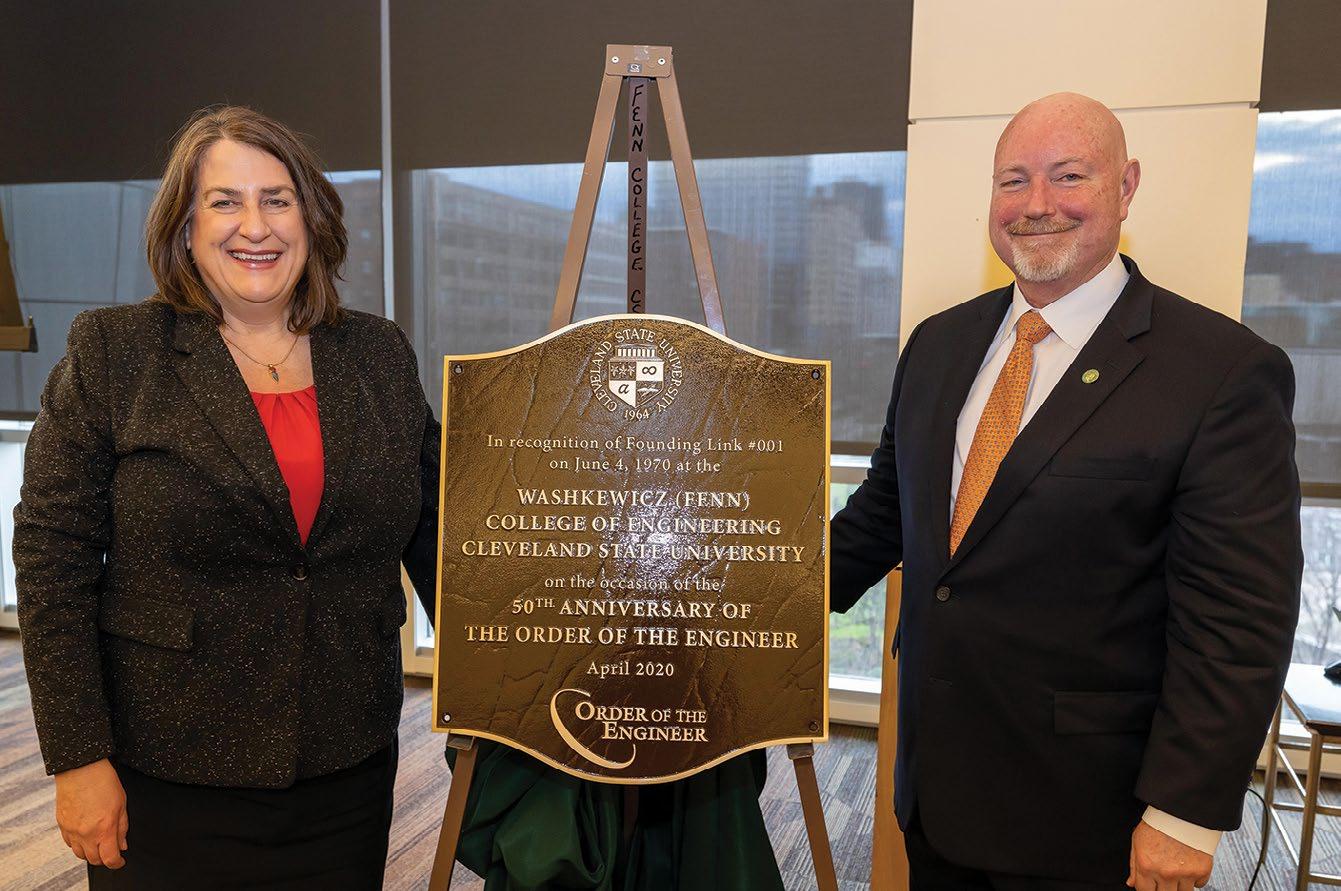
 —President Bloomberg
Joanne Belovich, Ph.D. and Dean Richard Schoephoerster unveiling the 50 th Anniversary Order of the Engineer plaque.
Bogdan Kozul, Asst. Professor of Practice; Sean P. McDermott, B.S. Mechanical Engineering, Spring 2022; Dean Richard Schoephoerster and Dan Moore discussing the 2021 National Fluid Power Vehicle Challenge submission that won first place.
—President Bloomberg
Joanne Belovich, Ph.D. and Dean Richard Schoephoerster unveiling the 50 th Anniversary Order of the Engineer plaque.
Bogdan Kozul, Asst. Professor of Practice; Sean P. McDermott, B.S. Mechanical Engineering, Spring 2022; Dean Richard Schoephoerster and Dan Moore discussing the 2021 National Fluid Power Vehicle Challenge submission that won first place.
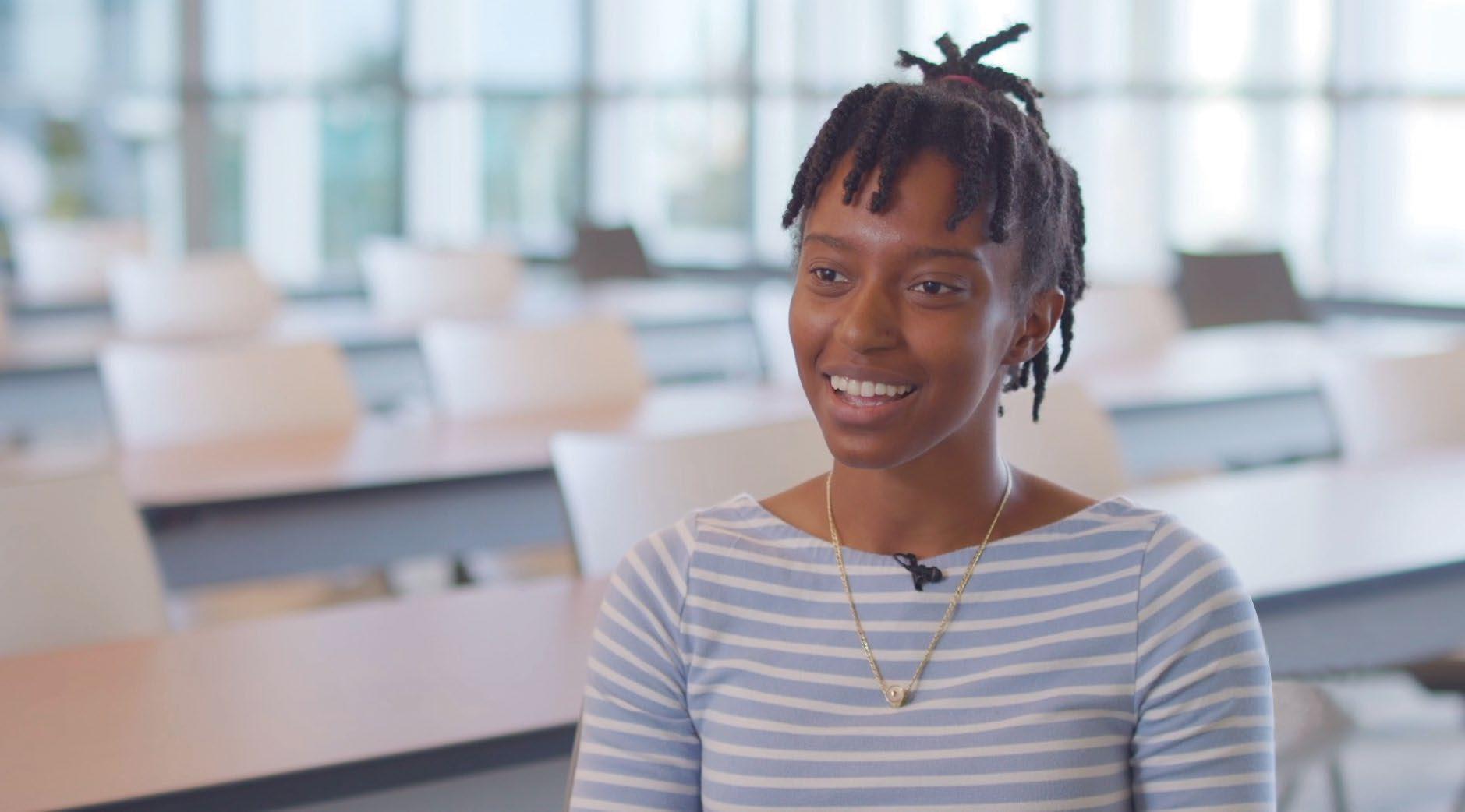
To say that Tayluer Streat-Ricchiuti has a passion for robotics and a drive to make a difference in people’s lives is something of an understatement.
“My interest in exoskeletons and really robotics [as a whole] is where it all started when I was younger,” said Streat-Ricchiuti. “I just thought robotics was amazing.”
Paired with a desire to make people’s lives easier, Streat-Ricchiuti joined her high school robotics team and was encouraged to pursue an engineering career. She went on to receive her bachelor’s degree in mechanical engineering, with a concentration in biomedical systems from Embry-Riddle Aeronautical University.
Above: Tayluer Streat-Ricchiuti, Biomedical Engineering Ph.D. studentThat experience set in motion her arrival at Cleveland State University’s Washkewicz College of Engineering, where this past spring she graduated with her master’s in biomedical engineering. Streat-Ricchiuti is now pursuing a biomedical engineering Ph.D. here at CSU.

“My experience at CSU has been wonderful,” said StreatRicchiuti. “The environment is very homey. I’ve had really great late-night conversations working on projects until almost two in the morning. When I’m concerned about a class, my professors are accessible and I’m able to go specifically to talk to them—which is sometimes rare at universities.”
Streat-Ricchiuti added that the size of CSU is “just right” for “having the big campus experience and the focused, individualized attention of a smaller college or university together” at the same time.
“I’ve had conversations with freshmen, undergrads and even other grad students and have been able to integrate myself into the CSU culture and the community environment we have here,” she said. “To the point where I really feel a sense of belonging in the community.”
This past summer, Streat-Ricchiuti taught, tutored and mentored high school students pursuing STEM studies at the Fenn Academy Hyland STEM Institute.
“I was a part of four summer camps, where pretty much every instructor was a female trailblazer in STEM. It was an amazing experience,” she said.
Throughout her educational journey, Streat-Ricchiuti was a team member for the Bilirubin Treatment Device and served as secretary and pre-college initiative chair for the National Society of Black Engineers (NSBE). At the NSBE convention in Anaheim, California last spring, she gave several different presentations to a robust audience of student engineers.
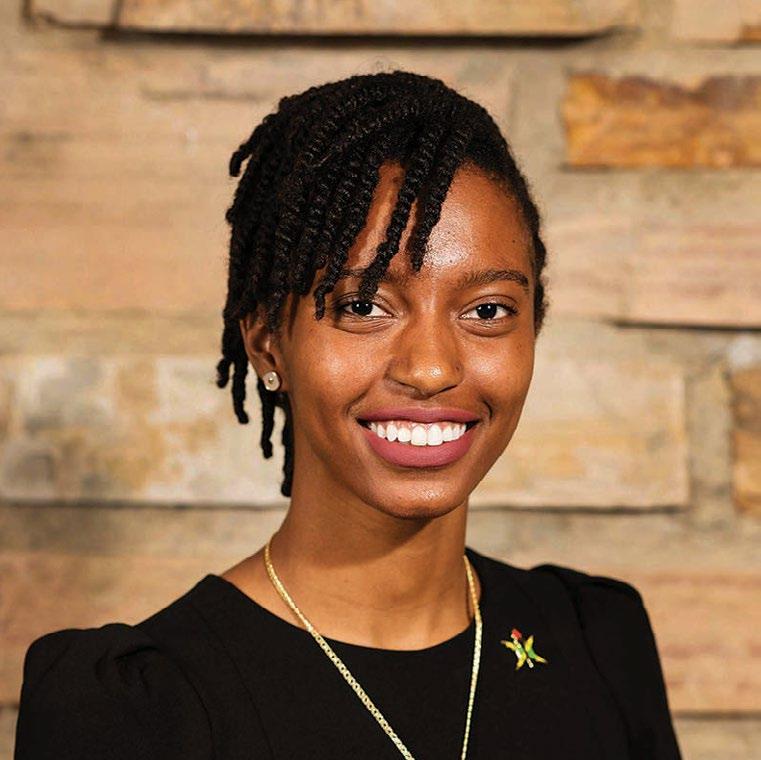
Having a CSU student with this kind of national responsibility is amazing, but her highlight reel doesn’t end there: Streat-Ricchiuti has been an active member of the Society of Women Engineers and the Biomedical Engineering Society, and was a part of the Air Force Reserve Officer Training Corps.
My experience at CSU has been wonderful... I’ve had really great late-night conversations working on projects until almost two in the morning. When I’m concerned about a class, my professors are accessible and I’m able to go specifically to talk to them—which is sometimes rare at universities.
—Tayluer Streat-Ricchiuti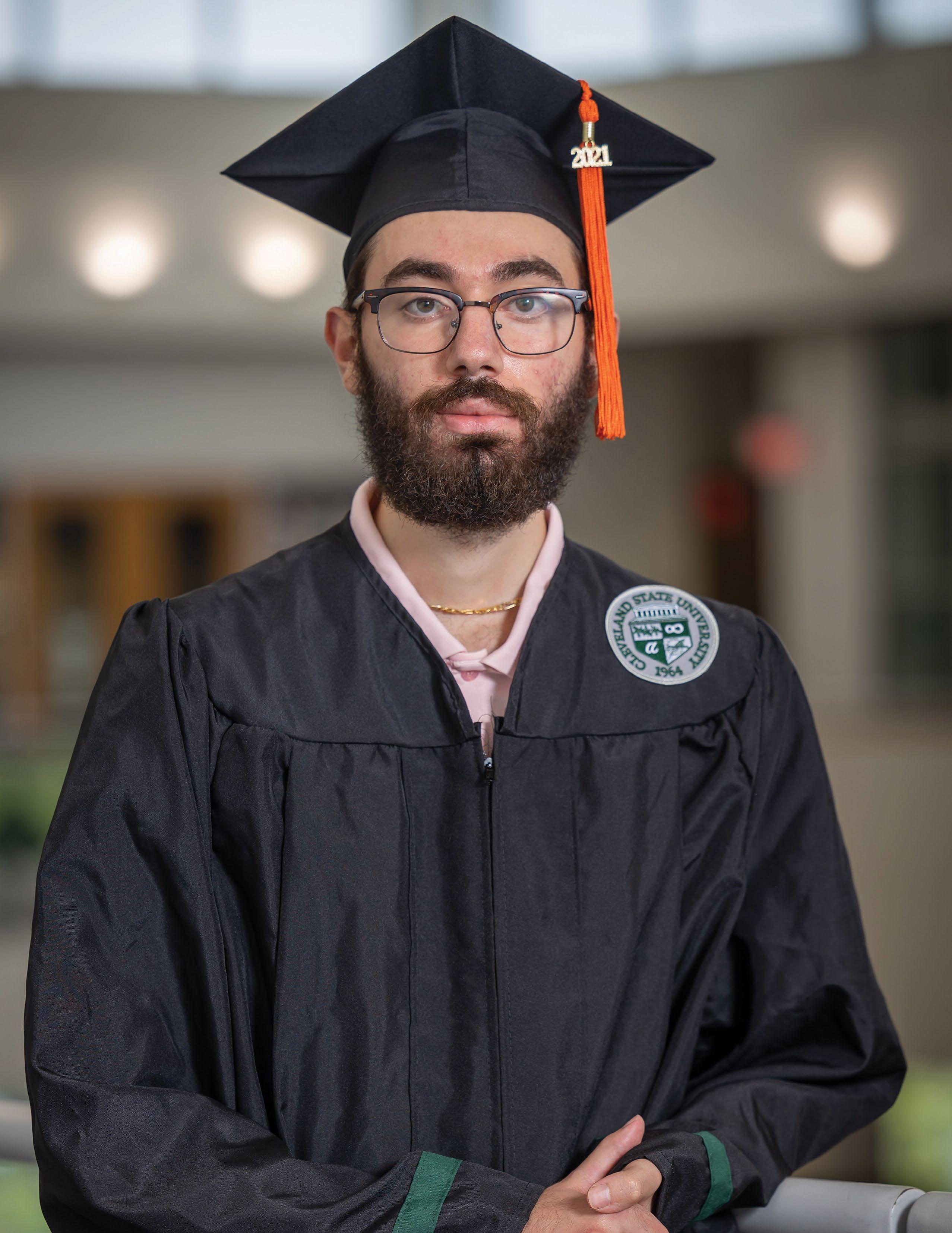
Not even a life-threatening heart condition was enough to slow down Justin Daher, the College of Engineering valedictorian in the Fall of 2021. He earned his B.S. in Mechanical Engineering, with a minor in Mathematics, in under three years— and graduated summa cum laude!
Daher had previously abandoned childhood plans to become a doctor when he realized earning a medical degree would take too much time. He skipped a year of college by earning enough credits at Mayfield High School to enter CSU as a sophomore. He even chose mechanical engineering over other specialty areas because, as he said in a recent interview, “I would be able to get out of a year of school by doing so, and I’m all about efficiency.”
True to form, when Daher had a heart attack-like episode during spring break of 2019 due to myocarditis—inflammation of the heart, he completed the semester anyway, earning straight A’s while working remotely between hospitalizations and multiple medical procedures including open-heart surgery. Between his health issues and COVID-19 quarantines, Daher did not return to campus until the fall of 2021, but he still managed to graduate that December.
Having chosen CSU to save money, to stay close to his family and to uphold the family tradition—his father, older brothers and sister also graduated from CSU, and his younger sister currently attends— Daher’s health challenges taught him another reason to value his Cleveland State University education.
“It’s a personal campus,” Daher said. “People care. When I had to miss a couple of months for health reasons, my professors and fellow students chipped in to keep me up-to-date. Professors made accommodations and reached out to make sure I was doing well. My classmates shared notes with me, walked me through my confusions and visited me in the hospital.”
Despite his compressed academic career, Daher made the most of his time in the College of Engineering. For his Senior Design project, he invented a geothermal dehumidifier to collect clean water from humid air. He is seeking to patent his “Daher Drywell,” which he hopes will be a low-cost solution for people around the world needing access to clean water.
After witnessing a friend’s deteriorating mental health during the pandemic, Daher also initiated a petition to implement a Pass/Fail grading system for CSU’s remote learning during the COVID-19 quarantine. He joined the Math Club and the Robotics Club, and he was an honorary member of the Baja SAE off-road vehicle design competition.
Daher now works full time as an operational excellence consultant at MAGNET Cleveland, not far from the CSU Engineering building. His experiences at CSU, he believes, prepared him well for his new job and renewed his appreciation for his fellow students.
“CSU has more people with good character than all the other colleges I’ve visited,” Daher offered. “Maybe I’m biased, but I feel like students at CSU have a higher appreciation for the opportunities they have, for their education and for each other.”
Being a student at CSU also strengthened his love for the city.
“I now have a deeper appreciation for Cleveland, and a pride in my residency here,” he said. “It’s a great city with good people who have their priorities straight.”
Palagyi, who lives in Macedonia with his family, celebrated the building of bridges. He invoked the engineering marvels of the Innerbelt Bridge, the Valley View Bridge and the Detroit-Superior Bridge as the means by which he and fellow classmates journeyed to and from CSU each day.
His real focus, however, was on bridges of a metaphoric variety: deep, meaningful connections people build with others in order to ease their paths in life. He exhorted his fellow graduates to find ways to build such bridges themselves.
Palagyi practices what he preaches. When he became an Eagle Scout, he “took an oath to always ‘do a good turn daily,’ and to ‘always leave things better than [he] found them’.” As a high school student at St. Ignatius, priests and teachers showed him “a St. Ignatius education exists not to make you better than everyone else, but better for everyone else.”
Palagyi has internalized these lessons and lives them daily.
At CSU, he tutored in the Math Learning Center, played mellophone and trumpet in the pep band during men’s and women’s basketball games, led the Newman Campus Ministry and organized a soldering seminar for IEEE, Women in Engineering, and CSU Robotics to help students prepare for their co-ops and careers.
Outside of CSU, he has remained active in the Science Olympiad—mentoring the team he founded as a grade schooler at St. Barnabas Catholic School in Northfield, and teaching the St. Ignatius team he once helped grow to a top 10 state finish. He also serves as a judge for the Akron and Lorain Regional Tournaments.
“I strive to give as many students as possible the same experiences and mentorship [opportunities] I was given,” Palagyi said.
He returns to the Seven Ranges Scout Reservation in Kensington each summer to prepare the STEM Center (which he founded) and to train the STEM Center staff for each new season of campers.
Palagyi said that he is thrilled to have “changed the lives of hundreds of scouts,” many of whom “went on to pursue engineering or computer science, or who decided to go to college because of what they experienced at the STEM Center.”
He has also prepared and served meals to hungry community members, and acted as a pallbearer for those with no one left to carry them to their final resting spots. Palagyi conveyed a sense of profound joy in serving others and a moral obligation to do what he can to improve the human condition.
He hopes one day to teach at the high school or college level. He would like to “channel [his] passion and use it to teach people what [he loves], in hopes that even a few of them might find that same spark.”
Somehow, Palagyi successfully balanced all his community service with his school work. He had the stellar academic record people expect of a valedictorian.
A National Merit Finalist in high school, Palagyi graduated summa cum laude from the CSU Honors College with a degree in Electrical Engineering and a minor in Mathematics, having racked up a host of academic awards along the way. His professors lavish superlatives on the quality of his work. One hails him as “the best student I’ve taught in a decade.”
Valedictorian Caleb Palagyi began his address to the Spring 2022 graduating class of Cleveland State University sounding more like a civil engineer than the electrical engineer he is.Palagyi first dreamed of becoming an engineer in the sixth grade, when he toured the Weatherchem Plastics Bottle Cap Factory in Twinsburg (now known as Mold-Rite Plastics). “Watching tens of thousands of bottle caps flow neatly down the conveyors was mesmerizing,” he says. “At that moment, I knew I wanted to do one of two things: design the assembly lines or design the gray boxes with the blue stop signs that made everything work.”
Ten years later, Palagyi is doing just that. As an Associate Hardware Engineer at Rockwell Automation, he works on a team that designs new industrial automation systems. While working at Rockwell full-time, he plans to pursue a master’s degree at CSU in Electrical Engineering with a focus on power electronics.
Palagyi began working at Rockwell more than two years ago in three full-time and four part-time co-op rotations while earning his undergraduate degree. His Rockwell coworker and mentor, Brian Campbell, called Caleb “a rare individual, highly valued and even sought out as a resource by many at Rockwell Automation.”
Palagyi believes his excellent professors and the hands-on learning at CSU gave him the tools he needs to be a successful engineer.
Other engineering schools, he says, “will give you the tools, but they won't necessarily show you how to use them or give you the opportunity to use them.” In contrast, CSU “gives you the tools, shows you how to use them and engages you in using them to solve actual problems.”



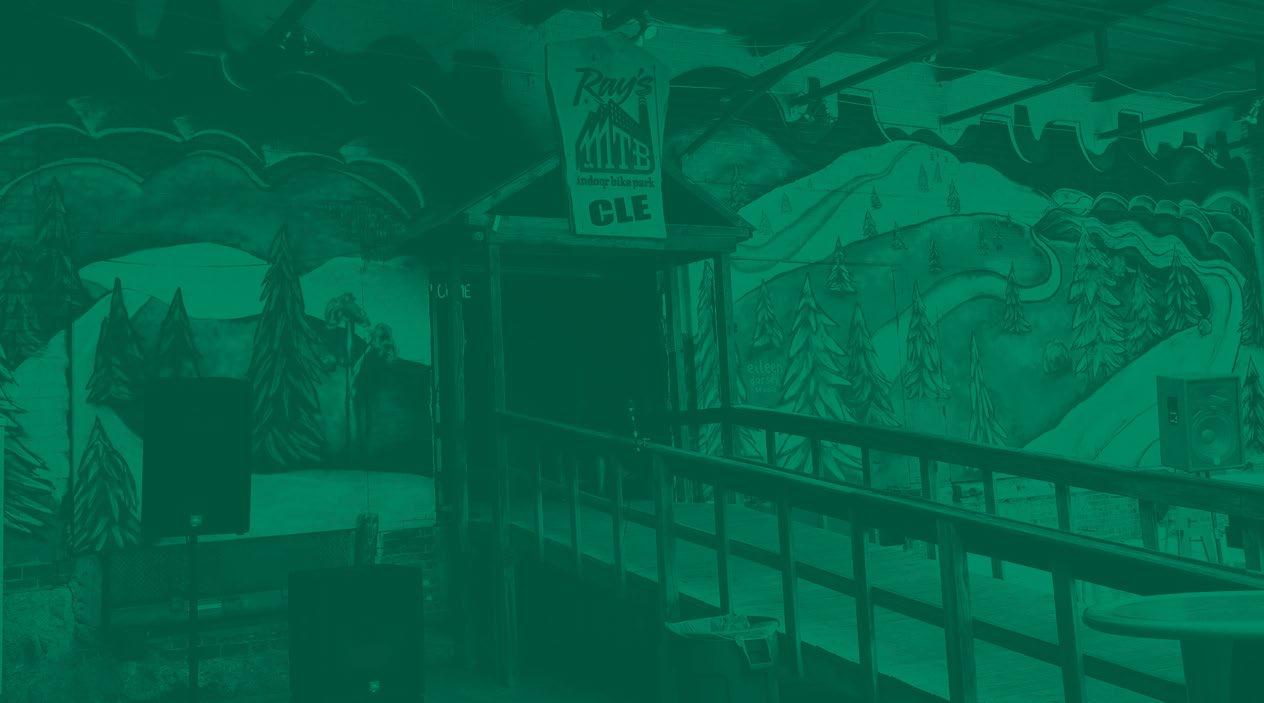
In her inaugural address to Cleveland State University October 7, President Laura Bloomberg highlighted a recent Center for Human-Machine Systems (CHMS) project as a prime example of “teams of [CSU] faculty and students… working daily to ensure that people in need have the personalized support that will enable them to live full lives.”
The purpose of the project was to help local business owner and mountain biking legend Ray Petro, paralyzed in a biking accident in 2017, get back to riding his beloved trails. The team worked to adapt a rugged-terrain fourwheeled bike with electric power steering, enabling Petro to steer more easily and make complete turns.
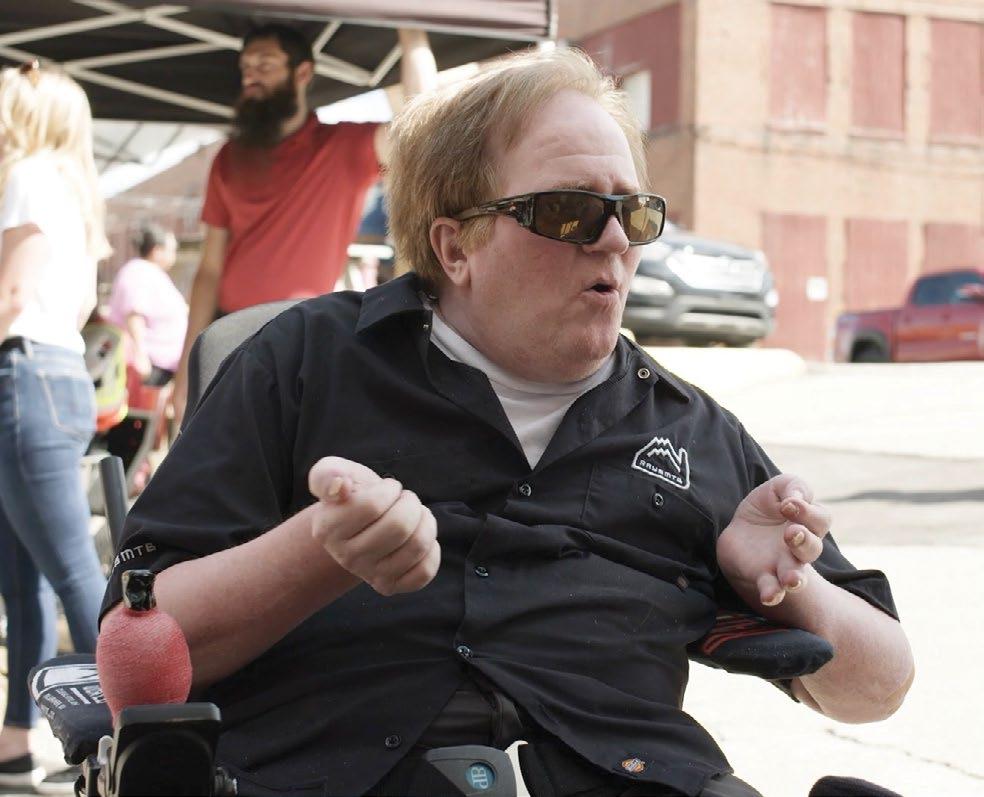
Mechanical Engineering Associate Professor and Director of CHMS Eric Schearer, Ph.D., managed the project. The volunteer team included President of the Spinal Cord Injury Volunteer Corps (SCIVC) and doctoral student Skye Carlson; Steven Wilson (M.E., CSU Class of 2022); Kyra Stovicek (M.E., CSU Class of 2022) and Tyler Tokarcik, a current mechanic apprentice for industrial equipment.
One of the first challenges the team faced, according to Wilson, was finding a place to manufacture their custom-designed parts. MAGNET Cleveland, a nonprofit consulting group that has a general partnership with CSU through the SAE Baja team and the students who work at the machine shop, provided the needed space.

 Skye Carlson Kyra Stovicek Tyler Tokarcik
Steven Wilson
Volunteer Team
Ray Petro, mountain bike pioneer, speaking at the Big Reveal event.
Skye Carlson Kyra Stovicek Tyler Tokarcik
Steven Wilson
Volunteer Team
Ray Petro, mountain bike pioneer, speaking at the Big Reveal event.
The biggest design challenge, Wilson said, was “a linkage that had a complicated geometry in order to clear the seat and other components of the bike. With all of our unique backgrounds, we were able to develop a design and continue to modify it until we corrected all clearance issues.”
A mountain bike rider himself, Wilson has ridden at Ray’s Indoor MTB Park since 2006. He knew about Petro as the founder, designer and owner of the world’s first indoor park. Located inside a onceforgotten Cleveland factory, Ray’s Indoor MTB is known to mountain biking enthusiasts the world over as an “epic” all-season riding destination.
“Ray has done a lot of good for not only the Cleveland community but others as well,” Wilson said. “He’s been involved with the development and building of many outdoor mountain bike trail systems in Ohio and other states. He’s given countless people a place to ride, so it was awesome to help give him the ability to ride again.”
—Steven WilsonThe SCIVC/CHMS team presented their adapted bike to Ray Petro in a September ceremony at Ray’s MTB dubbed “The Big Reveal,” an event that also unveiled a new mural at Ray’s MTB by artist Eileen Dorsey. Petro drove his new bike in a demonstration captured on video at: bit.ly/RaysBike
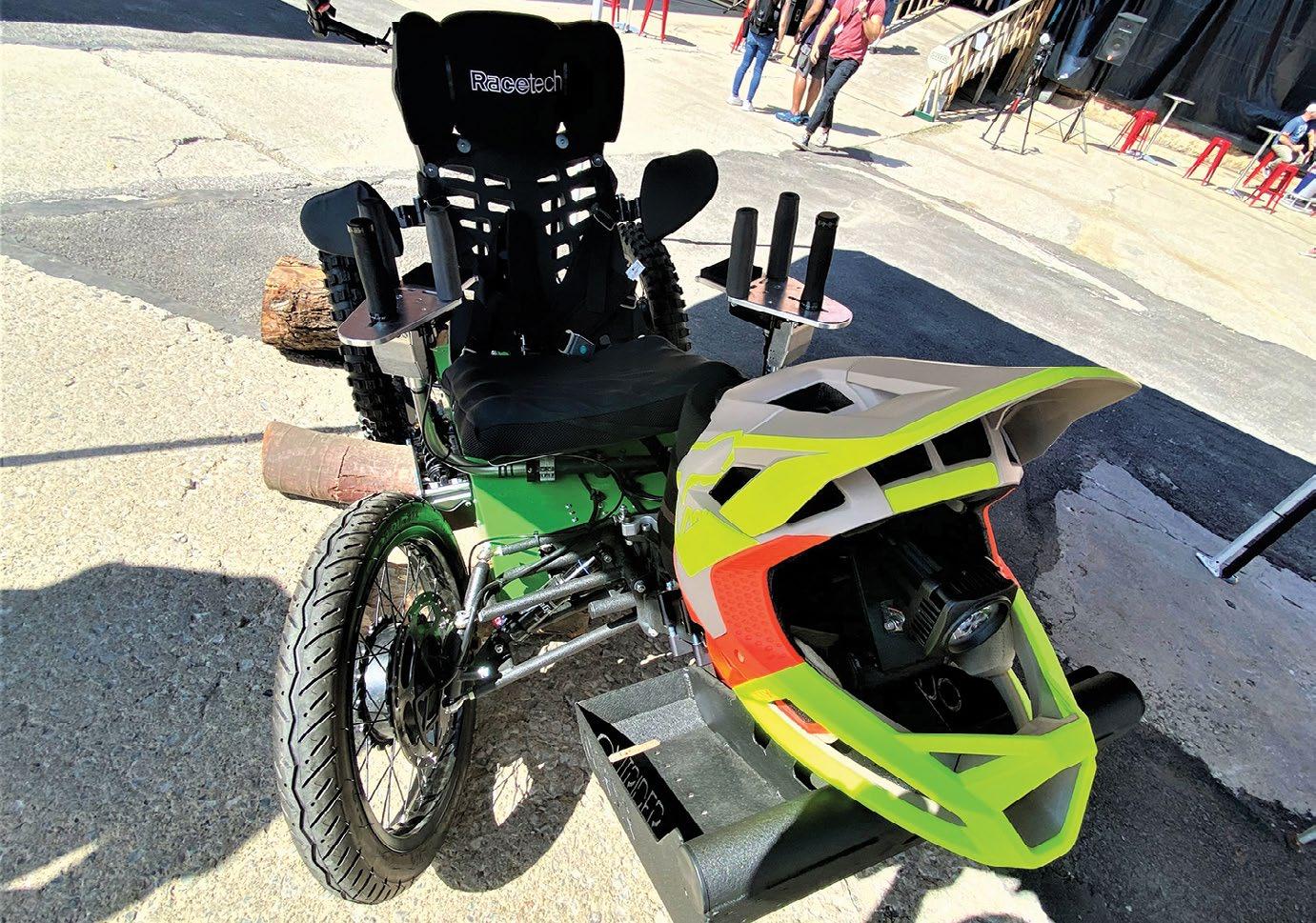
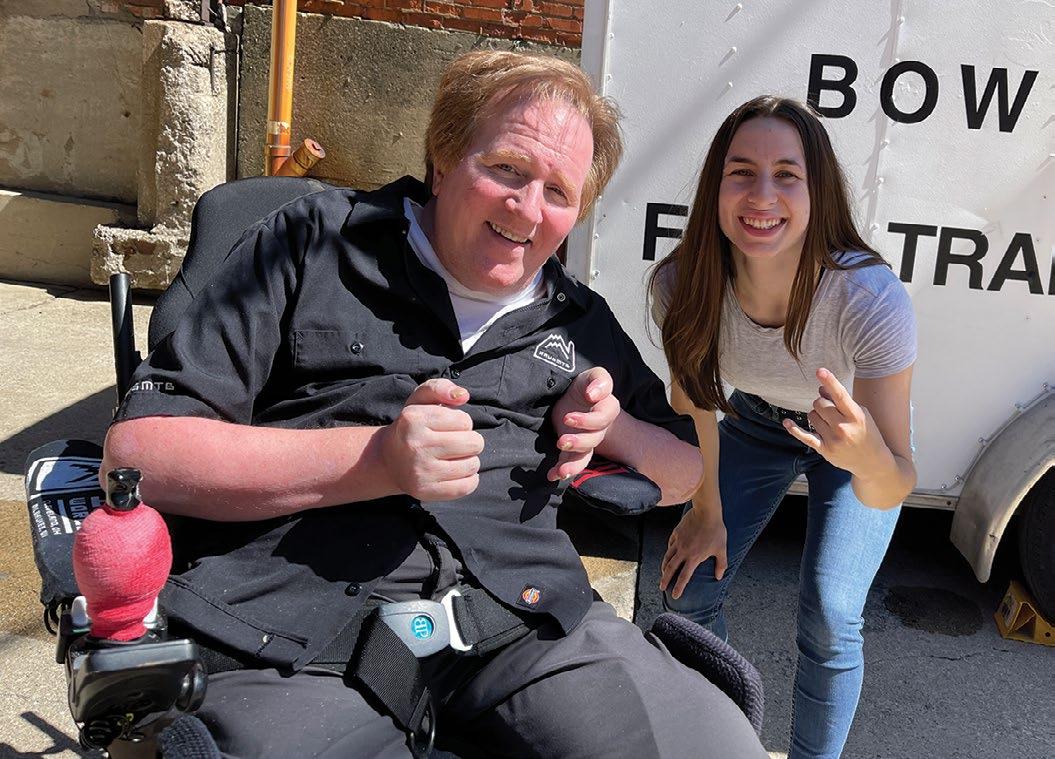
CSU Provost Nigamanth Sridhar introduced the team and the bike by saying, “This really is the manifestation… of what we mean by ‘engaged learning’. Here is an example of a real problem, that somebody— a visionary—needed help with. Our students were able to figure out how to implement a solution and get it… where it can actually be used.”
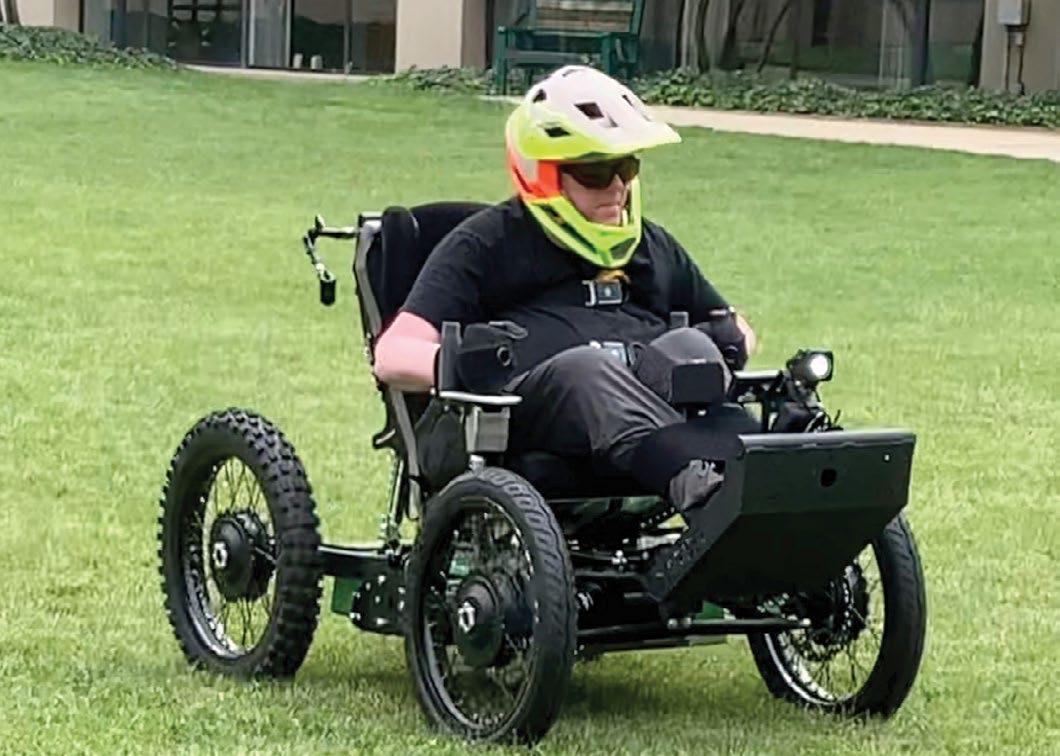 Ray Petro testing out electric power steering on the Washkewicz green space.
Ray Petro testing out electric power steering on the Washkewicz green space.
“He’s been involved with the development and building of many outdoor mountain bike trail systems in Ohio and other states. He’s given countless people a place to ride, so it was awesome to help give him the ability to ride again.”Ray Petro and Valerie Garrett, Videographer
Each May, Cleveland State University’s Glasscock Ballroom in the Student Center morphs into a beehive of activity, buzzing with excitement and anticipation. Some 500 students, faculty, industry experts, invited guests and members of the public swarm the venue— eager to learn about the hands-on engineering design projects that graduating seniors have dedicated themselves to for the past year.
It’s the annual Senior Design Symposium and Poster Competition, the crowning moment of achievement for a Washkewicz College education in engaged learning and “ready-togo” engineering.
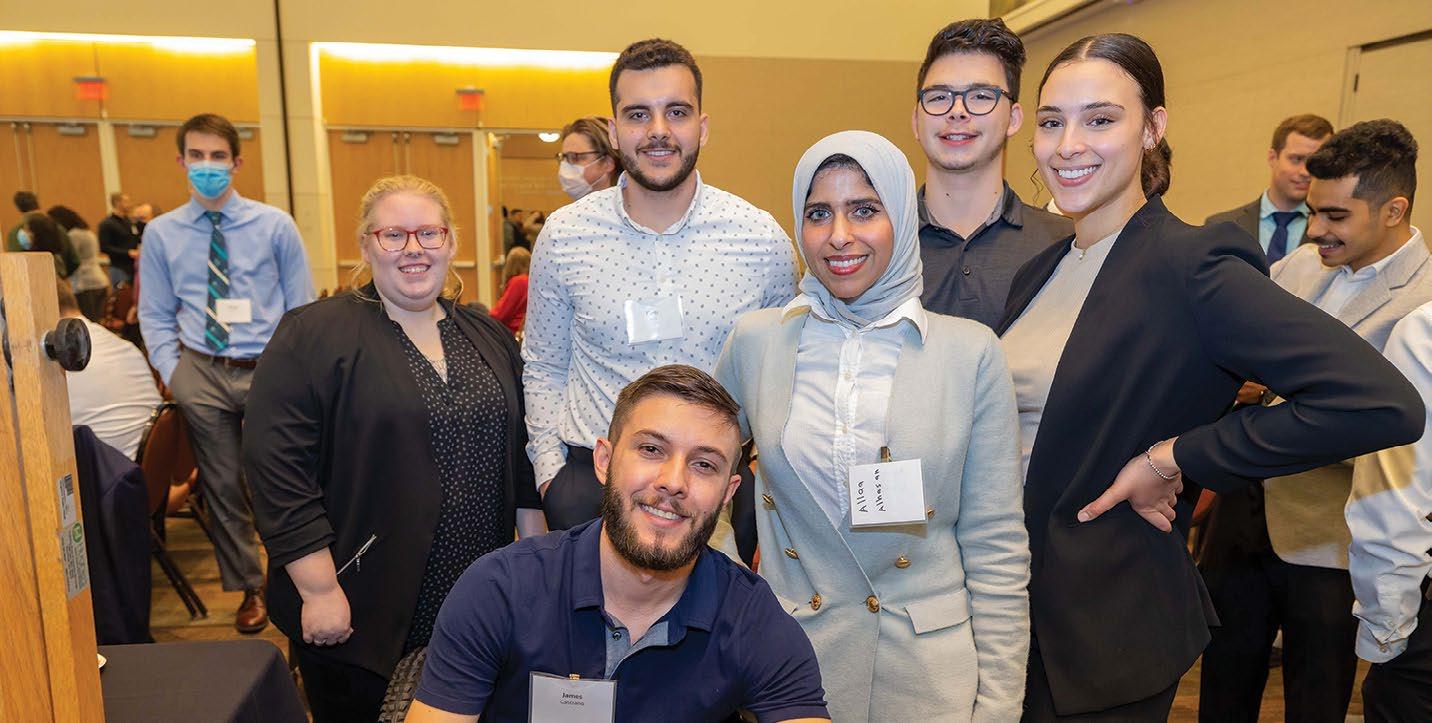
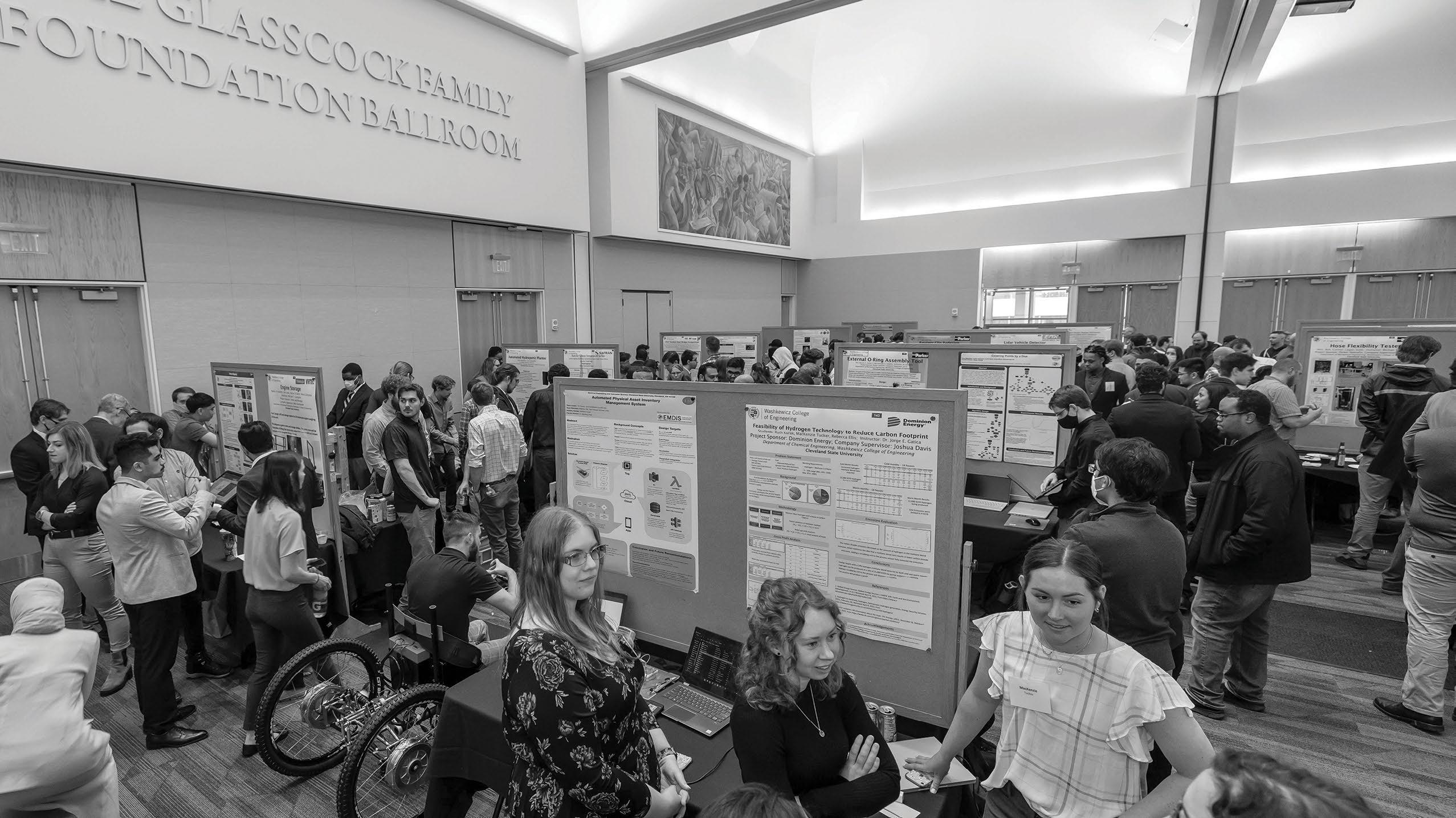
Students enroll in the Senior Design Capstone Course (Senior Design) the fall of their senior year—selecting their projects the second week of school and working on them in teams of three or four throughout the year until just before graduation in the spring.
Students develop a comprehensive project plan with a problem description, design alternatives, budget, equipment requirements, time schedule, final design and (in most cases) a prototype. They also produce a poster that graphically depicts the purpose, scope and details of the project.
By the time of the symposium, each student will have devoted around 200 hours to the project— up to 1,000 hours per team—
and will have developed a solution or solutions to a real-world engineering problem. The top three projects, as judged by a team of outside experts, earn cash prizes.
“From members of industry who attend the symposium or learn about our senior design projects, I have heard a resounding ‘Wow!’,” said Michael Adams, Ph.D., chair of the Engineering Technology Department and director of Senior Design.
Project: UAV-Aided Communications to Support Ground Networks.
Team:
“One of their main comments is about the breadth of the projects our seniors engage in, and the general sophistication of their work. [Industry] people tell me, ‘I wouldn't have imagined doing a project that indepth when I was an undergraduate’.”
Each year’s list of projects is divided into roughly equal thirds: industry-led, faculty-led and student-led projects. Industry-led projects match each team with a sponsor company that provides both a real-world challenge to solve and a project mentor.
Faculty-led projects, according to Adams, “generally center around improvements to our research facilities, or similar work that isn't considered research but more fundamental design.”
Student-led projects include national challenges, or student organizationbased activities such as the Society of Automotive Engineers (SAE) Baja car competition. Student inventors like Caleb Palagyi and his team (see “Timpan-E” page 33) are also encouraged to work on their own ideas.

CSU waives the rights to any intellectual property resulting from industry-led senior design projects— a rare thing in universities nationwide, according to Adams.
“By [CSU’s] releasing the intellectual property, companies feel more comfortable bringing real-world projects to the table,” said Adams. “That’s the important part. Companies get involved because if something were to be invented, they own the invention. They don’t have to license it back from the University.”
History bears out the value of this approach. Through the years, companies have filed provisional patents and utilized prototypes from several CSU senior design projects. Companies return year after year to sponsor projects, with some—like Parker Hannifin— sponsoring multiple projects in a given year.
Bogdan Kozul, Director of Motion Control Systems and Assistant Professor of Practice in the Department of Mechanical Engineering, has advised many successful senior design projects— notably four national-champion Fluid Power Vehicle Challenge teams (see page 32).
“The school has done a great job of including industry in many different projects,” Kozul said. “Students are getting mentored by some great engineers at world-class companies like MTD Products, Swagelok, Parker Hannifin and Rockwell Automation.”
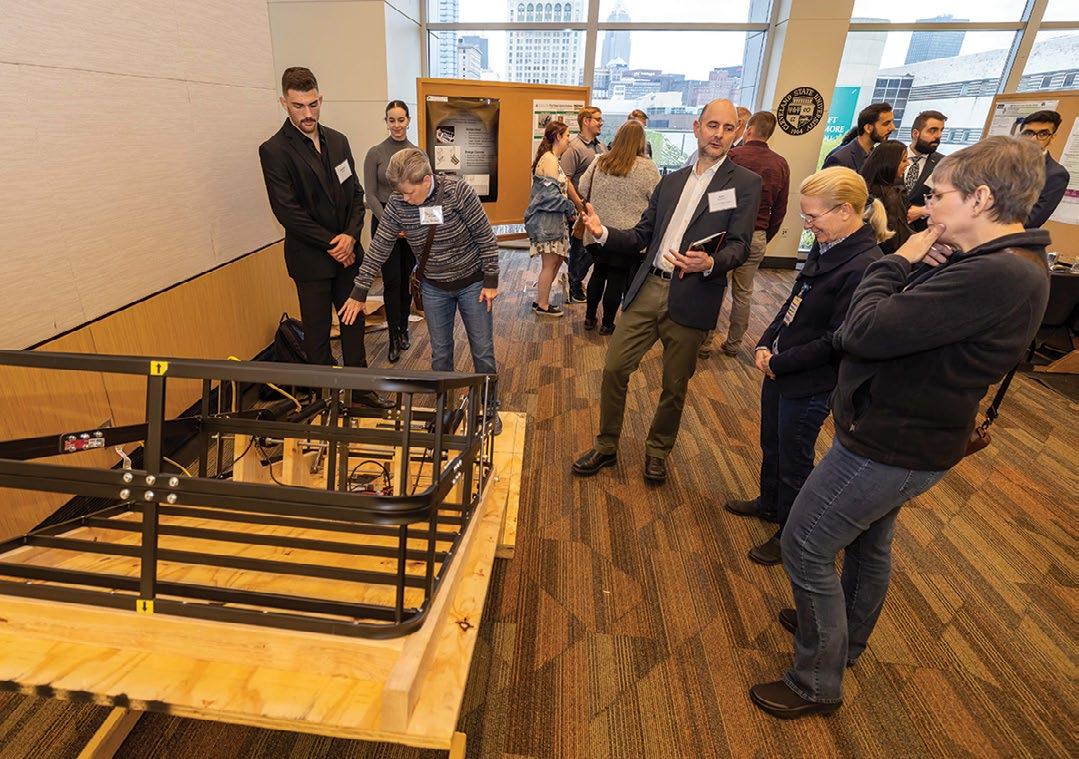
Senior design projects deeply immerse students in hands-on projects that are the hallmark of a CSU engineering degree. They also further develop the “soft” skills that students need to succeed in the workplace.
“We have listened to industry and external partners over the years,” said Adams.
“They’ve told us that what they look for in their employees—beyond the engineering degree that certifies basic competency—is soft skills, particularly teamwork, communication and project management. The senior design project generally, and the poster competition specifically, are part of that soft-skill development,” he added.
The day of the symposium, the students’ soft skills are on display along with their posters and any prototypes they have built. Students are on hand to discuss their posters, explain their projects and answer questions. Judges interact with the student teams, review the posters, look at the prototypes and fill out judging forms.
At the end of the event, the forms are tallied and the winners are selected.
TEAM
FACULTY ADVISOR: Bogdan
DEPARTMENT: Mechanical Engineering
SPONSOR: National Fluid Power Association
The 2022 Fluid Power Vehicle Challenge senior design project was the winner of both the CSU Senior Design projects and the National Fluid Power Vehicle Challenge. 2022 marked the fourth year in a row the CSU team has taken the national title.

The team’s recumbent bicycle broke records as the fastest hydraulicallypowered vehicle ever recorded at the competition, with a top speed of 50 mph. It was so fast, rider Eric Zielinski ran out of room to decelerate past the finish line and ended up having to drop the bike. Damage to the rider and the bike were immediately repaired in time for the next race—“an amazing team effort,” said faculty advisor Bogdan Kozul, that called on CSU’s “ready-to-go” engineering capabilities. In a gesture of good will and camaraderie, other teams also rushed to help their fellow competitors.
Senior Design Director Michael Adams, Ph.D. gives much of the credit for the team’s winning streak to Kozul, who worked at fluid power powerhouse Parker Hannifin before joining the CSU faculty in 2018. Kozul has been both an instructor for the Senior Design course and a mentor to the fluid power vehicle teams. “Part of the success,” Adams said, “is having that in-house knowledge of fluid power technology. Bogdan has been great.”
Kozul himself attributes the team’s success to the college’s state-ofthe-art facilities in the Dan T. Moore MakerSpace and the Parker Hannifin Motion Control Lab. In Kozul’s view, “the Motion Control Lab is one of the best fluid power labs in the world.”
He also encouraged prior-year students to come back and mentor the next generation of seniors entering the competition. It’s a way to share best practices from one year to the next, and it keeps alumni actively engaged with CSU.
“[The Fluid Power Vehicle Challenge] is a unique competition,” Kozul said, “because the team needs members who can fabricate, and who are technically strong to handle the rigor of the design and the circuits. They also need team members who are phenomenal athletes, because [the bikes are] human-powered. There are a lot of components to really be successful in this, and Cleveland State just puts a great product on the road every year.”
Competitors include some of the best fluid power programs in the country. Purdue University, for example, had two teams in 2022—one made up of undergraduate seniors and another of Ph.D. students.
“Participating in a competition with these great fluid power universities is a unique opportunity for our students and faculty to interact in a fun environment and see what we’re made of,” said Kozul.
MEMBERS: Michael Fugate, Robert Lenart, Sean McDermott, Jon Mieyal, Eric Zielinski
Kozul
FACULTY ADVISOR: Dr. Zhiqiang Gao
DEPARTMENT: Electrical Engineering and Computer Science
Timpani—the tunable orchestral percussion instruments sometimes called kettledrums—are cumbersome and expensive. A set of five drums can cost $25,000. Transporting them to a performance venue requires a large vehicle and strong muscles, and, as Caleb Palagyi (see article on page 26) and his three senior design teammates discovered through research, students learning to play the instrument can’t easily practice at home.
The team decided to fill an otherwiseunfilled niche in the commercial market for low-cost portable timpani by inventing electronic timpani for their Senior Design project.
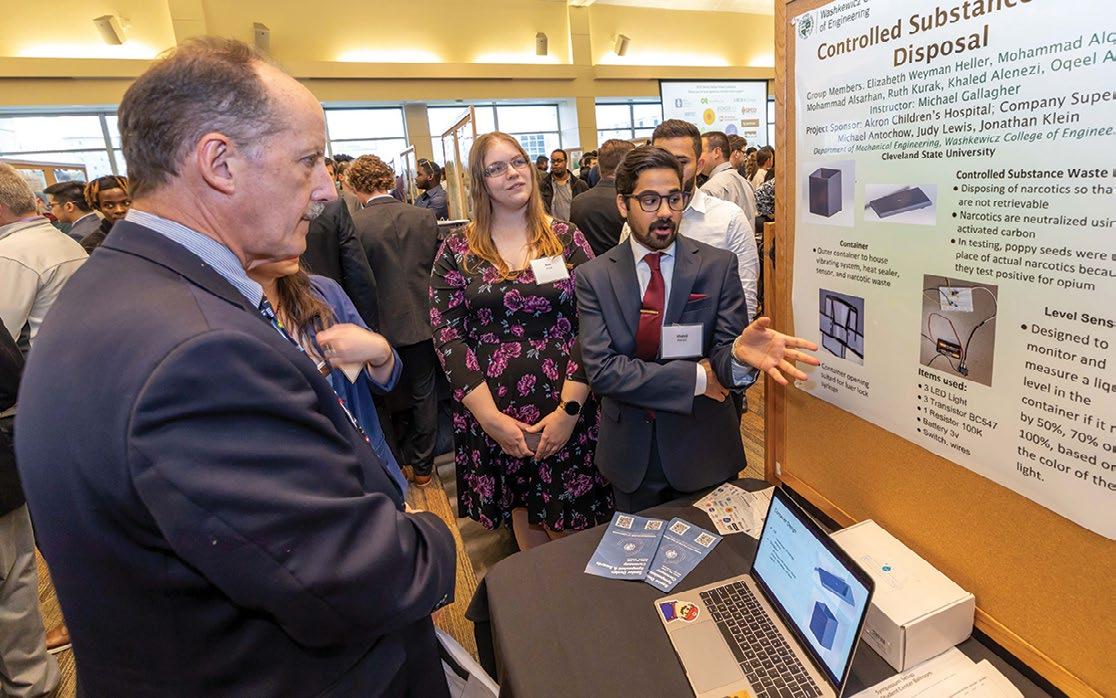

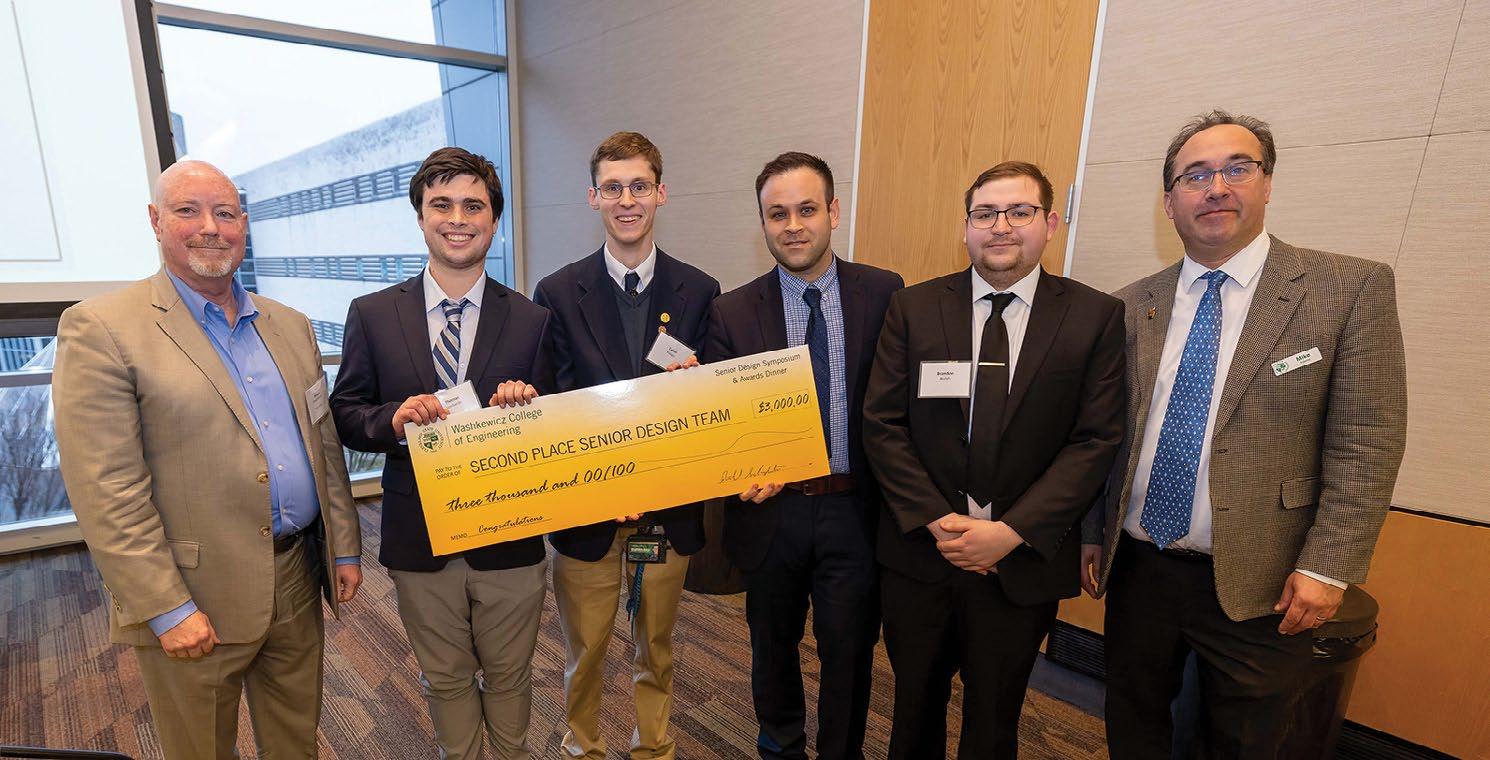
“Our goal was to try to create a low-cost system in small sizes especially for students, so they can carry their instruments home to practice,” said Palagyi.
Palagyi’s team devised a system of modular components using standard equipment such as a mobile phone or laptop computer, auxiliary speakers or headphones, and drum pads connected with USB cables.
Not only is the system portable and affordable (electronic components total around $250), it’s also modifiable. The timpani can be switched out for other instruments
such as gongs or chimes. Assembly doesn’t require custom tools or soldering because everything snaps together.
Moreover, the “Timpan-E” system accurately reproduces a musician’s unique performance style, and backlit drumheads change color corresponding with the pitch of the drums, giving performers visual feedback cues.
MEMBERS: Brandon Bolish, Thomas Lombardo, Caleb Palagyi, Kevin Stropki Project: Controlled Substance Waste Disposal. Sponsor: Akron Children's Hospital. Front (left to right): Dr. Brian Davis, Elizabeth Weyman Heller, Ruth Kurak, Khaled Alenezi; Rear right: Mohammad Alsarhan; Not pictured: Mohammad Alqatnab, Oqeel Alramzi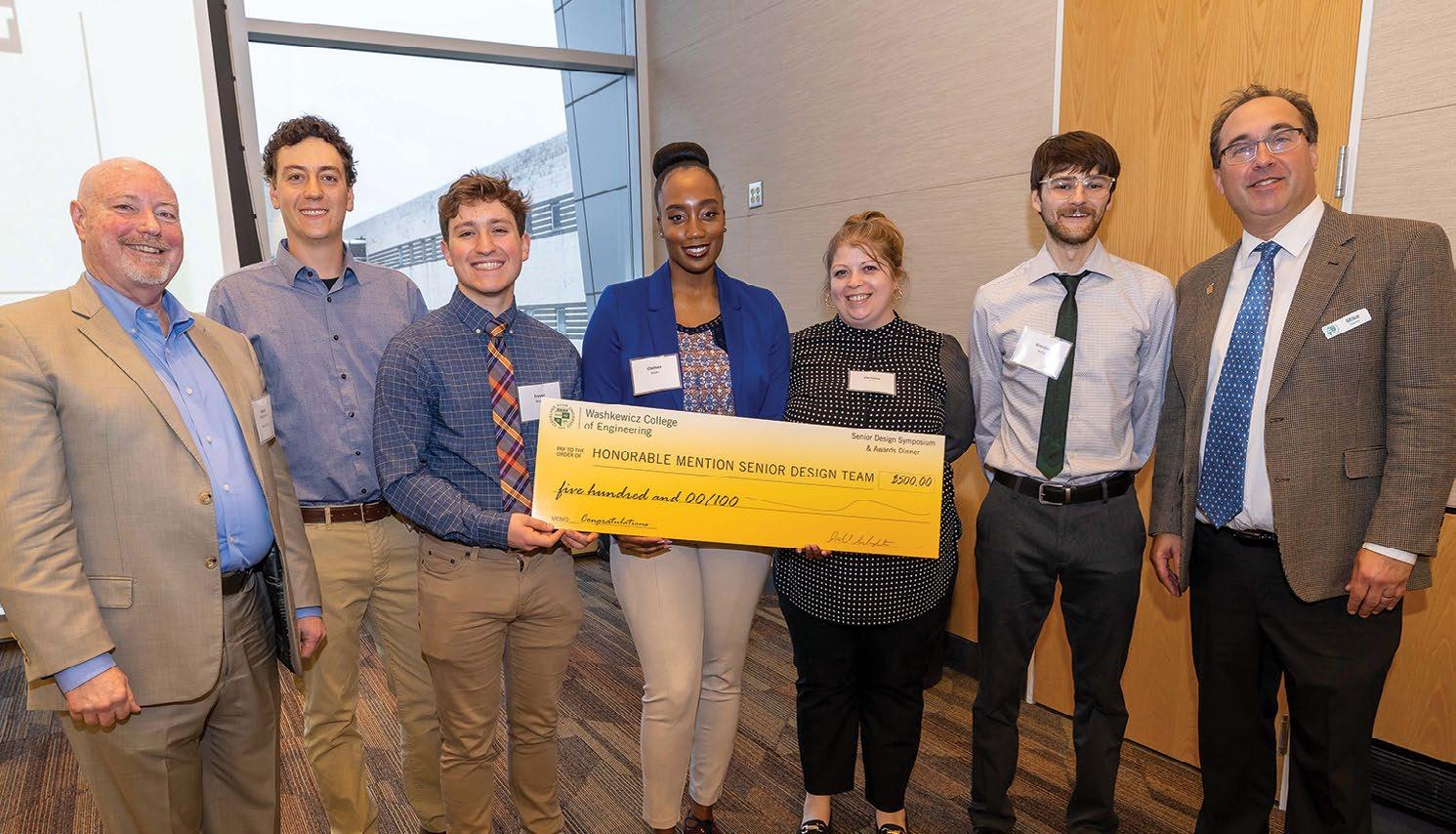
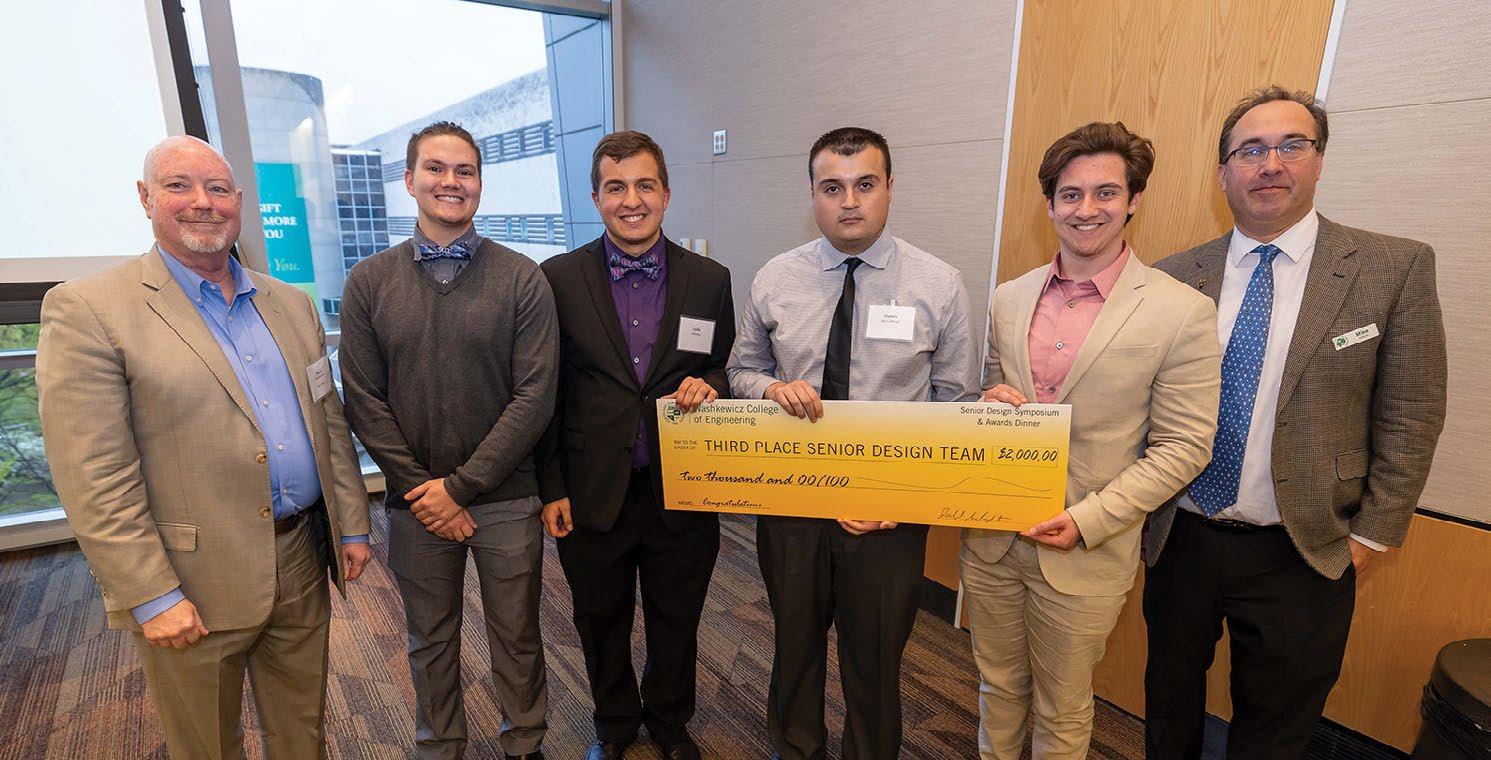
Parker Hannifin presented this team with one of the company’s persistent manufacturing problems: how to install o-rings over machined metal threads without damaging the o-rings and without causing strain, fatigue or possible injury to employees assembling the parts.
The team’s solution: automate the process by building a robotic device to install the o-rings without damaging
them. Through their design and calculations, the team developed a prototype that can be manufactured easily, adapted for future use, and produced at relatively low cost. The team’s external o-ring assembly tool can be made on a 3-D printer using inexpensive filaments. It is easily modifiable for increased user safety and future product modifications, and is made using widely available electronics.
Faculty advisor Michael Gallagher said of the team and its final product: “Among the many strong aspects of this project, the electrical, electronic and programming work performed by four mechanical engineering students was particularly impressive.”
Many ancient wildlife migration corridors in the U.S. are intersected by high-traffic roadways, and more than one million wildlife-vehicle collisions occur every year. Tens of thousands of people and countless animals are killed and injured, according to a report from the U.S. Department of Transportation.
For the 2022 Student Steel Bridge Competition, students were tasked with designing a steel bridge to enable migrating wildlife to cross safely over a highway. Teams had to demonstrate
a balance of structural design and construction engineering.
Structural design: All bridge components had to be below the level of the deck. A dynamic design was required for a cantilevered end and six possible load cases.
Construction engineering: Construction of the bridge could not occur within the highway zone. The construction team was divided on either side of the highway, so the design required strong
TITLE: 2022 Student Steel Bridge Competition
TEAM MEMBERS: Ryan Giering, Chelsea Hicks, Brendan Kelly, Trevor Neece, Christina Ortiz
FACULTY ADVISOR: Christopher Huhnke, Ph.D.
DEPARTMENT: Civil and Environmental Engineering
SPONSOR: ASCE CSU, Great Lakes Construction Co., R.E. Warner & Associates, SGA CSU: Emry Hollopeter (ASCE CSU), Ryan O’Hearn (R.E. Warner)
communication and coordination when sections of the bridge were joined above the highway zone.
Results: The team prioritized efficiency of material and ease of fabrication, and came up with a design featuring two layers of Warren trusses. They competed against 10 other university teams, and earned first place for lightness, second place for both structural efficiency, and stiffness.
Honorable MentionDEPARTMENT:
Car and Driver Magazine called it the “Alice in Wonderland of car racing,” and “Halloween on wheels.” Since its maiden event in 2006 at Altamont Speedway in California, 24 Hours of Lemons (a pun on 24 Hours of Le Mans, the 100-year-old international endurance race) has become a cult classic. Competitors’ cars cost $500 (not including safety equipment) and may be kitted out to resemble sharks, pirate vessels, wienermobiles or viking longships.
Lap times don’t really matter and costumes are absolutely encouraged.
Entering this parallel universe of motorsports also makes for a challenging Senior Design project— best undertaken with a strong dose of humor, as five seniors discovered last year.
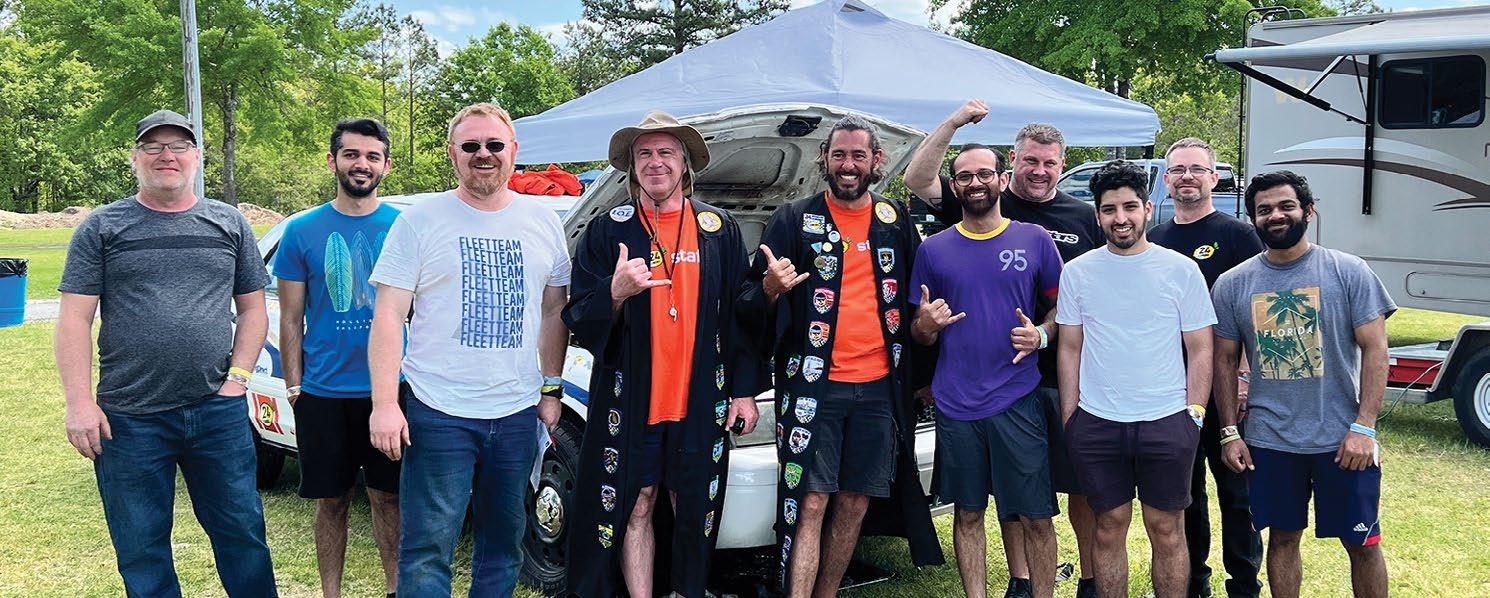
Team Leader Catalin Chindea, with a total of 12 years of experience as a mechanic in the U.S. military and working for a military contractor, says the team came up with their theme when they purchased a Ford Crown Victoria sedan from Craigslist.

“Because ‘Crown Vics’ are cop cars,” he said, “and because all of us were from different countries, we decided it was an international police car. That’s how we came up with the name Team Interpol.”
The goal of the 24 Hours of Lemons Race is to complete as many laps as
possible in two, 12-hour days. Team Interpol set additional objectives for itself, including passing inspection on the first try and achieving a speed of at least 85 miles per hour.
As the year wore on, the team began to wonder if they’d be able to start the car, let alone hit 85 mph. They faced a number of daunting challenges.
Lingering effects of the COVID-19 pandemic, for example, caused delays in obtaining parts, and lost the team their sponsorship for a 3-D printed control arm. An unscrupulous seller neglected to mention that the Crown Vic had a blown engine that needed to be rebuilt, and the required safety gear—roll cage, helmets, gloves, fireproof suits and the like—that ended up costing more than the team had originally budgeted.
With the race scheduled for April 23–24 in Kershaw, South Carolina, Team Interpol had to take the engine completely apart and put it back together the night before they left Cleveland.
“We went to the race with the vehicle on a trailer, not knowing whether it was going to run because just a day before, it was in 154,000 pieces lying on the floor,” Chindea said.
Long hours, hard work and strong project management skills (faculty advisor Michael Gallagher called Team Interpol’s Gantt chart one of the best
he’d seen) helped the team overcome their challenges.
The car didn’t start the first time they cranked it at the race track, but they juiced up the battery with a jump and got it running. They passed inspection on the first attempt, and the car ran for an hour—long enough for everyone on the team to do a few laps. Chindea said that while he got the car up to about 94 mph, “that caused us to spin out and get flagged. Then I kind of freaked out because the car had no brakes.”
Team Interpol never expected to work so hard nor spend so much money on their senior design project. “There was a lot we weren’t expecting,” finalized Chindea.
“But it’s a good lesson learned. We all learned a lot about project management. We all feel like we have achieved something in terms of engineering, and we accomplished something on a personal basis, too.”
24 Hours of Lemons Race–Team Interpol TEAM MEMBERS: Catalin Chindea, Daanish Iqbal, Salah Lamsettef, Milan Tailor, Mihir Vasoya FACULTY Michael Gallagher Mechanical Engineering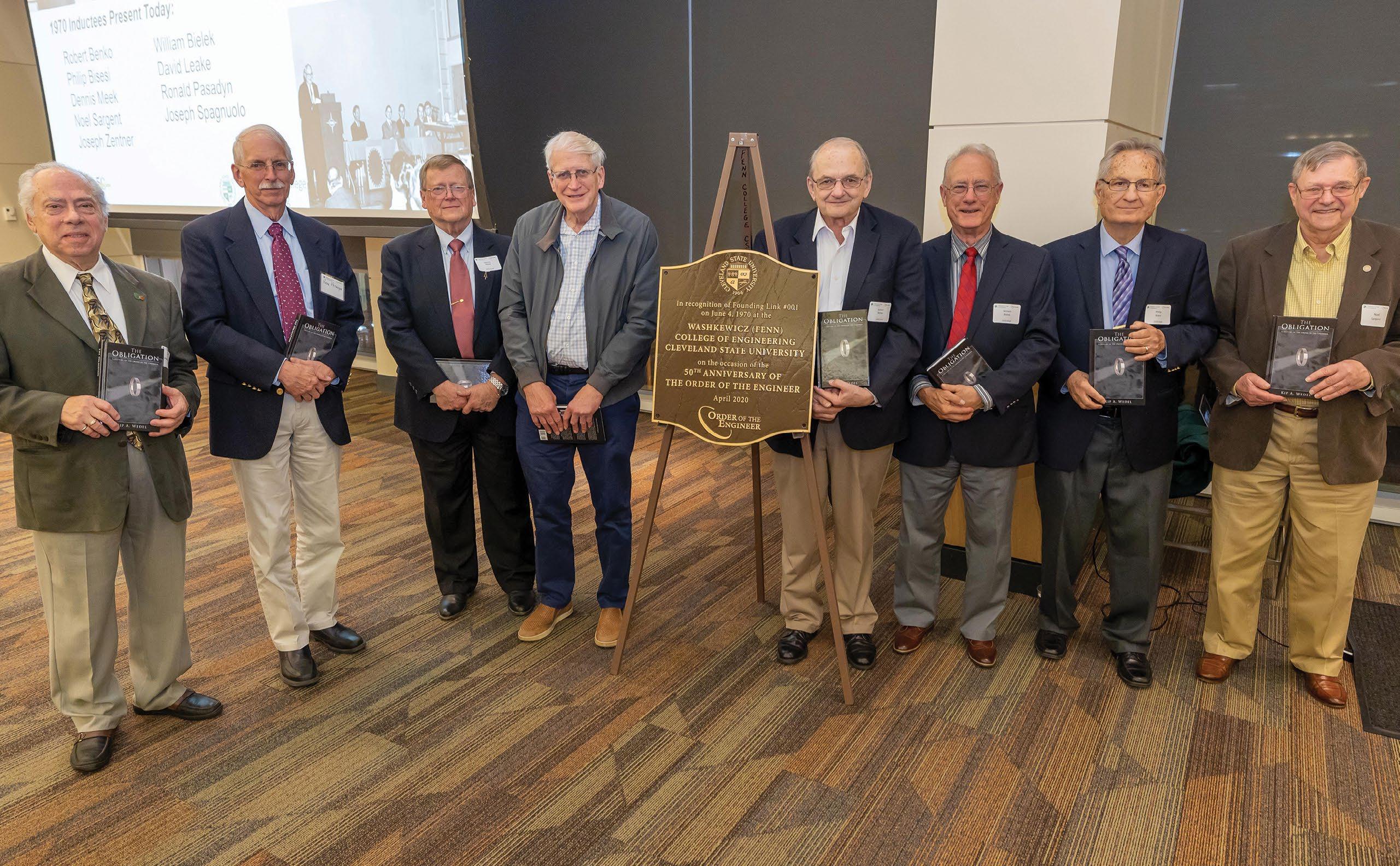
The Obligation of the Order of the Engineer is to engineering what the Hippocratic oath is to medicine: a solemn vow by practitioners to uphold the highest professional standards. While doctors swear to “first do no harm” and to maintain patient confidentiality, engineers vow to serve humanity and to practice “integrity and fair dealing, tolerance and respect.”
Ancient Greece was the birthplace of the Hippocratic oath, sometime around 400 B.C. Cleveland State University’s Fenn College of Engineering was the birthplace of both the professional society known as the Order of the Engineer and the Obligation pledge. That landmark event took place June 4, 1970.
Since the time when 170 Fenn College students and faculty took the first-ever Order of the Engineer oath and accepted the steel ring signifying membership in the society, more than half a million engineers from nearly 300 Links, or chapters, have joined the Order and pledged to use their skills to protect the health, safety and welfare of the general public.
Above: Memeber of the 1970 class (left to right): Joseph Spagnuolo, Ronald Pasadyn, Dennis Meek, Joseph Zentner, Robert Benko, William Bielek, Philip Bisesi, Noel SargentTo mark the 50 th anniversary of the founding of the Order of the Engineer, the Washkewicz College of Engineering hosted a daylong celebration last April that included an Ethics Symposium, a Link Induction Ceremony and a Celebration Banquet. The event was delayed two years due to the coronavirus pandemic.
“
Nearly 100 people attended the evening banquet—most of whom traveled from out of town. Nine of the attendees were original 1970 inductees: Robert Benko, William Bielek, Philip Bisesi, David Leake, Dennis Meek, Ronald Pasadyn, Noel Sargent, Joseph Spagnuolo and Joseph Zentner.
“It’s humbling to be here for the 50 th Anniversary,” said Sargent of the event. “Sitting here with the same ring on, I look back on how much has changed since 1970.”
The pride that the faculty and staff at CSU feel for their part in the history of the Order is palpable in their vigorous and long-standing support of this important organization and what it means to our profession nationwide…
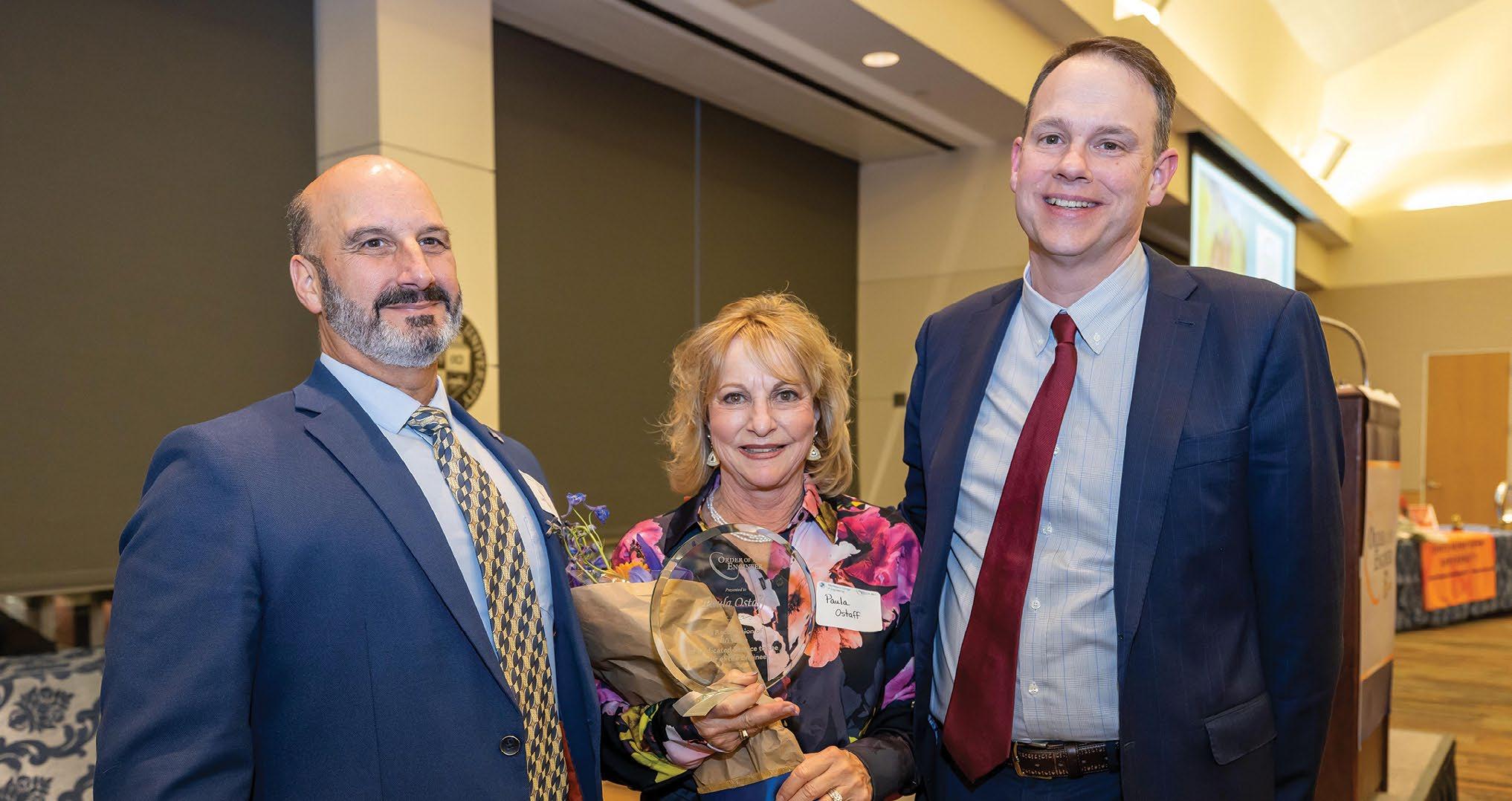
We thank all those at Link 001 for allowing us to participate in [a] wonderful celebration of this once-in-a-lifetime historical event.
”
—Roch D. Larochelle, PE, F.NSPE
Past Chairman, National Board of Governors The Order of the Engineer
Board/Staff (left to right): Roch Larochelle, Past Chairman, Board of Governors, Order of the Engineer; Paula Ostaff, Executive Director, Order of the Engineer; Steven Schreiner, Chair, Board of Governors, Order of the EngineerThe Order is not a membership organization with meetings and dues, but it fosters among engineers a unity of purpose and a strong sense of professional ethics for life.
In the earliest days of the Order of the Engineer, civil engineers most notably carried the torch of ethical practice. Today, technological advances such as computer-controlled implantable devices and self-driving automobiles require all disciplines to share the responsibility, whether in academic, governmental or corporate settings.
The Ethics Symposium, therefore, was a key part of April’s 50 th Anniversary Celebration. Arthur Schwartz, Deputy Executive Director and General Counsel of the National Society of Professional Engineers (NSPE) moderated the discussion with a panel of national speakers from a variety of engineering disciplines.
Speakers included:
• Ben Amaba, Ph.D., Chief Technology Officer, IBM Data Sciences
Saying Artificial Intelligence is no longer science fiction but science fact, Amaba addressed the topic of the “Engineer’s Role in Artificial Intelligence and Technology.” He said the industrialized community has been using data analytics for some time, and urged engineers and developers to hasten the progress.
• Brian Davis, Ph.D., Professor and Associate Dean, Washkewicz College of Engineering, Cleveland State University
In discussing “Medical Device Failures, Ethics and Cost,” CSU’s own Davis cited well-known medical device failures and lawsuits, such as the Johnson & Johnson baby powder case, where 38,000 lawsuits were blocked by spinning them off to a separate company. He also discussed Theranos CEO and founder Elizabeth Holmes, who used fake data to build her company, and he cited the case of Stevie Wonder, who as a newborn was exposed to too much oxygen in the incubator, resulting in detached retinas and blindness.
• Michael C. Loui, Ph.D., Professor Emeritus, University of Illinois at Urbana-Champaign
In discussing the topic “Ethics in Engineering Education,” Loui cited the Challenger spaceship explosion, the Kansas City Hyatt disaster and the Ford Pinto case. “Ethics is not just avoiding evil,” he said, “but also doing good. Engineering ethics can be taught.”
• Deborah Wells, Then-Deputy Program Manager, AECOM, Kennedy Space Center (now Human Space Flight Technical Integration Contract Manager for Orion Program, Barrios Technology, LTD)
Wells addressed the topic of “Commercial Human Space Flight,” citing four companies currently at the forefront of space exploration: Axiom Space (ISS Module), Blue Origin, Northrop Grumman and Nanoracks. She also discussed the current status of the United States Space Force, founded in December 2019.
It’s humbling to be here for the 50th Anniversary. Sitting here with the same ring on, I look back on how much has changed since 1970.
—Noel Sargent, CSU alumnus and original inductee of the Order of Engineer in 1970
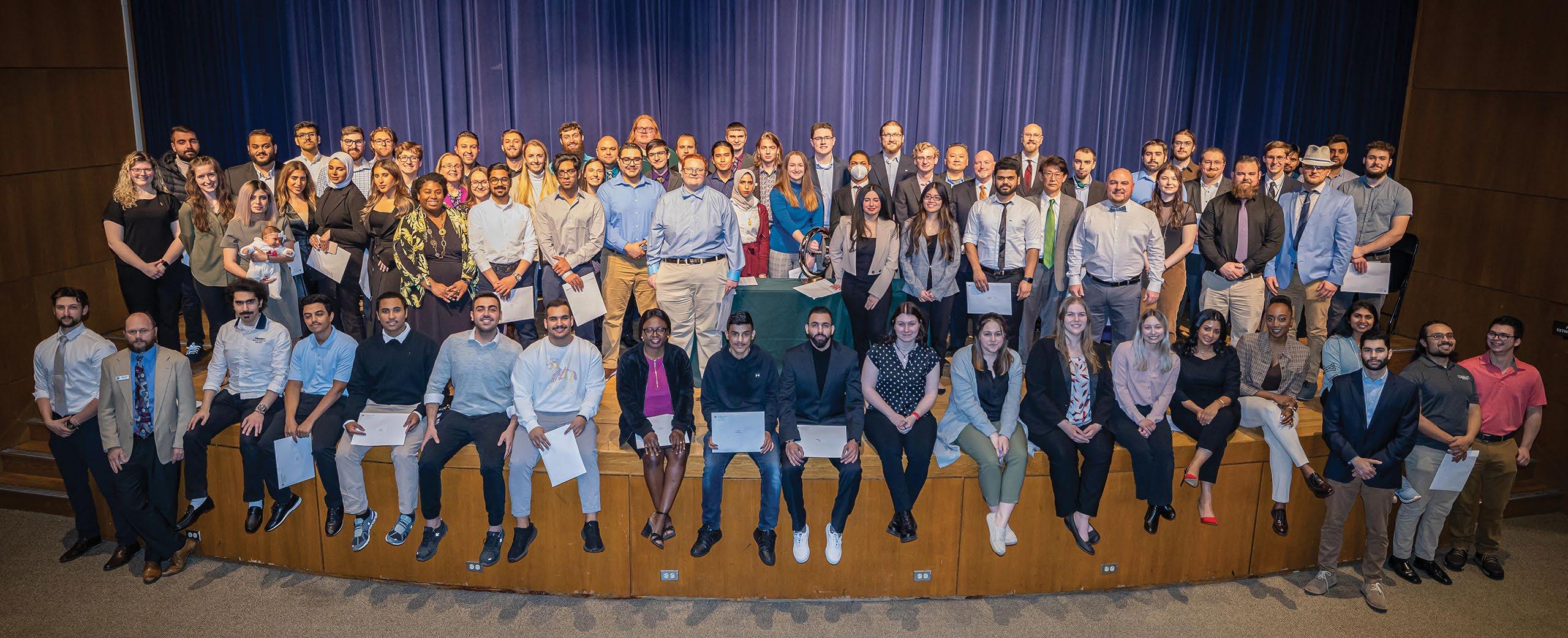
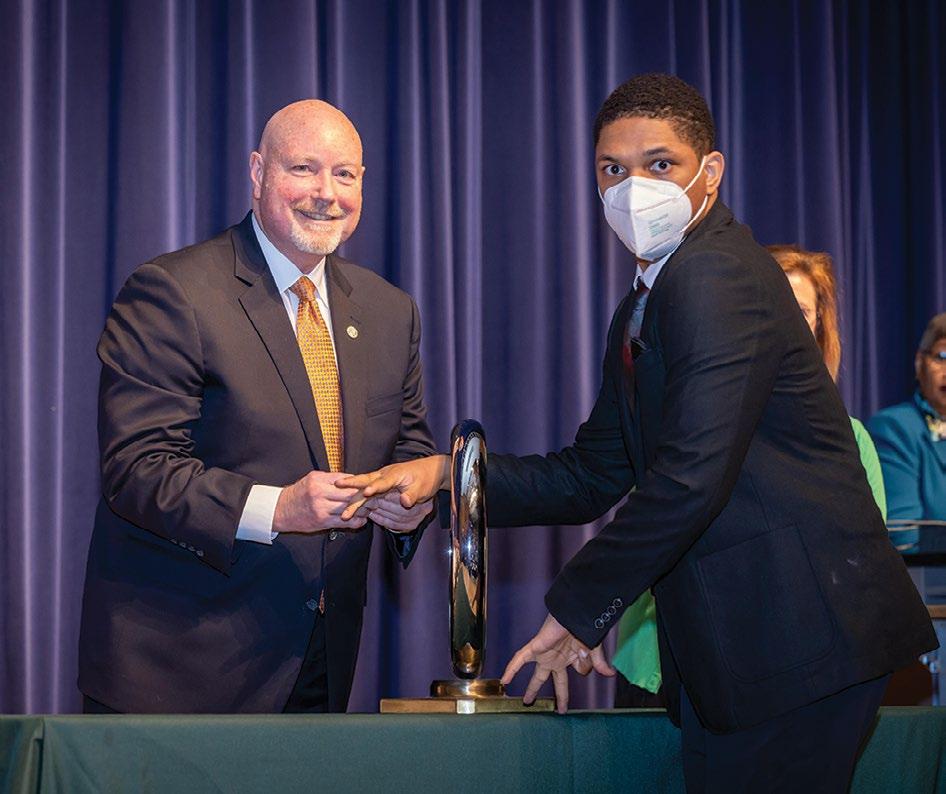
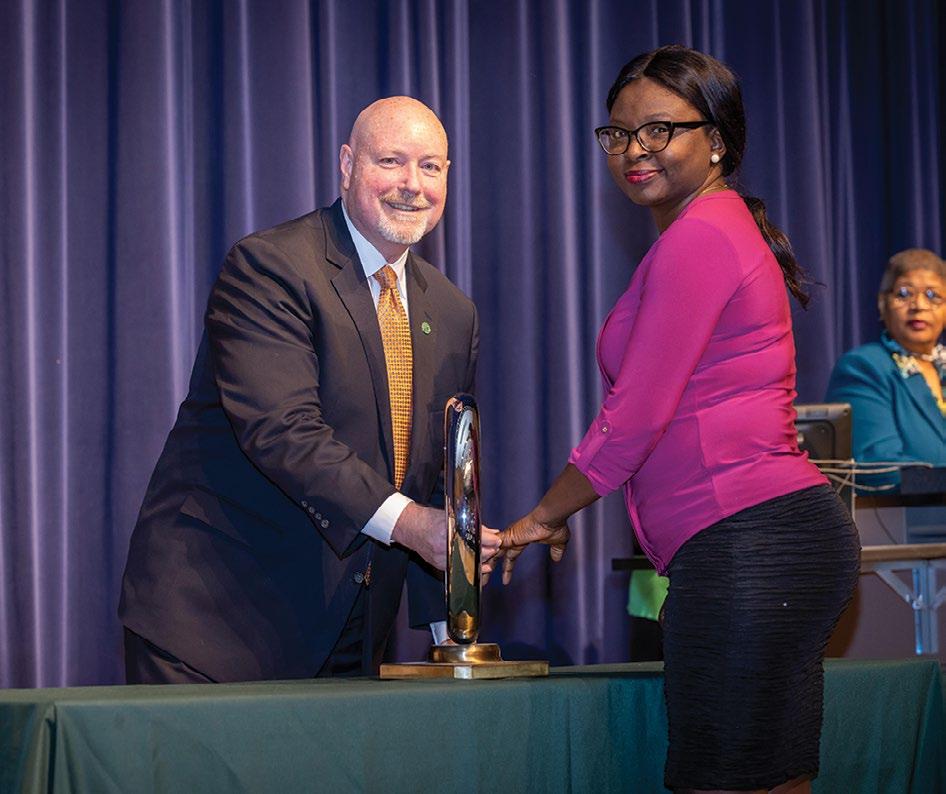
Following the Ethics Symposium, the Link Induction and Awards Ceremony took place for undergraduate and graduate students. Moderated by W.C. Vance, Manager of Engineering Student Programs, the ceremony began with an address by Dean Richard T. Schoephoerster, a presentation by valedictorian Caleb Palagyi and the awarding of 45 honors to students and faculty in the engineering disciplines.
The program concluded with induction ceremonies for both the Order of the Engineer and the related Pledge of the Computing Professional. Ninety-six students recited one or the other pledge.
Bukola Adesanmi, M.S. Environmental Engineering, Ph.D. Candidate, Chemical Engineering Dawud Hamzah Sharrieff, Cum Laude B.S. Mechanical Engineering, Mathematics minor. Currently studying M.S. Biomedical Engineering.Our leaders should be engineers and our engineers should be leaders.
”
Dean Richard Schoephoerster, Washkewicz College of Engineering, Cleveland State University
“
In the Age of Information, data is the new oil—the valuable raw material that fuels the digital world. Artificial Intelligence (AI), the internet of things (IoT), cloud computing, and superfast networks like 5G all burn data to produce results.
Massive amounts of raw data are constantly being generated at an accelerating rate—by a growing multitude of sources such as the internet, cellphones, sensors, payment systems, cameras and more. The result is that around 45 zettabytes of data exist in the digital universe today, with each zettabyte equal to one trillion gigabytes.
All that raw data represents a vast reserve of potential value to researchers, business leaders and policy makers. But extracting value from it means handling data sets so large and complex they cannot be processed with traditional methods—and the emerging methods are constantly evolving.
Data scientists manipulate massive, complex data sets into usable end-products, in high demand across all economic sectors, and are in short supply. Glassdoor has named data scientist the number-one job in the U.S. for the last four years. The IBM Corporation expects the number of data science job openings to grow more than 5% annually for the foreseeable future.

Professor Chansu Yu, Ph.D. in the College of Engineering’s Department of Electrical Engineering and Computer Science (EECS) cites the U.S. Bureau of Labor Statistics, which says the demand for data science skills will drive a 27.9% rise in employment in the field through 2026. “Addressing this critical shortage,” Yu said, “[will] help shape the region and beyond.”
The new breed of data expert requires a unique academic pathway to prepare for the ever-evolving demands of data science. Data scientists use a wide range of tools and techniques for evaluating and preparing data— everything from SQL, data mining and data integration.

The demand for data science skills will drive a 27.9 % rise in employment in the field through 2026.
U.S. Bureau of Labor Statistics
To meet the growing demand for data scientists, and to build the data science capacity of businesses and health care organizations in Northeast Ohio, CSU launched a new bachelor's degree program in data science this fall. Jointly developed by the EECS Department and the Mathematics and Statistics Department in the then-College of Sciences and Health Professions the data science program is housed in the Washkewicz College of Engineering.
CSU’s new data science bachelor's degree program ramped up almost immediately. Two previous faculty members were appointed to new roles in the department: Sunnie Chung, Ph.D. and Jackie Woldering, Ph.D. Two new faculty members were hired: Qin Lin, Ph.D. and Sujan Poudyal, Ph.D. (see pages 4–7 for their bios). Plans call for the program to grow to 150 students by 2026.
College of Engineering Dean Richard Schoephoerster expects the new data science program to grow “by leaps and bounds” and that the college is “already looking at expanding to the graduate level in that area.”

Even before the advent of the new bachelor's degree program, CSU’s Big Data Lab, headed by Chung, yielded “really strong, positive” student success. Chung said that students she’s worked with in the lab have been hired by Google, Amazon, Facebook and Yelp, as well as major Northeast Ohio employers such as FirstEnergy, Hyland Software, Parker Hannifin, Rockwell Automation, SherwinWilliams, Progressive Corporation and the Cleveland Clinic.
Hongkai Yu, Ph.D. Assistant Professor, EECS, teaching Data Science course.

“Every industry needs big data technology and big data-related knowledge and skill sets,” said Chung.
The new bachelor's program—and any potential graduatelevel programs in the future—will help CSU fulfill its commitment to the JobsOhio-funded Cleveland Innovation District. JobsOhio established the Innovation District to make Northeast Ohio and the state more attractive to business and more competitive in the health care and IT sectors.
The consortium is a $565 million effort focused on research, training and talent development in urban health care, emerging technologies, life sciences, data-intensive fields, emerging biological threats and epidemiology. CSU’s role is to recruit, educate and graduate the skilled talent needed to fuel growth in these fields.
In addition to the new bachelor's degree program in data science, the EECS Department also added a graduate certificate in cybersecurity technology. It covers cybersecurity fundamentals and provides practical security skills from legal and business perspectives.
Current graduate students can earn the certificate while they earn their graduate degrees. Local IT professionals can also apply to earn certificates.
According to Haodong Wang, Ph.D., Master of Computer Science Program Director and Associate Professor in the EECS Department, the catalyst for the certificate was “the persistence and aggressiveness of security attacks. There is a great demand for cybersecurity professionals. The EECS Department has frequently received inquiries for a cybersecurity certificate program.”
Above: EIF Summer Camp attendees visiting NASA Glenn Research Center.

Across the nation and the state of Ohio, the statistics for many colleges of engineering are grim. The U.S. has fewer college-aged students today than a generation ago. Of those, fewer go to college, and fewer still pursue engineering.
Some of Cleveland State University’s closest competitors have seen year-over-year drops in freshman engineering enrollment—in some cases, drops of 19% or more.
How, then, has the CSU Washkewicz College of Engineering managed to buck these trends and grow its first-year enrollment?
One answer is CSU’s Fenn Academy, a consortium among the college, local school districts and industry partners designed to encourage high school students to pursue post-secondary education and careers in engineering.
According to W.C. Vance, Manager of Student Programs and Assistant Director of the Fenn Academy, outreach to students in Ohio high schools is one of the Academy’s main activities. Up to three days a week during the school year, he visits advanced physics and chemistry classes at high schools as far west as Sandusky, as far south as Ashland, and as far east as Chardon.
At each visit, he spends the day giving presentations on careers in engineering, explaining the different engineering disciplines and demonstrating how chemistry and physics are used to design products and solve problems. He likes to use “gizmos” such as a wearable device called a HERT vest that helps emergency responders train for catastrophic medical events, and “magic tricks” that have math and science solutions. He also likes to talk about “the geometry of the isosceles triangle and how it's useful in designing everything from bridges to heart catheters.”
Fenn Academy also offers daily laboratory tours in conjunction with campus tours. Anyone who visits CSU is encouraged not just to walk around campus with a host student, but to spend time in the Washkewicz College of Engineering.
“When high school students come here and indicate an interest in engineering, we're connecting them with students and professors in the labs,” said Vance. “We’ve got a whole team here focused on bringing students into our College of Engineering.”
Another key component of the Fenn Academy is the Engineer for a Day Job Shadowing Program. Every February during National Engineers Week, the program sends students in grades 10–12 on half-day visits to local manufacturers or other engineering-related organizations. Students get a real-life glimpse of what a career in engineering might entail.
They might even end up with a career. “Last year, a vaguely familiar guy came up to me outside of work and said, ‘About 20 years ago, you placed me for Engineer-for-a-Day with the Dana Corporation. The guy I shadowed ended up hiring me for a co-op. That turned into a full-time job, and I'm still working for the guy,” Vance recalled.
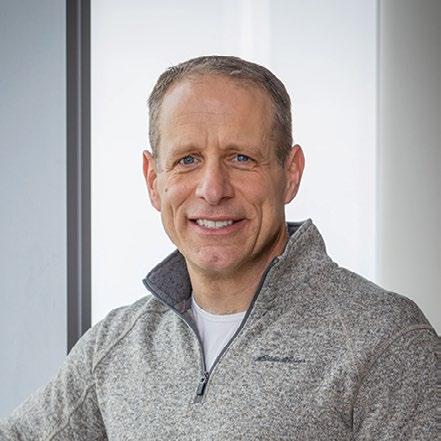
Fenn Academy is also home to BEST (Bridging Engineering, Science and Technology) Medicine, Northeast Ohio’s premier engineering fair. Chaired by Professor Brian Davis, Ph.D., the fair is devoted to students interested in biomedical or environmental engineering. It also provides workshops for high school science teachers, such as the nanotechnology workshop presented by the research team of Geyou Ao, Ph.D. (see page 12 for more information).
The fair, the outreach, the job shadowing, the lab tours—all the activities of the Fenn Academy are aimed at getting high school students and their teachers excited about engineering, and about earning an engineering degree at CSU. “So far, it's working, as we knew it would,” said Vance.
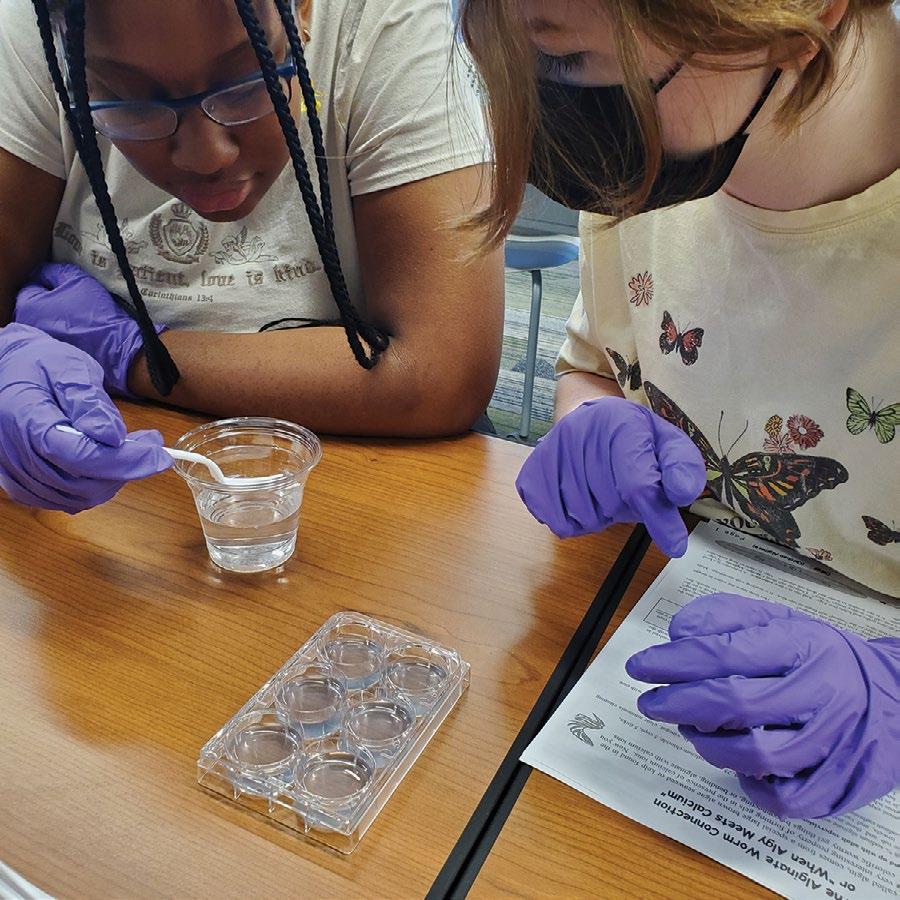
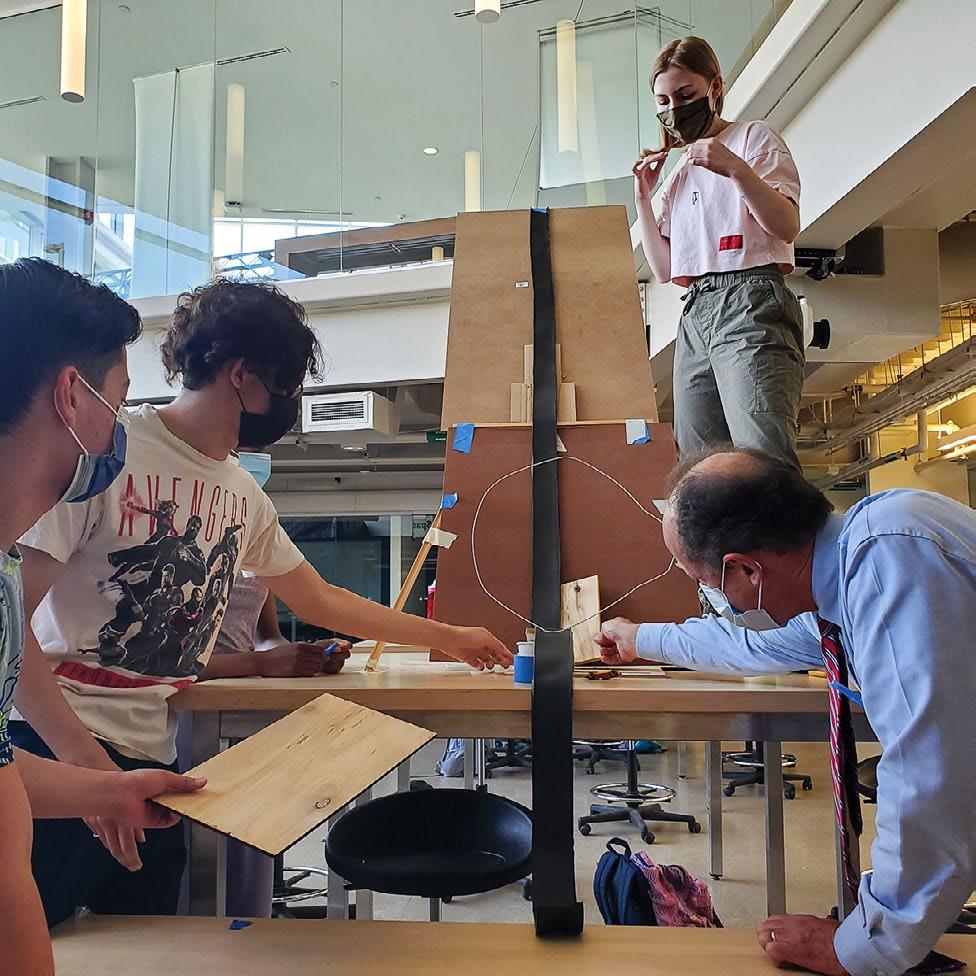
"When high school students come here and indicate an interest in engineering, we're connecting them with students and professors in the labs."
—W.C. Vance, Manager of Student Programs and Assistant Director of the Fenn Academy
Fenn Academy offers daily laboratory tours in conjunction with campus tours. Anyone who visits CSU is encouraged not just to walk around campus with a host student, but to spend time in the Washkewicz College of Engineering.Hyland Software, Inc. Summer Camp
The way Neil Rothman describes it, he practically stumbled into earning a bachelor’s degree at Washkewicz College of Engineering predecessor Fenn College. As a Parma teenager in the 1960s, he thought college was for other people. No one in his immediate family had gone to college. His father never even finished high school, and money was tight.
“I had no concept of college,” Rothman said. “I had no idea what a college prep curriculum was. I just signed up for classes that interested me. I was very good in math, but I never did take physics in high school.”
Little did he know, he would go on to earn not just a B.S. in Electrical Engineering at Fenn College in 1970, but a host of credentials at other schools as well: an M.S. in Public Administration from Troy University, another B.S. in Computer and Information Science (also from Troy), and another M.S. in Information Systems (MIS) Technology from Hawaii Pacific University.
Even less did the teenaged Rothman imagine that one day, he and his future wife would leave a legacy enabling other aspiring electrical and computer engineers to obtain degrees from his Cleveland alma mater. That is exactly what they did, however, when they established the Neil F. and Linda B. Rothman Endowed Scholarship Fund in 2021 with $150,000 in outright, immediate-use funds and $350,000 in planned estate funds.
Sometime around Rothman’s junior year in high school, a chance encounter with student-engineers from the General Motors Institute introduced him to the concept of a co-op engineering education. The possibility of putting himself through college while working appealed to him. The chance to live at home while working and going to school is what made him choose Fenn College.
Rothman spent all seven of his co-op engagements with the Republic Steel Corporation—the first three in the manufacturing plant and the remaining four in the Electromechanical Research Laboratory. When he was attending classes, he earned extra money working in the audio-visual department on campus.
Because the co-op program was so critical to his own education, Neil and Linda decided their scholarship fund would give preference to students enrolled in co-op opportunities.
“I figured [students are] in the co-op program because they are helping to fund their own way through school. I like that, probably because that’s how I did it,” Rothman said.
After graduation in 1970, Rothman had hoped to continue working at Republic Steel, but he was drafted into the U.S. Army. He opted instead to enlist in the United States Air Force, and was later commissioned through
the Officer Training School. Then in 1973, he attended Navigator Flight School and followed that with more advanced Electronic Warfare Officer (EWO) School, which took advantage of his electrical engineering skills.
After graduating from EWO school, Rothman selected the F-4 Phantom II fighter aircraft as a Weapon Systems Officer to begin his operational flying career. By the time he retired from the Air Force at the rank of Major, Rothman’s 20-year career encompassed flying assignments in California, Thailand, Japan, Korea, Taiwan, Florida, the Philippines and Hawaii.
In his final three years, he was responsible for maintaining the military Electronic Order of Battle for the vast Pacific Command region.
After Rothman retired from the military, he went on to earn his M.S. at Hawaii Pacific University. In 1992, he began working for the Hawaiian Electric Company, where he served in various Planning Engineer positions for 17 years.

Despite his three degrees from two other universities (not to mention Linda’s allegiance to Louisiana State University), Rothman says Cleveland State University was the only school where they considered endowing a scholarship. Looking back 50 years, he sees what a valuable education he received at CSU—one that transformed his life prospects and opened doors.
Neil said he and Linda hope that by establishing the Rothman Endowed Scholarship Fund, “future engineering students will benefit by it and maybe they'll pay it forward later on in their careers.”
Neil and Linda met while he was stationed in Florida and she was working at an Okaloosa County job placement program. They married in 1977, and in 1981, they moved to the Philippines along with Leslie, his daughter from a previous marriage, and Stephanie, Linda’s daughter from a previous marriage.
Linda, too, worked for the Air Force, as a civilian. First, she coached the Clark Air Base swim team in the Philippines, and later, she served as a Flight Safety Computer Analyst in Hawaii. The training manual she developed in that role was used by all safety commands throughout the Air Force and earned her the title of Pacific Civilian Employee of the Year.
Stephanie followed the family tradition by joining the Air Force. “I swore her in,” Rothman says with pride. “It is the best thing that ever happened, because she really did excel—it was like the switch that was turned on.”
In addition to the Neil F. and Linda B. Rothman Endowed Scholarship Fund, Rothman leaves a legacy of another sort at CSU as well: a family of Vikings. Daughter Leslie majored in accounting at CSU, and her son Rece, Rothman’s grandson, is now in his third year at CSU where he is, according to Rothman, studying accounting and “doing really well.”
As a Westlake High School senior with “crazy senioritis,” Madelyne “Mattie” Dunn struggled to pass math. To add insult to injury, her science teacher discouraged her dream of becoming an engineer by saying, “I don’t think you’d be successful in it. You should look into other options.”

Hurdles like these are enough to dash the hopes of almost any aspiring, impressionable young scientist. But Dunn is no ordinary young woman. Her bubbly demeanor belies an underlying determination fierce enough to overcome an educational deficit, forge a path to a chemical engineering degree from Cleveland State University and earn a coveted Doug Peacock Scholarship from Cleveland-based TransDigm Group Inc.
Dunn’s formula for this successful reversal includes four main elements: a vision for her future; a role model; a cheerleader; and CSU student success initiatives like the Peacock Scholarship. All of them helped her get where she is today—heading toward graduation in 2024 with three internships under her belt. This past summer she served as a chemical engineering intern in R&D and product development at Mars Wrigley in Nashville, Tennessee.
Dunn loved science even as a child. While still a little girl, she formulated a detailed picture of her future self: “I have a family with three kids. I have my curly hair, and I'm wearing a white lab coat.”
The white lab coat signaled to her that a career in science was one of her life’s priorities.
Growing up, Dunn kept a photo of Mae Jemison on her dresser. Jemison was an engineer, a physician and the first black woman to travel into space. Such role models are crucial for young black women like her, said Dunn, because they show others that “they have a place in STEM, that it’s possible for them.”
Dunn’s biggest cheerleader? Her mother, whom she describes as a “very smart, very strong woman.”
“She always encourages me by saying things like, ‘I'm pretty sure you could do anything, Mattie.’ She really believes in me,” Dunn added.
Though her mother has an M.B.A. in finance, her aunt is a math teacher, and Dunn herself learned some calculus in high school.
When it came time for her to take placement tests at CSU, she qualified only for pre-algebra. Before she could enroll in her fall classes, she needed to pass calculus.
A student with less fortitude might have given up in the face of such a daunting task, but Dunn embraced the challenge, buckled down and worked overtime to bring her math skills up to par.
Two CSU student success initiatives came to her aid as well. Operation STEM (OPSTEM) and the Louis Stokes Alliance for Minority Participation (LSAMP) gave Dunn the boost she needed to pass calculus and qualify for the engineering program. Supplemental classes, individual tutoring, personal attention in OPSTEM and LSAMP, plus a lot of hard work on her part, helped backfill the gaps in her previous math education.
“Not all superheroes wear capes,” Dunn said. “Dr. Susan Carver (onetime Director of OPSTEM/LSAMP and now Assistant Dean of Retention and Recruitment at the Washkewicz College of Engineering) gave me emotional support and grit. Juan Amador (Interim OPSTEM/LSAMP Director) helped me with logistical, behind-the-scenes things like securing funding and finding space for me in the classes I needed.”
CSU’s partnership with Cleveland-based TransDigm Group Inc. was another student success initiative that is helping Dunn realize her dream of becoming an engineer. The Doug Peacock Scholarship Program, which TransDigm founded in 2021, provides scholarship funds to support tuition and on-campus housing needs for female and underrepresented minority engineering and business students at CSU.
Beyond the valuable financial support, the Peacock Scholarship also gave her affirmation and bolstered her self-confidence.
“Being part of such an exclusive scholarship really drove home for me that [chemical engineering] is what I’m doing,” Dunn said. “To say ‘I’m trying to be an engineer’ and have someone else in the field say, ‘we want to support you in being an engineer…’ well, that’s the reason I’m here.”
The scholarship program is named in honor of Doug Peacock, founding CEO and Chairman of the Board of TransDigm. With headquarters in Cleveland, TransDigm Group Inc. is a global producer, designer and supplier of highly engineered aerospace components, systems and subsystems that are used on nearly all commercial and military aircraft in service today.
In addition to supporting students in CSU’s Washkewicz College of Engineering, the Peacock Scholarship also supports students at CSU’s Monte Ahuja College of Business, two local high schools (Benedictine and St. Martin de Porres) and five other universities (University of Southern California, Clemson University, Drexel University, Rochester Institute of Technology and the University of Washington).
—Mattie Dunn
To say 'I'm trying to be an engineer' and have someone else in the field say, 'we want to support you in being an engineer...' well, that's the reason I'm here.
The Washkewicz College of Engineering was notified on Tuesday, October 18, 2022 that Charles K. Alexander, Ph.D. had passed away the day before, Monday, October 17. Alexander was dean of the Fenn College of Engineering from 2002 to 2006, and after his time in the role was professor in the Electrical Engineering and Computer Science Department until his retirement in May 2018. He was also the director of The Center for Research in Electronics and Aerospace Technology (CREATE).
He held the position of dean of engineering at California State University, Northridge and Temple University (acting dean for six years); served as department chair at Temple University and Tennessee Technological University and served as Stocker Visiting Professor (an endowed chair) at Ohio University. Alexander held faculty status at all of the before mentioned named universities.
He secured funding for two centers of research at Ohio University and CSU and one at Tennessee Technological University, served as director of three additional research centers at Temple and at Tennessee Tech, and obtained approximately $100 million (today’s dollars, adjusted for inflation) in research funding He was also a consultant to 23 private and governmental organizations, including both the U.S. Air Force and U.S. Navy service branches.
He received an honorary Dr. Eng. from Ohio Northern University (2009); a Ph.D. (1971) and M.S.E.E. (1967) from Ohio University, and a B.S.E.E. (1965) from Ohio Northern University.

The author of many publications, Alexander created a workbook/video lecture companion series, and is coauthor of Fundamentals of Electric Circuits (now in its sixth edition), Engineering Skills for Career Success , Problem Solving Made ALMOST Easy, the fifth edition of the Standard Handbook of Electronic Engineering, and Applied Circuit Analysis , all with McGraw-Hill. Alexander’s circuits textbook has achieved top tier worldwide rankings. In all, he authored or coauthored 25 different books (including separate editions and foreign translations) and delivered over 500 paper, professional and technical presentations.
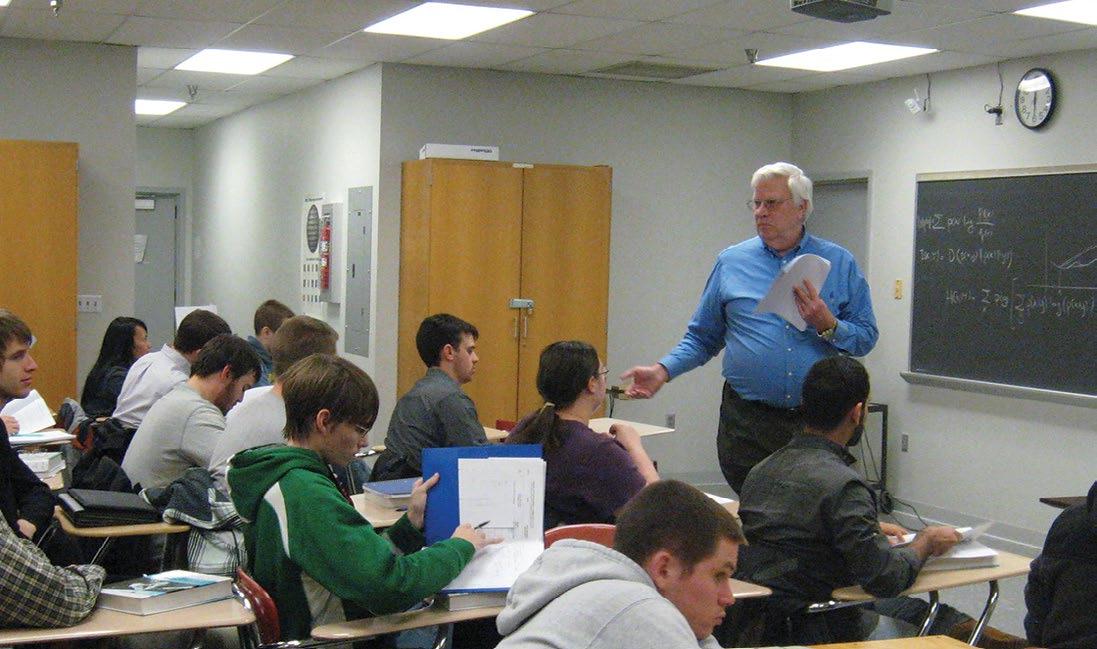
Alexander was a Life Fellow of the IEEE and served as its international president and CEO in 1997. In addition, he held several leadership positions within IEEE during his more than 50 years of service as a volunteer. This includes serving from 1991 to 1999 on the IEEE Board of Directors.
"Charles was my best friend for 46 years starting when I attended a graduate class at Youngstown State University in which he was the professor. He opened many doors of opportunity for my IEEE and Academic careers. Though I am older, Charles was my mentor and because of his influence and personal help, I was able to share his message of the value of balance of technical and non-technical skills, with more than 75,000 students in 203 different universities. That greatly expanded his impact well beyond his classes," said Jim Watson, PE, Communications Consultant for Waskewicz College of Engineering, lecture "ProSkills," former national IEEE speaker, and retired from Ohio Edison.
Dr. Charles Alexander teaching EEC 310 class.Washkewicz College of Engineering was informed of the loss of Taysir H. Nayfeh, Ph.D., who passed away on June 1, 2022, in Cleveland and was interred that weekend in Blacksburg, Virginia. He retired in June 2018 as an associate professor here in the Department of Mechanical Engineering.
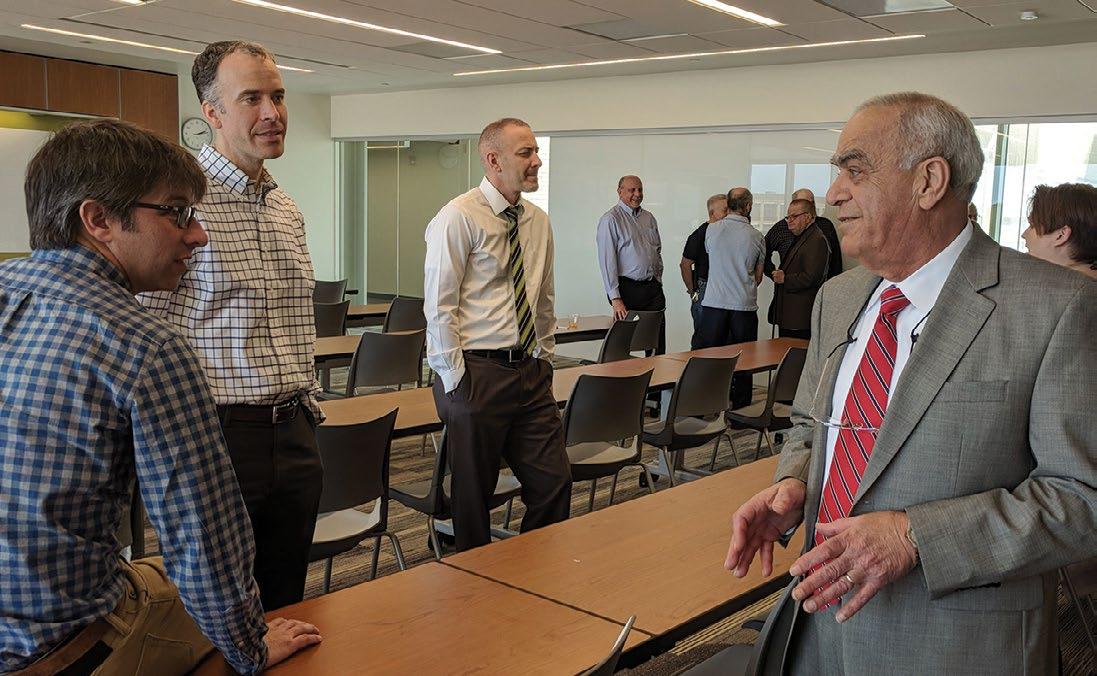

Nayfeh earned his bachelor's, master's and doctoral degrees in Engineering at Virgina Tech, with research concentrations and interests in manufacturing systems, industrial automation, manufacturing process control, sensors and sensor physics, and nondestructive evaluation and testing.
He was published on a wide range of topics including Multi-functional Ultrasonic Sensors for On-line Tool Condition Monitoring, On-line Ultrasonic Tool Chipping Detection During Turning Operations, Calibrated Methods for Ultrasonic On-line Monitoring of Gradual Wear During Turning Operations, Integrated Ultrasonic Sensor for Monitoring Gradual Wear During Turning Operations, An Optical System for Three-dimensional Motion Measurement, and The Fluid Compensated Cement Bond.
Nayfeh taught IME 465/560 Manufacturing Systems Engineering, IME 450/650/654 Industrial Automation and Control and IME 548 Process Sensing and Control.
The Ohio Board of Regents awarded a $600,000 grant to a CSU team led by Nayfeh for ultraconductive copper wire research and development. He created a nanocomposite copper wire more than twice as conductive as pure copper and research suggests the development of ultraconductive copper wire, which could ultimately achieve more than 100 times the conductivity of copper.
This advancement could improve the performance of a wide range of electric machines, dramatically reduce the size and weight of motors and reduce losses in electrical power lines.
“We hope that industries around the world will benefit from our work at Cleveland State University,” Nayfeh said at the time. “When this cost-effective technology is fully developed, it will have the disruptive potential to dramatically improve the performance of virtually all electrical systems and devices, in addition to reducing energy consumption.”
The International Copper Association (ICA), a trade organization representing the copper industry, was a partner in the project. The OBOR grant enabled Nayfeh and his colleagues to develop manufacturing processes for ultraconductive wire and transfer their research into beta products. CSU is at the forefront of ultraconductive copper wire technology, according to the ICA.
Dr. Taysir Neyfeh (2nd from left) at his 2018 retirement party.An interdisciplinary team at Cleveland State University has been awarded a $2 million grant from the National Science Foundation (NSF) for work on Human-Machine Systems for Physical Rehabilitation and research-inspired teaching around assistive technologies for people with disabilities to improve their creation, functionality and retained use.
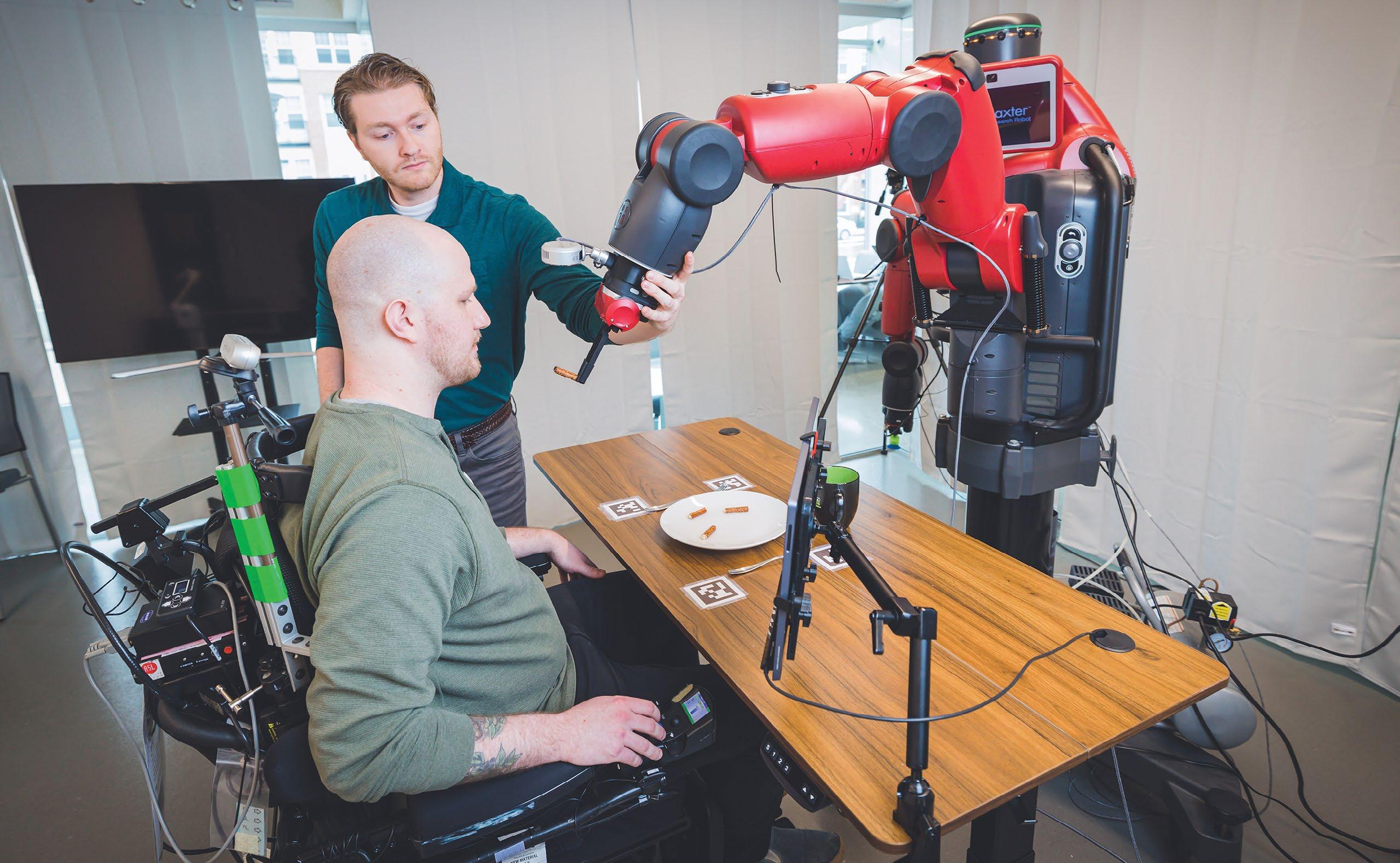
“There is a compelling national need for advanced research to develop technology for people with disabilities,” said Eric M. Schearer, Ph.D., Associate Professor of Mechanical Engineering at CSU’s Washkewicz College of Engineering and the team’s Principal Investigator (PI).
“This technology can help us significantly improve people’s lives—preventing falls, restoring motor function after paralysis and regenerating muscle after traumatic injuries,” Schearer added.
“Despite the development of impressive devices, people with disabilities abandon assistive technologies at alarmingly high rates—largely because their perspectives are not included in the development process.”
Science Foundation funding supports assistive technology to aid people with disabilities
Su, Ph.D.;
Barriers to continued use include privacy concerns, suitability of the technology for daily usage, trust in the devices themselves, stigma surrounding them and a lack of overall training. These can be overcome through better collaboration between developers and potential device users through the NSF Research Traineeship (NRT) program outlined in the grant.
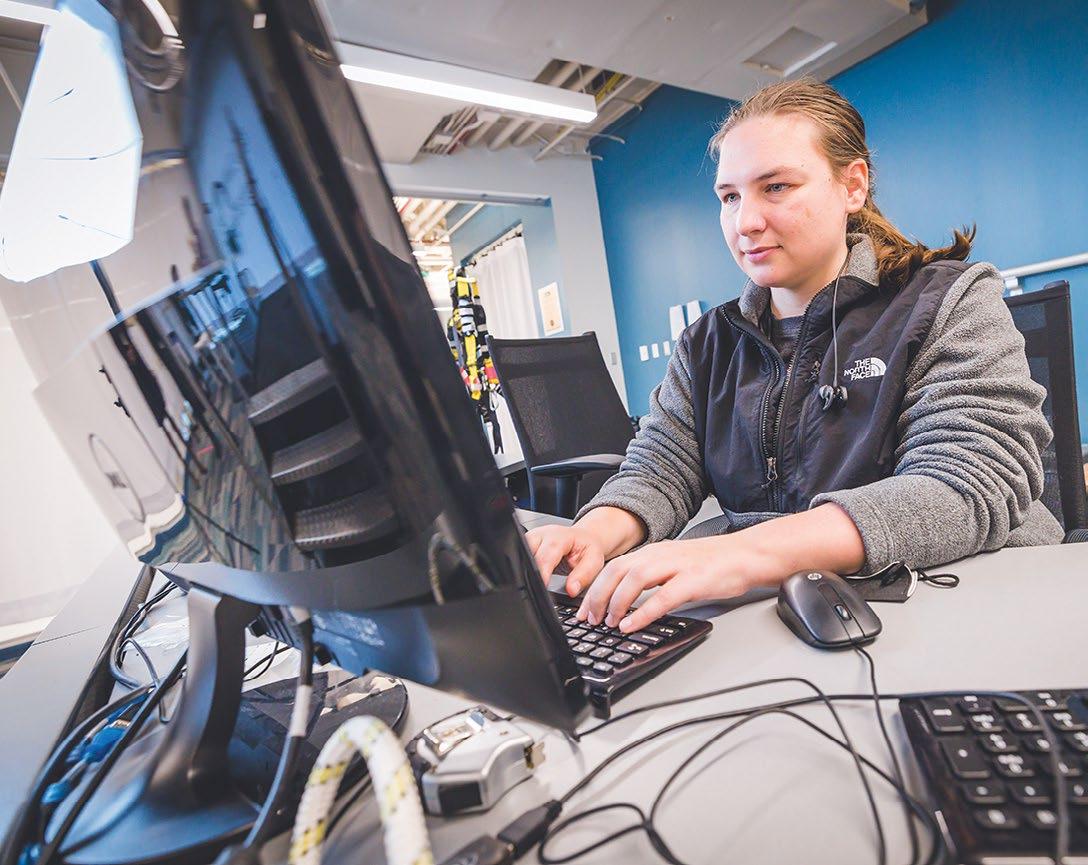
Schearer is one of the team’s 10 core participants, with membership spanning CSU’s mechanical engineering, health sciences, urban studies, biomedical engineering and computer science divisions.
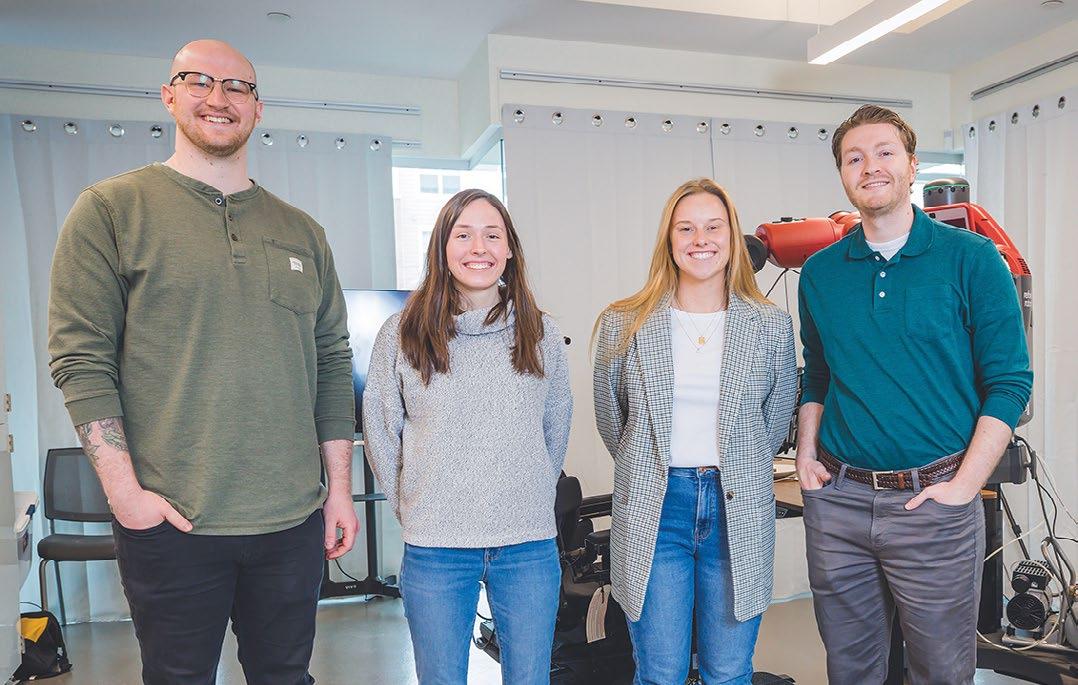
The team is rounded out by Brian Davis, Ph.D.; Debbie Espy, PT, Ph.D.; Kelle DeBoth, Ph.D., OTR/L; Nicholas Zingale, Ph.D.; Prabaha Sikder, Ph.D.; Chandra Kothapalli, Ph.D.; Hanz Richter Ph.D.; Hongkai Yu, Ph.D.; Andrew Slifkin, Ph.D.; Doug Wajda, Ph.D.; Gina Kubek, OTD; April Yorke, Ph.D.; Anne Su, Ph.D.; and Josiah Owusu-Danquah, Ph.D., as well as Gemma Jiang, Ph.D. (Colorado State University).

The long-term vision is for engineers, therapists, psychologists and urban experts to collaborate on physical rehabilitation teams that create technologies empowering people with disabilities—thereby creating more inclusive, cross-functional “wraparound” models around them.
“This [NRT] program seeks to support novel models of interdisciplinary research-based graduate education, with the aim of producing future scholars who can bring together innovative ideas from multiple disciplines to significantly advance convergent scholarly research,” said Nigamanth Sridhar, Ph.D., Provost and Senior Vice President of Academic Affairs at CSU. “This project is a true representation of such a novel model and CSU is incredibly proud to lead on this national stage.”
Front row (left to right): Deborah Espy, PT, Ph.D.; Prababa Sikder, Ph.D.; April Yorke, Ph.D.; Kelle DeBoth Foust, OTR/L, Ph.D.; Hongkai Yu, Ph.D.; Brian Davis, Ph.D., Associate Dean. Back row: Doug Wajda, Ph.D.; Hanz Richter, Ph.D.; Nicholas Zingale, Ph.D.; Eric Schearer, Ph.D.; Gina Kubec, OTD. Not pictured: Josiah Owusu-Danquah, Ph.D.; Chandra Kothapalli, Ph.D.; Anne Gemma Jiang, Ph.D.; Andrew Slifkin, Ph.D.“This project is a true representation of such a novel model and CSU is incredibly proud to lead on this national stage.”
— Nigamanth Sridhar, Ph.D., Provost and Senior Vice President of Academic AffairsDana L. Lorenz, Ph.D. candidate in Applied Biomedical Engineering
Governor Mike DeWine and JobsOhio announced in January 2021 that Cleveland State University would be the lead public higher education partner in an initiative dubbed the Cleveland Innovation District (CID). The CID is a fivemember consortium focused on making Northeast Ohio more attractive to business and more competitive regionally, nationally and globally in the burgeoning health care and IT sectors. The projected economic impact to Cleveland and Ohio is expected to be around $3 billion.
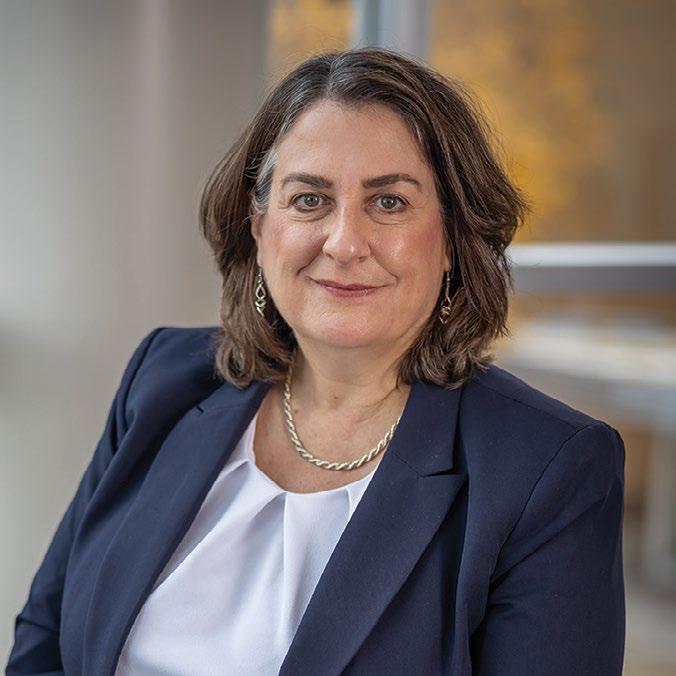

The other consortium members are The Cleveland Clinic, University Hospitals, The MetroHealth System and Case Western Reserve University.
With $20 million from the economic development organization JobsOhio, CSU will educate and graduate 10,000 new students over the next 10 years in the STEM fields of technology, life sciences and data science. Three CSU colleges will play key roles in growing this talent pipeline: the Washkewicz College of Engineering, the Monte Ahuja College of Business and the College of Arts and Sciences.
Across the three colleges, 15 programs are targeted for growth. Five programs are within the College of Engineering: Biomedical Engineering, Chemical Engineering, Computer Engineering, Software Engineering and Data Science (for more information on the College’s new B.S. degree in Data Science, see the story on page 40).
CSU is committed to increasing not only the number of undergraduate and graduate degrees, but also the number of certificates, adult learning opportunities, online courses, and internships and cooperative education opportunities.
As Executive Director of CSU’s involvement in the Cleveland Innovation District, Professor of Chemical and Biomedical Engineering Joanne Belovich, Ph.D. leads a governing body that includes deans or associate deans from the three CSU colleges, along with deans from the Online College and Graduate College, the vice president for Enrollment Services and others.
According to Belovich, demographics are among the biggest challenges CSU faces in fulfilling its pledge to the Cleveland Innovation District. “Northeast Ohio,” she says, “is not growing in population. If anything, the areas we traditionally draw from have declining numbers of graduating high school students. We're doing our best to counteract that trend in these high demand fields.”

Since Belovich was named Executive Director of CSU’s CID effort in June of 2021, her team has notched some impressive results. In the 15 programs targeted for growth, the original goal was a rather aggressive 10 percent increase in fall student enrollment relative to 2019. “We have surpassed that,” Belovich says, “with a 47 percent increase in the targeted programs.” Belovich cites additional gains in the number of certificates and total STEM degrees—which are 13 percent and 11 percent of the way toward the 10-year goal, respectively.
The CSU CID team is working with the Admissions and University Marketing offices to grow enrollments, looking beyond Northeast Ohio to recruit from bordering states and foreign nations. A renewed focus on online programs is helping to capture even more non-traditional students.
Attracting existing businesses to Northeast Ohio and fostering business startups will also spur growth—and part of that, says Belovich, is “providing the talented workforce. That’s where CSU comes in.” To learn more visit: engineering.csuohio.edu/cleveland-innovation-district
Angela Benton-Smith, Program Manager for Engineering Diversity for the College of Engineering, received $152,679 for the period of August 1, 2022 through July 31, 2024, for the project “Advancement and Retention of Women Engineering Students at CSU” from the Cleveland Foundation, Fenn Educational Fund. The focus of the project will be to recruit, retain, place in co-ops and graduate more women engineering students. The goal is to increase women engineering students by 10 percent.

Zicheng Chi, Ph.D.
Zicheng Chi, Assistant Professor in the Electrical Engineering and Computer Science Department, has received $349,999 from the National Science Foundation (NSF) for the collaborative research project, “SWIFT: Effective Spectrum Coexistence among Active, Semi-passive, and Passive Internet of Things (IoT) Devices.” The use of IoT devices in many applications has been increasing exponentially. This project will create a frequency agnostic backscatter system that can operate across different protocols (e.g., LTE, WiFi, ZigBee) and frequency bands, and enrich the scientific knowledge of wireless networking and mobile computing. This research can effectively address the challenges of spectrum utilization in the IoT networks with coexisting active and passive radios.
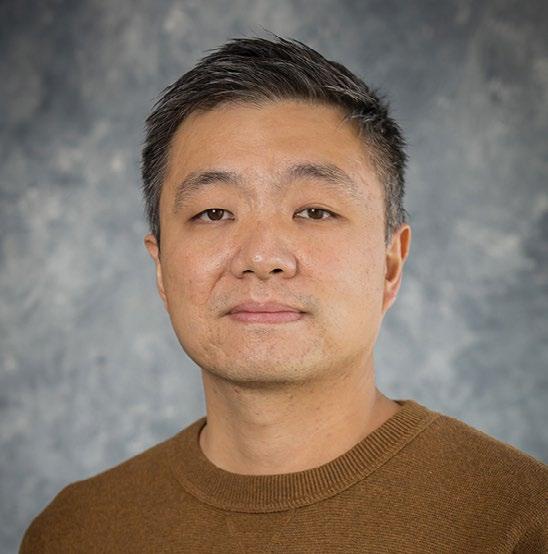
Sathish Kumar, Ph.D.

Sathish Kumar, Associate Professor in the Electrical Engineering and Computer Science Department, received $799,985 from the National Science Foundation (NSF) for the project, “Expand QISE: Track 1: RLQSC: Reinforcement Learning for the Optimal Design of Programmable Quantum Sensor Circuit.” This project aims to create and evaluate quantum and classical reinforcement learning-based agents for the optimal design of programmable quantum sensor circuit. Quantum sensing is a mature technology that has achieved remarkable progress over the past decades. The specific objective is to create and evaluate quantum and classical reinforcement learningbased agents to design the deep circuit.
HongKai Yu, Assistant Professor in the Electrical Engineering and Computer Science Department, was awarded $434,431 from the National Science Foundation (NSF) for the project titled, “MRI: Acquisition of a GPU-based High Performance Computing Instrumentation for Smart City Research.” This project’s research goal is to transform Cleveland to a modern smart city with shorter commute times (even during rush hour), ultra-low crime rate, a highly robust and secure electric power grid, and successful professional sports teams contending for championships.

Wei Zhang, Associate Professor in Mechanical Engineering, was awarded a National Science Foundation (NSF) grant of $400,018 for the project titled, “The Great Lakes Wind REU.” REU students will be exposed to a summer research experience that consists of: participation in ongoing wind energy research in inclusive learning and research communities, weekly seminars of research frontier and professional development, field visit of a utility-scale wind turbine site at the Great Lakes Energy Institute, and (iv) research communication/dissemination in workshops and conferences. This project is jointly funded by the NSF, Division of Engineering Education and Centers (EEC) and the Department of Energy (DOE), National Energy Technology Laboratory (NETL).
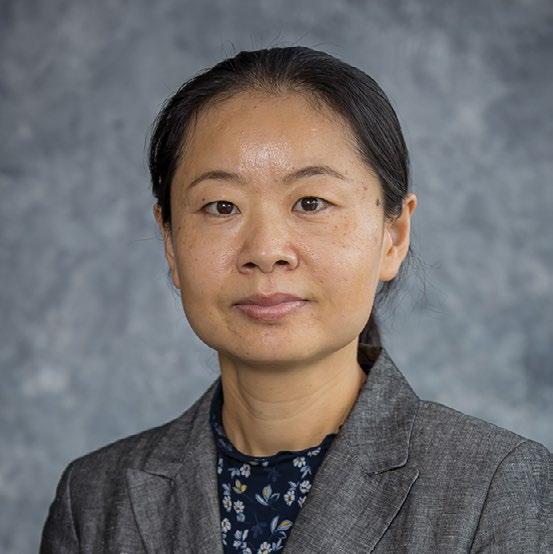
Nolan Holland, Ph.D., Chair and Professor of the Chemical and Biomedical Engineering Department, received $217,000, totaling $1.2 million for the five-year grant period 2022–2027, as part of the renewed grant from Choose Ohio First for the “Viking Workforce of Tomorrow” project. This grant supports approximately 24 new students each year (for a total of approximately 120 different students) from a diverse cadre of undergraduates, especially underrepresented students who are pursuing a variety of STEM majors.
Yong Tao, Ph.D., the Betty L. Gordon Endowed Chair and Distinguished Professor and Chair of the Department of Mechanical Engineering, received $256,885 as part of a $1.2 million grant renewed from the U.S. Department of Energy for a research project entitled, “Advanced District Energy Controls for Improved Efficiency and Resilience.” The goal of the project is to investigate the advanced system control strategies that would increase the district and city-level system efficiency for more cost-effective ways of providing heat and cooling to building customers.
Jack Perish was the Fall 2022 Washkewicz College of Engineering Valedictorian, graduating with a Bachelor of Science in Computer Science and a 3.94 GPA. Perish was on the Dean’s List for six semesters and the President’s List for four semesters and is a grateful recipient of many scholarships, including Choose Ohio First, Provost Scholarship and Steris Scholarship.
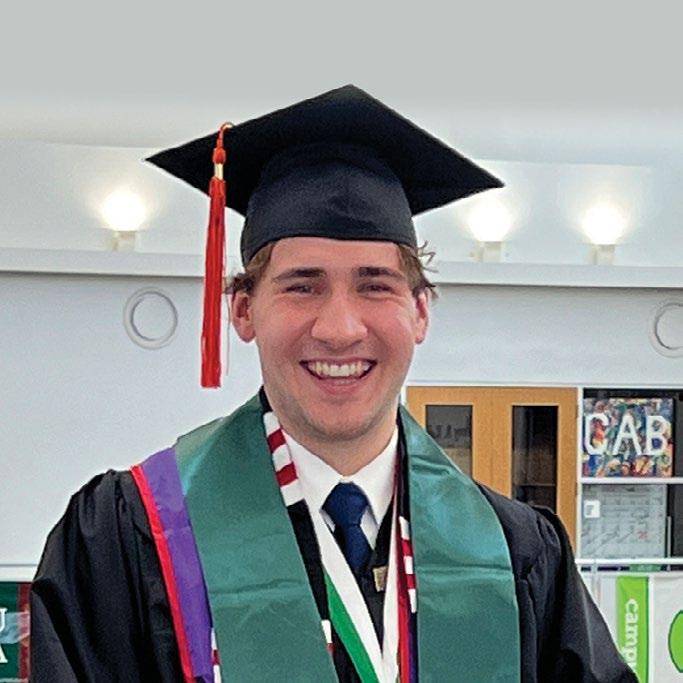
As a student, Perish worked as a summer research assistant, and held internships at Medical Mutual, CHAMPtitles and Lyft. He is a member of Sigma Phi Epsilon, lead their fraternity as Philanthropy Chair and received their Sophomore Academic Achievement Award and Brother of the Week. He has been involved with the Association of Computing and Machinery, TRIO and Institute of Electrical and Electronics Engineering (IEEE). Somehow, he also found time to volunteer with numerous organizations. While doing all this, Perish completed undergraduate and graduate courses as a third-year student and was on the team that placed first in a coding competition.
I plan to start a full-time position as a software developer at CHAMPtitles, a local startup company that aims to digitize car titling with blockchain technology.
Beyond this, I hope to continue learning and growing as a person and as a software engineer. Ultimately, I would like to continue my technical growth to a staff engineer level and then aim to transition to a managerial position to facilitate more growth in my team and company. Of course, this may all change as my career progresses, but I am excited to see what is next. I know I will be well-equipped given the knowledge and mentorship I obtained at CSU.
Favorite course: MTH 182 or REL 101 Hardest course: MTH 220 (Remote)
My Trio advisor, Jason Gardner told me to “never leave a classroom with an unanswered question.” This advice helped me immensely in the first few years at CSU. Not only did it help me academically in understanding the material, but it also led to better relationships with my professors, making it easier to revisit them in the future with questions or ideas.
Set goals, be committed, be flexible and have fun! If you really want to achieve something, you first must know what it is, but secondly, you must work hard to achieve it. Nonetheless, you also need a bit of luck, and things can often throw a wrench in your plans. For example, the pandemic! When things happen, you have to be flexible and adapt, but don't forget to have fun along the way. Life is short and perspective makes all the difference.
IF YOU HAD TO DO IT ALL OVER AGAIN, WHAT WOULD YOU DO DIFFERENTLY AS IT RELATES TO YOUR ACADEMIC JOURNEY?
It’s difficult to say what I would change. I am so thankful for all the people I have met, the experiences I have had and the lessons I have learned at CSU. One thing I would have liked to be more aware of is my mental health and what affects it. School can take time away from things that help you be you, and although in the short-term, skipping a workout or a soccer match may save time, in the long run it may hurt you to lose that social or activity outlet.
I’m excited to see what is next. I know I will be wellequipped given the knowledge and mentorship I obtained at CSU.
is Excited to See What’s Next
WE ARE GRATEFUL TO YOU the 558 donors who gave $1,064,337 in gifts and pledges to the Washkewicz College of Engineering during the Fiscal Year 2022 (July 1, 2021–June 30, 2022).
Your generous support allows the college to continue providing a high-quality, affordable, experiential engineering education, along with innovative programming that helps our students succeed and explore what is possible.
The list below gratefully acknowledges gifts and pledges of $500 or more from our alumni, friends, corporations and foundations to the college during the period of July 1, 2021–June 30, 2022.
$100,00–$249,000
Hyland Software, Inc.
Robert W. Lyczkowski, Ph.D., PE
$25,000–$99,999
Anonymous
LaMantia Family Foundation
Patricia Mintz, Ph.D. and Mr. Charles J. Mintz
Parker Hannifin Corporation
Precision Environmental Company
Mr. John Skubiak*
R. E. Warner & Associates, Inc.
$10,000–$24,999
Chia Fan Foundation
Dominion Energy Lubrizol
Mrs. Lois E. McFarland
Mr. and Mrs. John E. Trendell
$5,000–$9,999
Cleveland Foundation
Custom Rubber Corp.
Goodyear Tire & Rubber Company
James and Margaret Heckelman Mr. Brian J. Moran
NASA Glenn Research Center National Safety Apparel OAI
Mr. and Mrs. George J. Palko SIFCO Industries
Michael and Amy Sturdevant
$2,500–$4,999
Arizona State University De Nora Tech, Inc.
Mr. Michael B. Haynie Mr. Ward L. Kinney
Mr. Daniel John Lee Municipal Engineers Association of Northeast Ohio
Nexus Engineering Group, LLC Paragon Tec, Inc.
Safran Electrical & Power
Robert Y. and Anna B. Simek Endowment
Mark Edward Stahl, Ph.D.
Mr. and Mrs. John William Struble III
$1,000–$2,499
Ms. Cheri Banks
Anjali Barnick, Ph.D. Mr. John W. Beadle
Bendix Commercial Vehicle Systems, LLC
Ms. Margaret A. Benham and Mr. Jeffrey R. Gwinnell
The Biomechanics Initiative, Inc.
Mr. and Mrs. Ronald C. Cull Mr. Robert J. Demchak
Mr. Zhan Ding
Mr. James J. Durr
EMX Industries, Inc.
Entrepreneurial Engagement Ohio
Mr. Timothy Patrick Esson
Mr. Michael S. Galgoczy
Google, Inc.
Mr. George C. Hadden
Mr. and Mrs. Frank D. Jankowski Mr. Richard J. Jeschelnig
Ms. Stephanie Melnyk Microsoft Foundation
Mr. Ryan Joseph O'Hearn
Carl M. Panasik, Ph.D.
Mr. Christopher J. Pestak
Rockwell Automation, Inc.
Mr. William C. Rowles
Mr. Richard J. Saccany
Thomas M. and Helen M. Sopko
Mr. Vivek Shivananda
Texas Instruments Foundation
Mr. and Mrs. Gordon P. Wetzel
Mr. and Mrs. Ray F. Zucker, Jr. Mr. Terrence V. and Mary K. Zuk
Mr. Jeffrey H. Ahrens
Anonymous
Mr. Robert A. Bauer
Mrs. Eleanor Moore Brown
Mr. and Mrs. Richard L. Bowen
Mr. Anatole Cisan, Jr. Mr. Paul E. Gerber
Mr. and Mrs. David W. Guinther Mr. George R. Harpster*
Ms. Victoria L. Hoover Mr. Richard J. Iafelice
Innovative Sports Training, Inc. Mr. Charles I. Jeon
Mr. Michael L. Kocevar
Mr. and Mrs. John N. Lightfoot
Mr. Robert Paul Nadin
Mr. Seela Ramesh
Mr. James F. Reagan
Mr. and Mrs. Richard J. Schindler, PE
Mrs. Marilyn P. Schroeder
Mr. Anthony Siracusa
Mr. Wayne S. Stanko
Mr. Jeremy William Weaver
Timothy A. Wolfe, Ph.D. Weidong Xiong, Ph.D.
WASHKEWICZ COLLEGE OF ENGINEERING 2121 Euclid Avenue, WH 305 Cleveland, Ohio 44115-2214
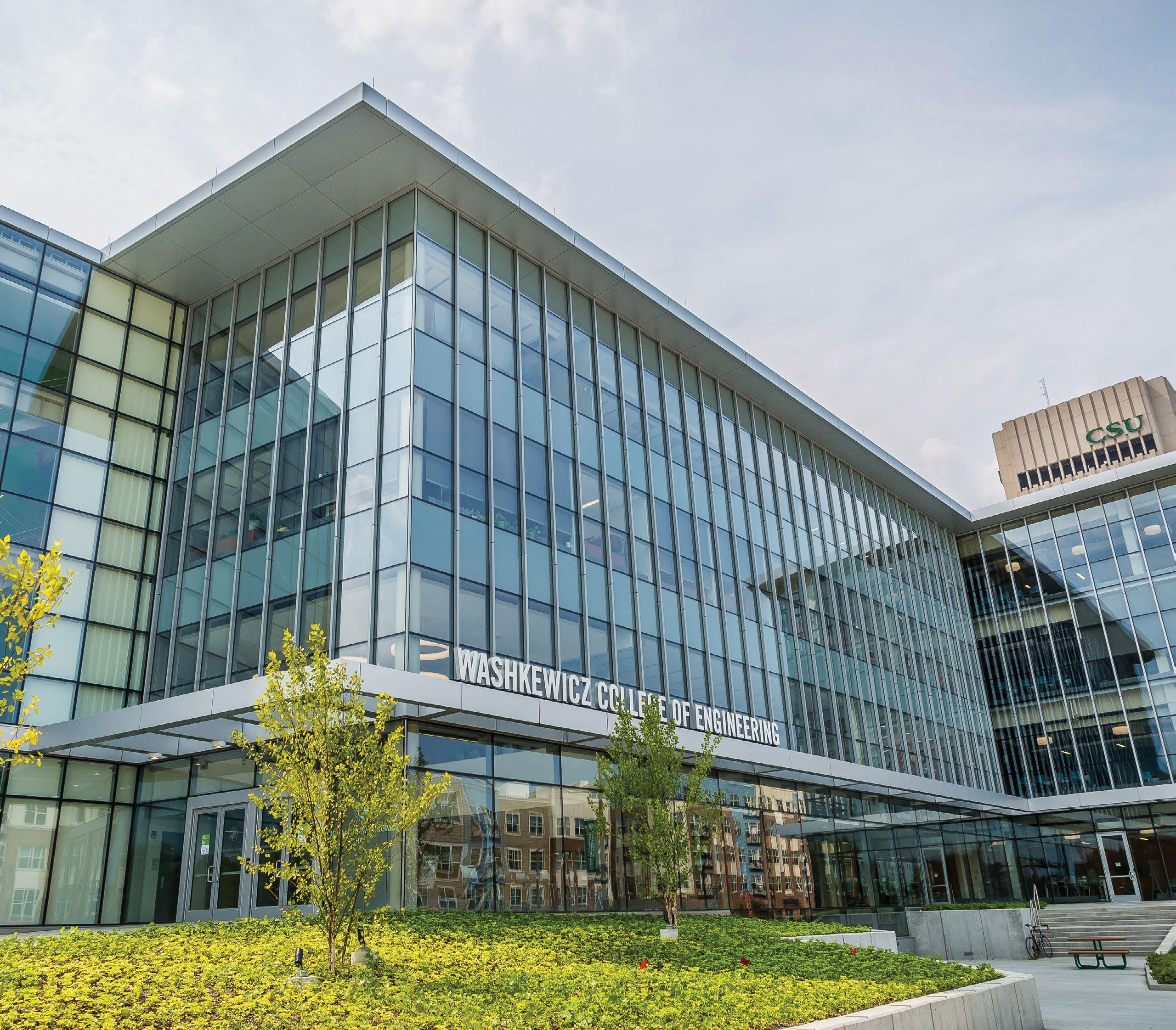 CHANGE SERVICE REQUESTED
CHANGE SERVICE REQUESTED